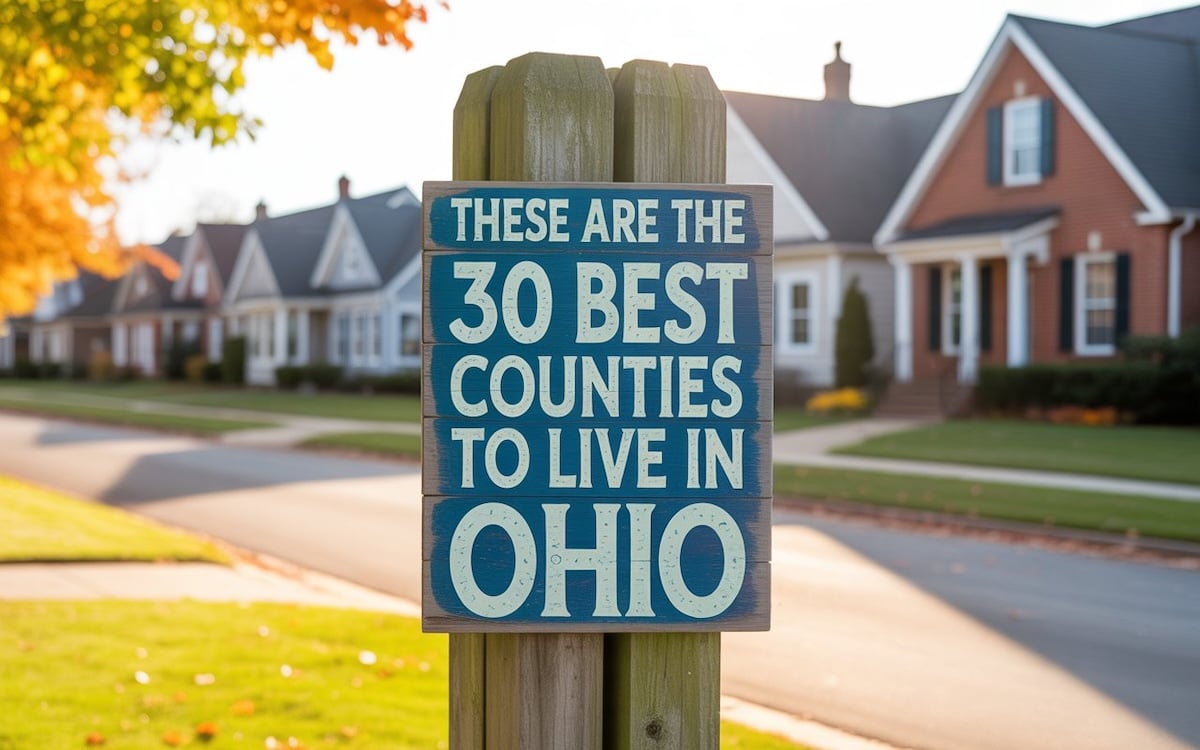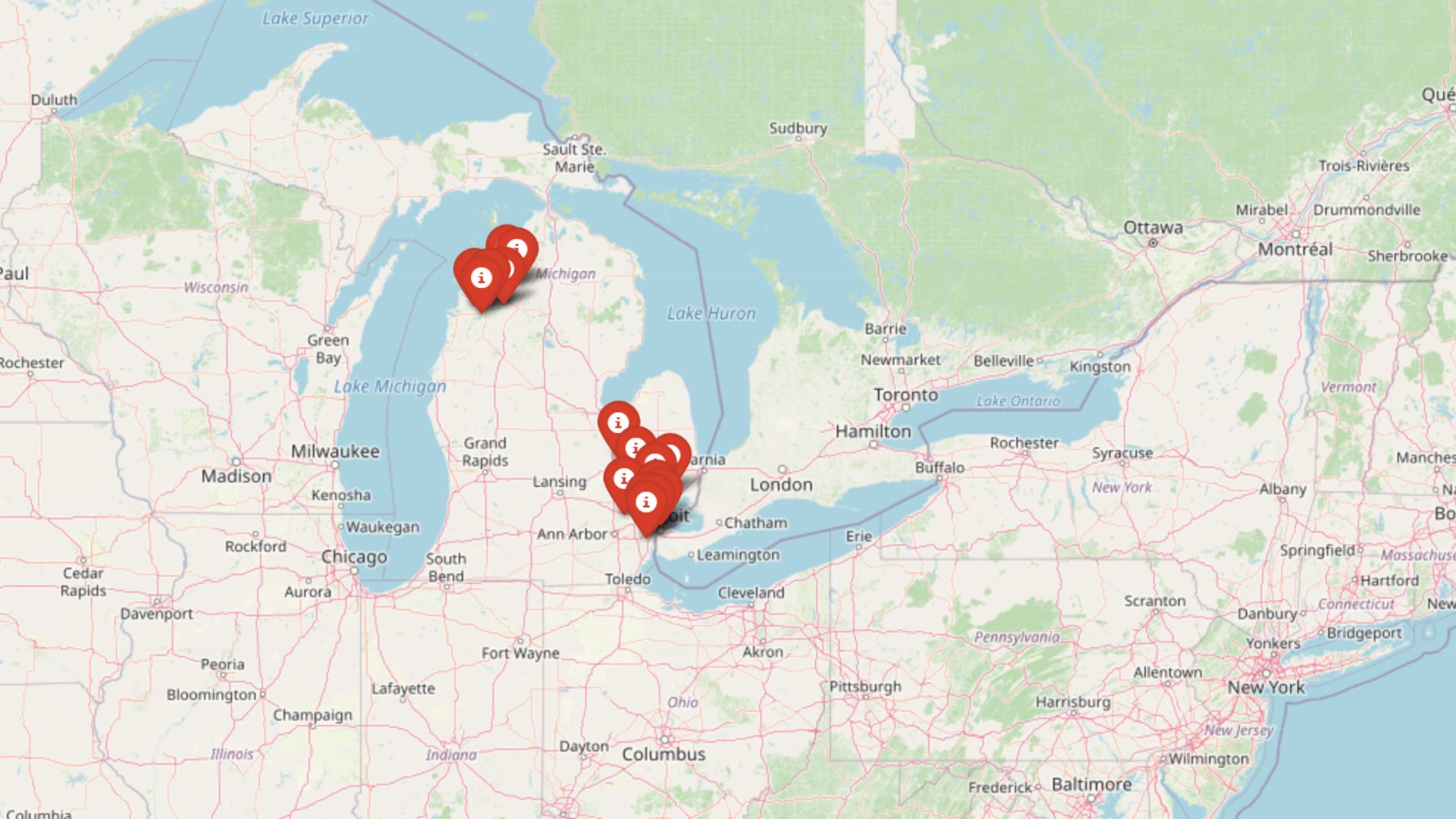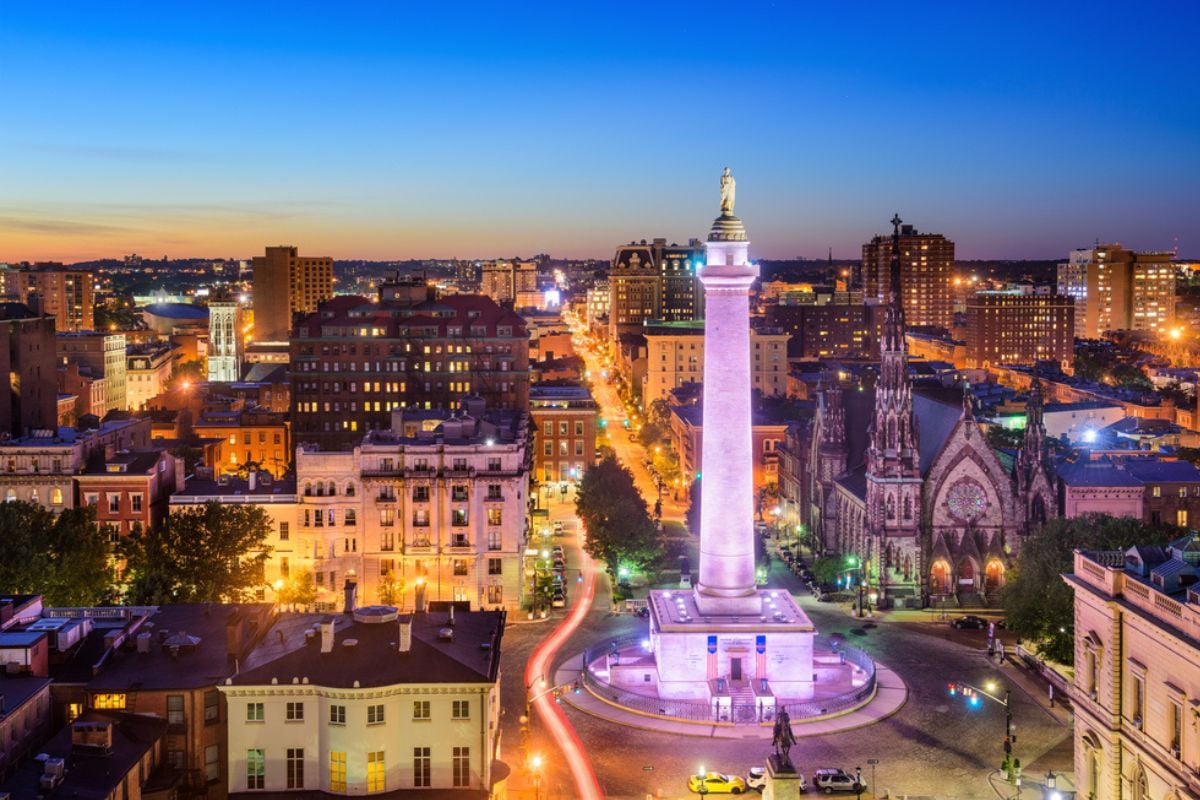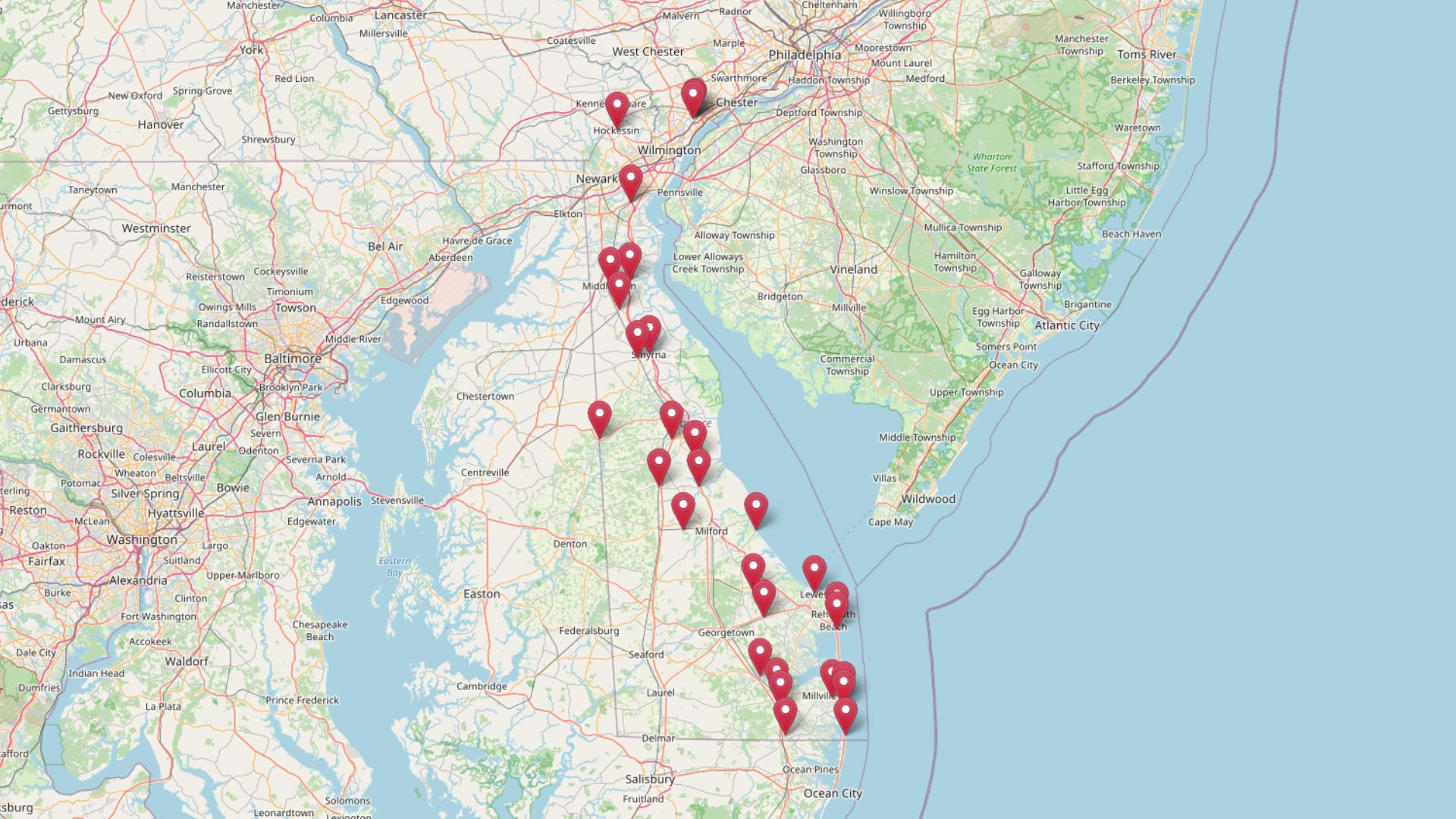
Using the latest Zillow Home Value Index data from July 2025, we’ve ranked the 30 most expensive towns in Delaware based on current home prices. These communities represent the pinnacle of First State real estate, where coastal charm meets premium pricing and where steady growth has created some of the most valuable residential markets on the East Coast.
From oceanfront enclaves commanding over $1 million to upscale suburbs approaching the $600,000 mark, each town tells a story of remarkable appreciation and enduring appeal. Whether you’re tracking market trends, considering an investment, or simply curious about Delaware’s priciest communities, this comprehensive breakdown reveals where values peak and what drives these premium prices.
30. Marydel – 113.4% Home Price Increase Since 2012
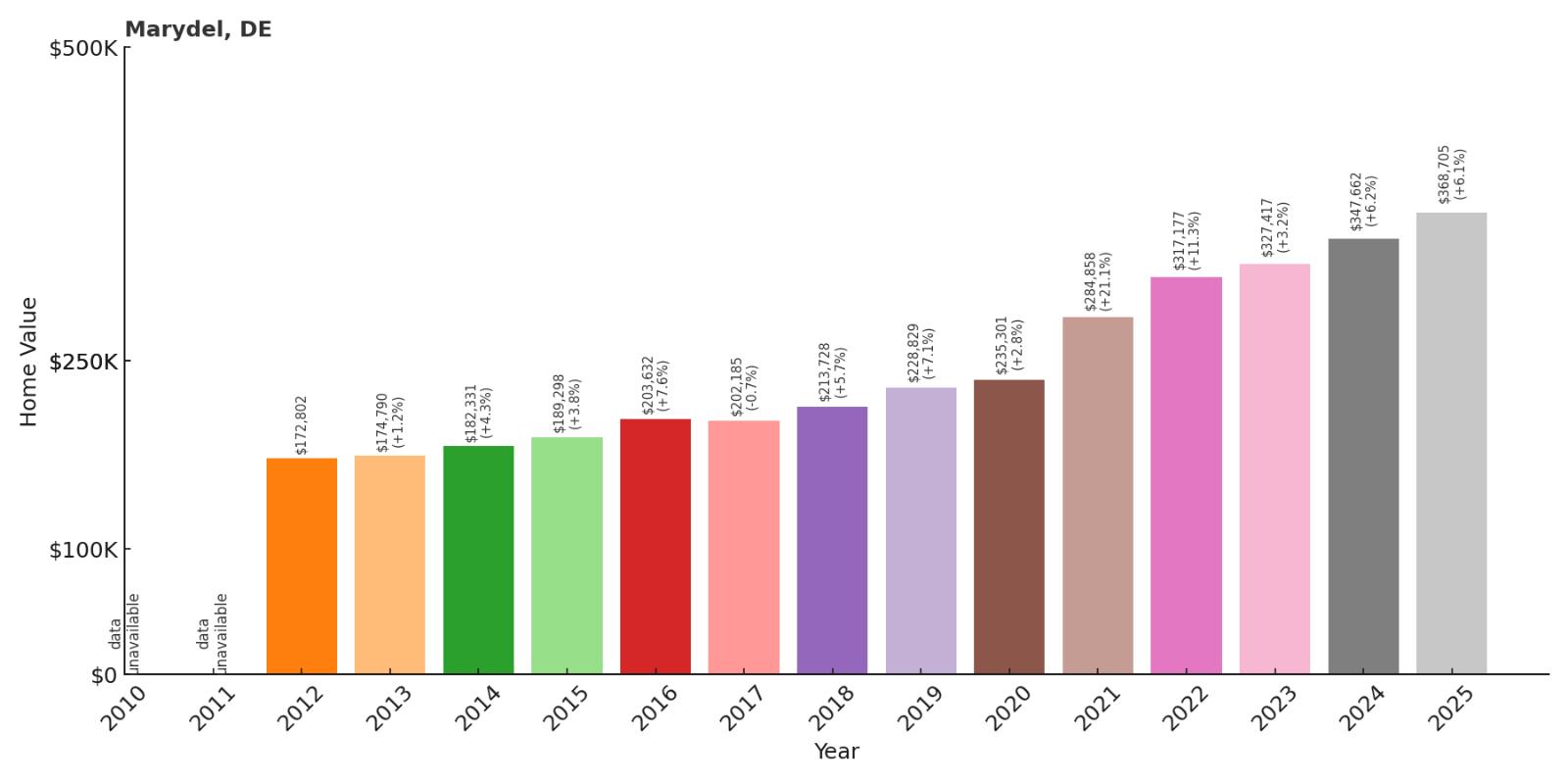
- 2010: N/A
- 2011: N/A
- 2012: $172,802
- 2013: $174,790
- 2014: $182,331
- 2015: $189,298
- 2016: $203,632
- 2017: $202,185
- 2018: $213,728
- 2019: $228,829
- 2020: $235,301
- 2021: $284,858
- 2022: $317,177
- 2023: $327,417
- 2024: $347,662
- 2025: $368,705
Marydel has shown impressive resilience since 2012, more than doubling home values over the past 13 years. The most dramatic surge occurred during the pandemic years, with prices jumping 21% in 2021 alone. By July 2025, median home prices reached $368,705, marking this border town as an increasingly valuable real estate market.
Why Marydel?
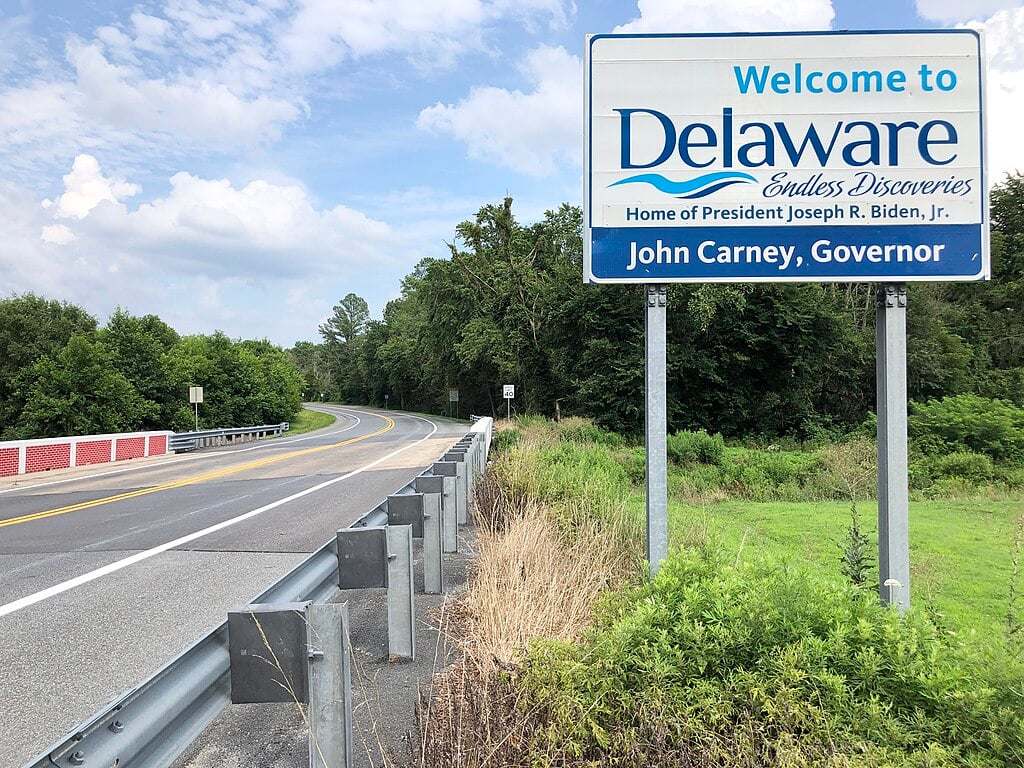
Famartin, CC BY-SA 4.0, via Wikimedia Commons
Why are people willing to pay so much to live here? What’s special about it?
Marydel’s unique position straddling the Delaware-Maryland border offers residents the best of both states while maintaining small-town charm. Families appreciate the rural atmosphere, larger lots, and strong sense of community that comes with a population under 1,500. The town provides easy access to both Dover and Baltimore, making it attractive to commuters seeking affordable housing with convenient transportation links.
Unlike many rapidly growing areas, Marydel has managed to preserve its agricultural character while welcoming new residential development. The combination of lower property taxes compared to nearby Maryland communities and Delaware’s business-friendly environment adds significant appeal for both families and retirees seeking value.
How Marydel Rose to Prominence
Marydel was incorporated in 1905 as a planned community built around the railroad, with its name literally combining “Mary” for Maryland and “Del” for Delaware. Originally designed as a temperance town with strict alcohol prohibitions, Marydel served as a shipping point for local agricultural products throughout the early 20th century.
The town’s prominence grew as suburban sprawl from both Baltimore and Dover reached the area, transforming Marydel from a quiet farming community into a desirable residential destination. Its strategic location along major transportation corridors, combined with abundant land for development, positioned Marydel perfectly for the housing boom of the 2000s and beyond.
3 Interesting Tidbits
1. Two-State Town – Marydel is one of the few incorporated towns that literally sits in two states, with Main Street serving as the Delaware-Maryland border.
2. Temperance Legacy – The town was founded as a “dry” community where alcohol sales were prohibited, a restriction that lasted for decades after incorporation.
3. Railroad Heritage – The original Pennsylvania Railroad depot still stands as a reminder of Marydel’s origins as a agricultural shipping hub and planned railroad community.
29. Frederica – 99% Home Price Increase Since 2010
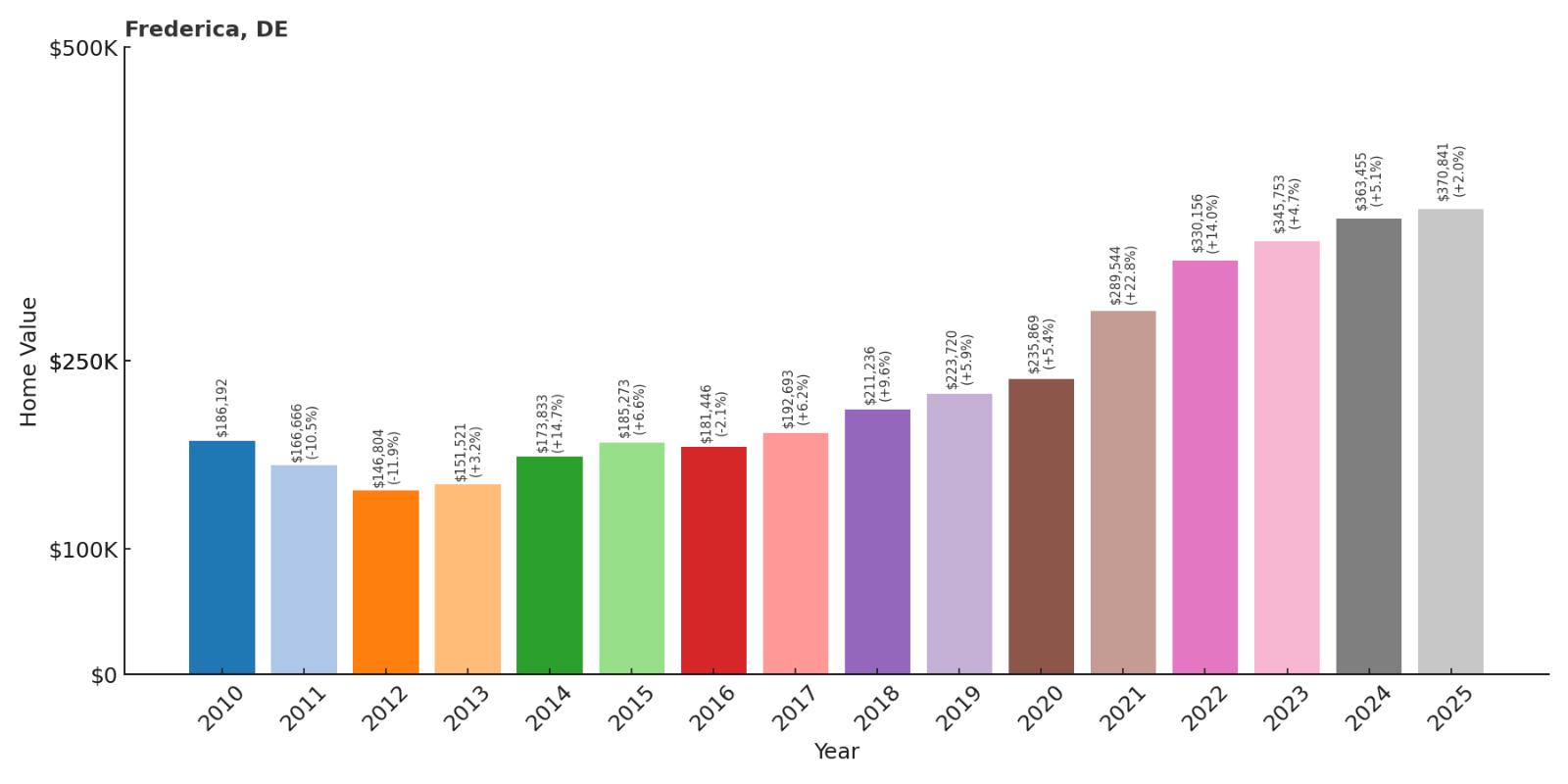
- 2010: $186,192
- 2011: $166,666
- 2012: $146,804
- 2013: $151,521
- 2014: $173,833
- 2015: $185,273
- 2016: $181,446
- 2017: $192,693
- 2018: $211,236
- 2019: $223,720
- 2020: $235,869
- 2021: $289,544
- 2022: $330,156
- 2023: $345,753
- 2024: $363,455
- 2025: $370,841
Frederica weathered the post-recession housing downturn better than many markets, bouncing back strongly after 2013. The town has nearly doubled in value since 2010, with particularly strong gains during the pandemic era. Current median prices of $370,841 reflect steady demand for this historic Kent County community.
Why Frederica?
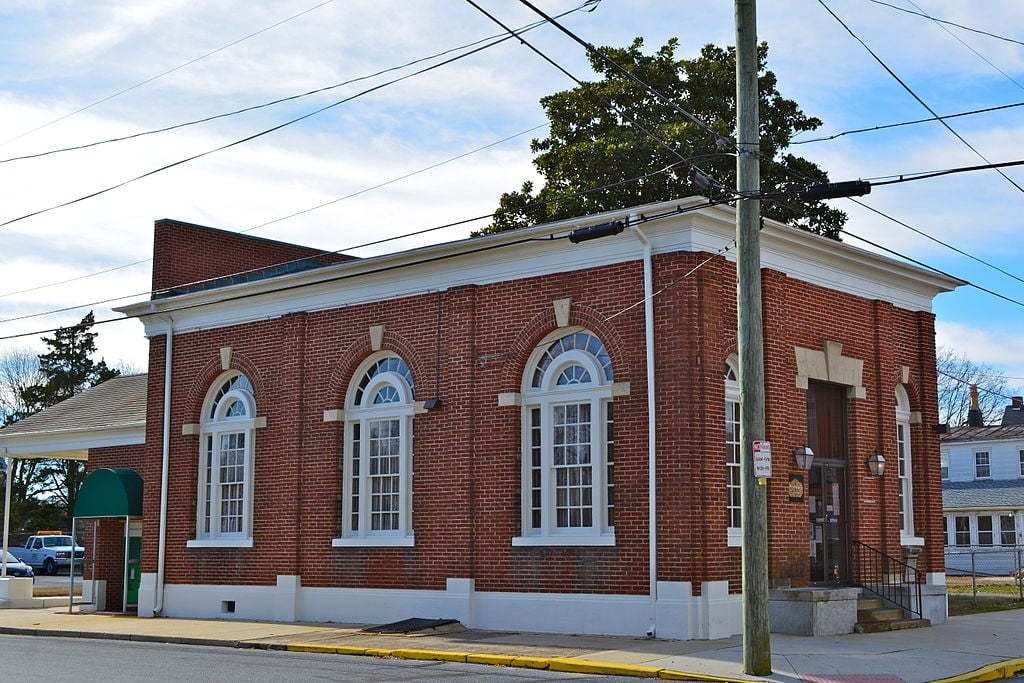
Why are people willing to pay so much to live here? What’s special about it?
Frederica offers a rare combination of historic charm and modern convenience that appeals to families and retirees alike. The town’s well-preserved colonial architecture and tree-lined streets create an authentic small-town atmosphere that’s increasingly hard to find. Residents value the strong community spirit, excellent schools, and easy access to both Dover and the Delaware beaches.
The town’s location along the Murderkill River provides scenic beauty and recreational opportunities, while its proximity to major highways ensures convenient commuting to Wilmington, Dover, or even the Baltimore-Washington corridor. Frederica’s careful growth management has preserved its character while accommodating new families seeking quality of life.
How Frederica Rose to Prominence
Founded in 1769 and named after Frederick, Prince of Wales, Frederica served as Kent County’s original county seat until 1791. The town played a significant role in Delaware’s colonial and revolutionary history, with many original 18th-century buildings still standing today.
Frederica’s modern prominence emerged as Dover’s suburban growth reached southward, and families began seeking alternatives to more expensive New Castle County communities. The town’s historic designation and architectural preservation efforts attracted residents who wanted both character and investment potential in their homes.
3 Interesting Tidbits
1. Former County Seat – Frederica served as Kent County’s government center for over 20 years during the late 1700s, before losing the designation to Dover.
2. Revolutionary Roots – The town hosted important colonial meetings and several buildings served as safe houses during the American Revolution.
3. Murderkill Mystery – The nearby Murderkill River’s ominous name actually comes from the Dutch “Moeder Kill,” meaning “Mother Creek,” with no sinister origins despite local legends.
28. Odessa – 69% Home Price Increase Since 2010
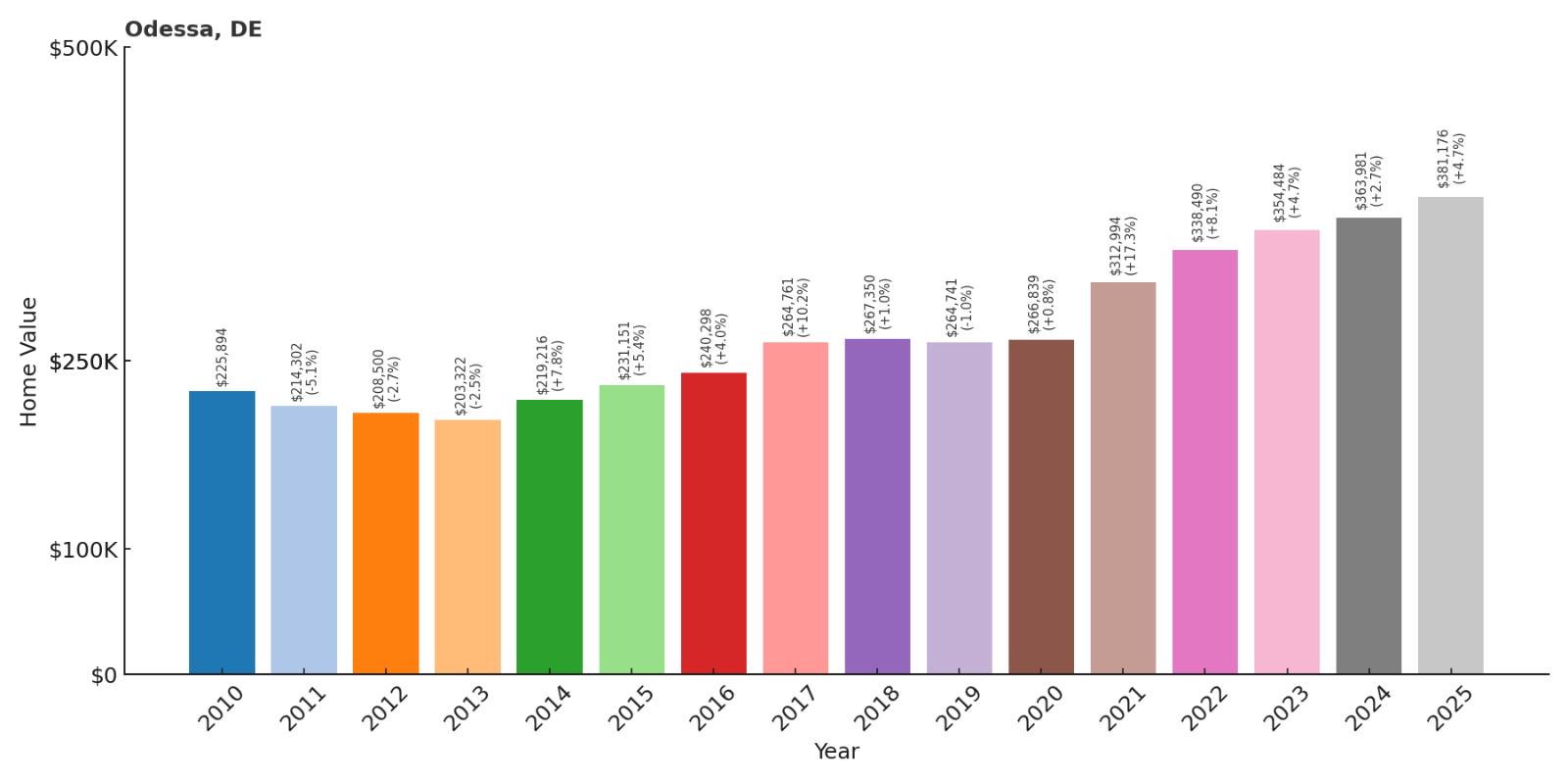
- 2010: $225,894
- 2011: $214,302
- 2012: $208,500
- 2013: $203,322
- 2014: $219,216
- 2015: $231,151
- 2016: $240,298
- 2017: $264,761
- 2018: $267,350
- 2019: $264,741
- 2020: $266,839
- 2021: $312,994
- 2022: $338,490
- 2023: $354,484
- 2024: $363,981
- 2025: $381,176
Odessa has demonstrated steady appreciation over the past 15 years, gaining nearly 69% since 2010. The town experienced measured growth through the 2010s before accelerating during the pandemic years. With median home prices now at $381,176, Odessa represents solid value in New Castle County’s more affordable communities.
Why Odessa?
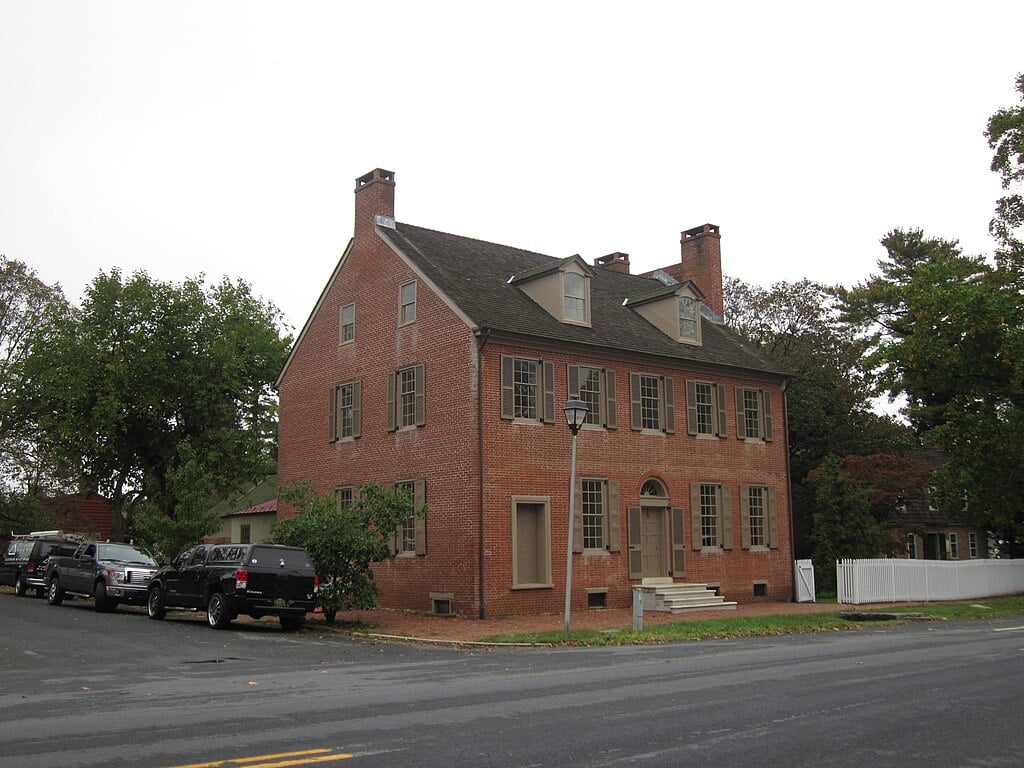
Why are people willing to pay so much to live here? What’s special about it?
Odessa’s appeal lies in its remarkable collection of 18th and 19th-century architecture, making it one of Delaware’s most historically significant communities. Families are drawn to the town’s excellent schools, walkable historic district, and strong community traditions that include annual festivals and preservation efforts. The Appoquinimink Creek provides scenic beauty and recreational opportunities right in town.
Unlike many suburban developments, Odessa offers authentic historic character with modern amenities and convenience to major employment centers. Residents appreciate being able to walk to shops, restaurants, and community events while maintaining easy access to Wilmington, Dover, and even Philadelphia via nearby transportation corridors.
How Odessa Rose to Prominence
Originally known as Cantwell’s Bridge, Odessa was a major grain shipping port during the colonial era, serving as a vital link between Pennsylvania farms and Chesapeake Bay markets. The town was renamed Odessa in 1855, supposedly after the Ukrainian port city due to similarities in their grain trade.
Odessa’s prominence as a historic preservation showcase began in the 1960s when the Winterthur Museum acquired and restored many of the town’s colonial buildings. This preservation effort, combined with its listing on the National Register of Historic Places, established Odessa as a unique residential destination that balances history with modern living.
3 Interesting Tidbits
1. Museum Town – Several historic houses in Odessa operate as museums under Winterthur’s management, making the entire town feel like a living history exhibit.
2. Grain Port Heritage – The town’s wealth in the 1700s and 1800s came from shipping Pennsylvania grain down the Appoquinimink Creek to larger ports on the Delaware River.
3. Ukrainian Connection – The name change from Cantwell’s Bridge to Odessa in 1855 celebrated the town’s role as a grain port, similar to its Ukrainian namesake on the Black Sea.
27. Houston – 83% Home Price Increase Since 2010
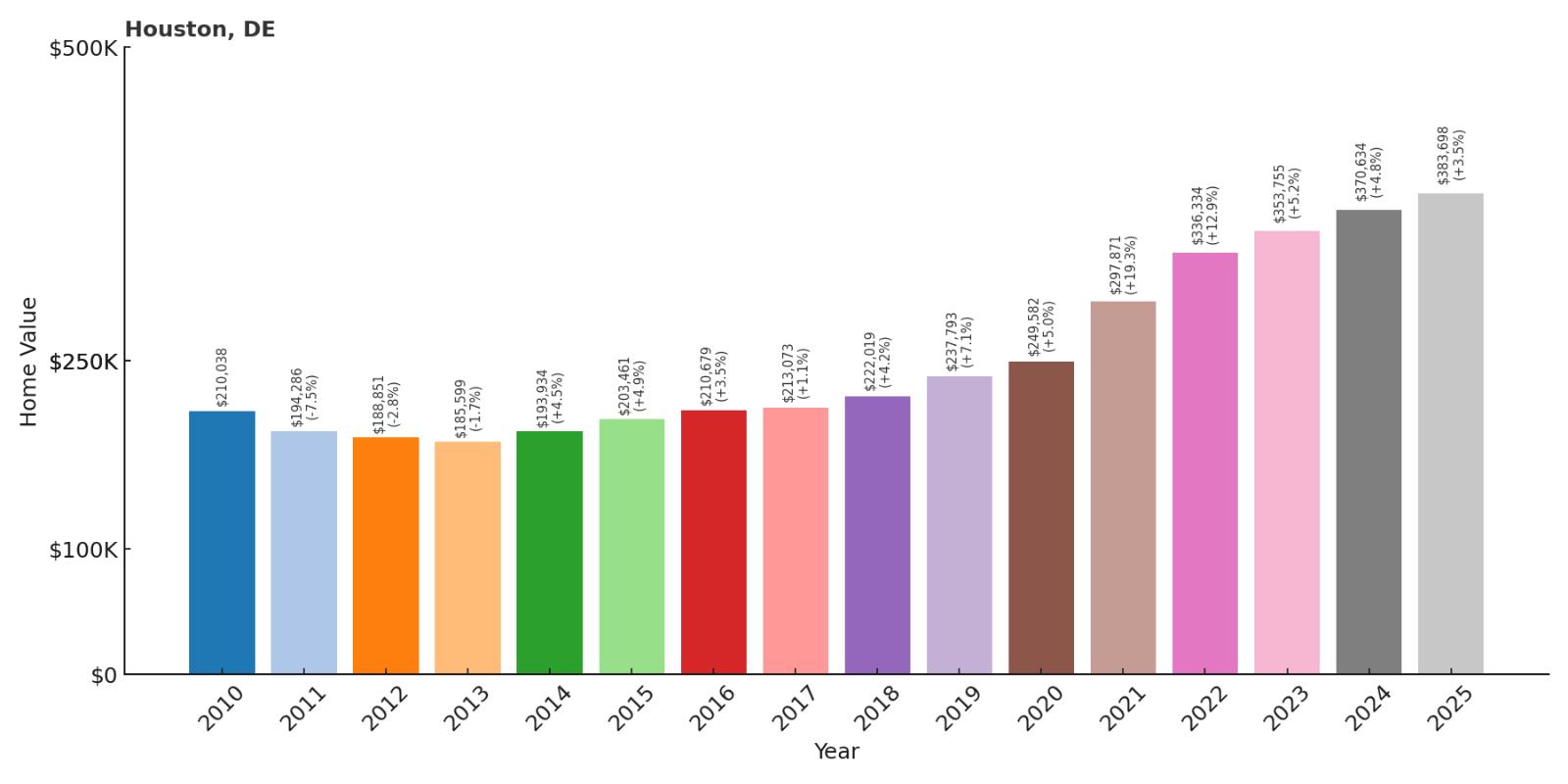
- 2010: $210,038
- 2011: $194,286
- 2012: $188,851
- 2013: $185,599
- 2014: $193,934
- 2015: $203,461
- 2016: $210,679
- 2017: $213,073
- 2018: $222,019
- 2019: $237,793
- 2020: $249,582
- 2021: $297,871
- 2022: $336,334
- 2023: $353,755
- 2024: $370,634
- 2025: $383,698
Houston has shown impressive growth since recovering from the post-recession lows of 2013. The community has gained 83% in value over 15 years, with particularly strong appreciation during the pandemic era. Current median prices of $383,698 reflect growing demand for this Kent County community.
Why Houston?
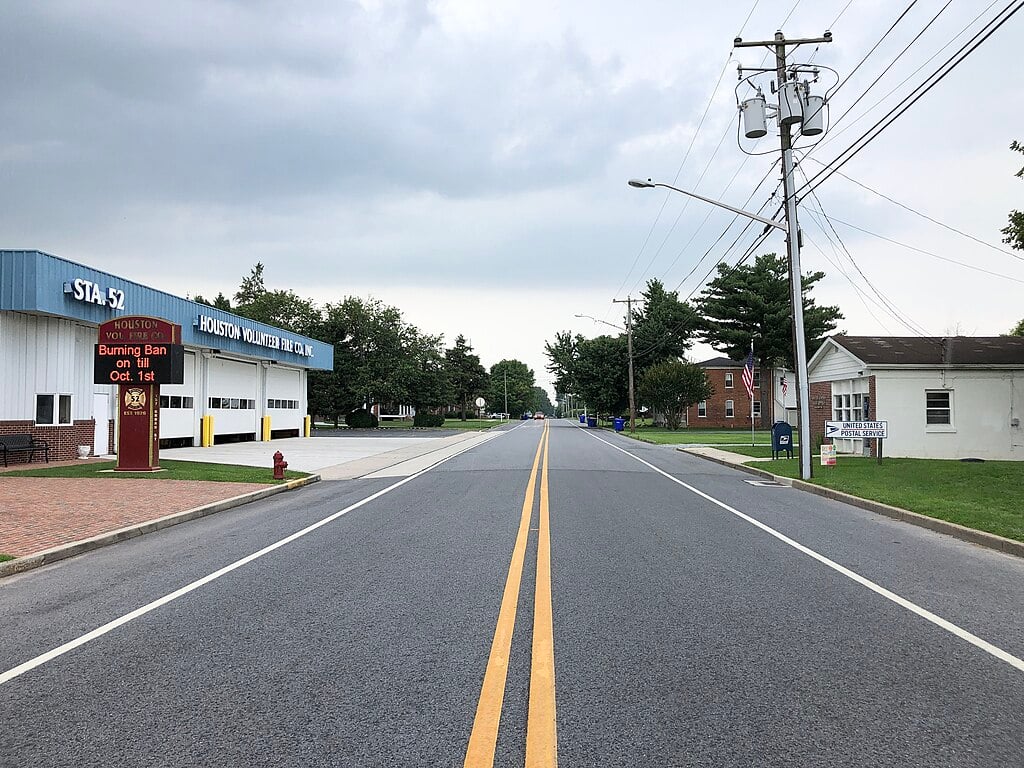
Famartin, CC BY-SA 4.0, via Wikimedia Commons
Why are people willing to pay so much to live here? What’s special about it?
Houston appeals to families seeking small-town living with easy access to larger employment centers. The community offers large lots, newer construction, and a quiet rural atmosphere while maintaining convenient access to Dover, Wilmington, and beach areas. Residents appreciate the lower cost of living compared to northern Delaware counties and the strong school district serving the area.
The town’s location in central Kent County provides the perfect balance of rural tranquility and suburban convenience. Houston has managed to grow thoughtfully, maintaining its agricultural character while welcoming new residential development that attracts young families and empty nesters alike.
How Houston Rose to Prominence
Houston was established in the late 1800s as a railroad stop along the Delaware Railroad line, named after a local family rather than the Texas city. The community grew as a shipping point for local agricultural products, particularly corn and soybeans from surrounding farms.
The town’s modern prominence emerged as Dover’s suburban growth expanded outward and families began seeking more affordable alternatives to expensive coastal and northern communities. Houston’s combination of available land, good schools, and central location made it an attractive destination for residential development.
3 Interesting Tidbits
1. Railroad Origins – The town developed around a Pennsylvania Railroad depot that served local farmers shipping crops to Philadelphia and Baltimore markets.
2. Agricultural Heart – Houston remains surrounded by active farmland, with corn and soybean fields defining much of the community’s rural character.
3. Strategic Location – The town sits at the intersection of several major Kent County roads, making it a natural crossroads for regional traffic and development.
26. Felton – 107.1% Home Price Increase Since 2012
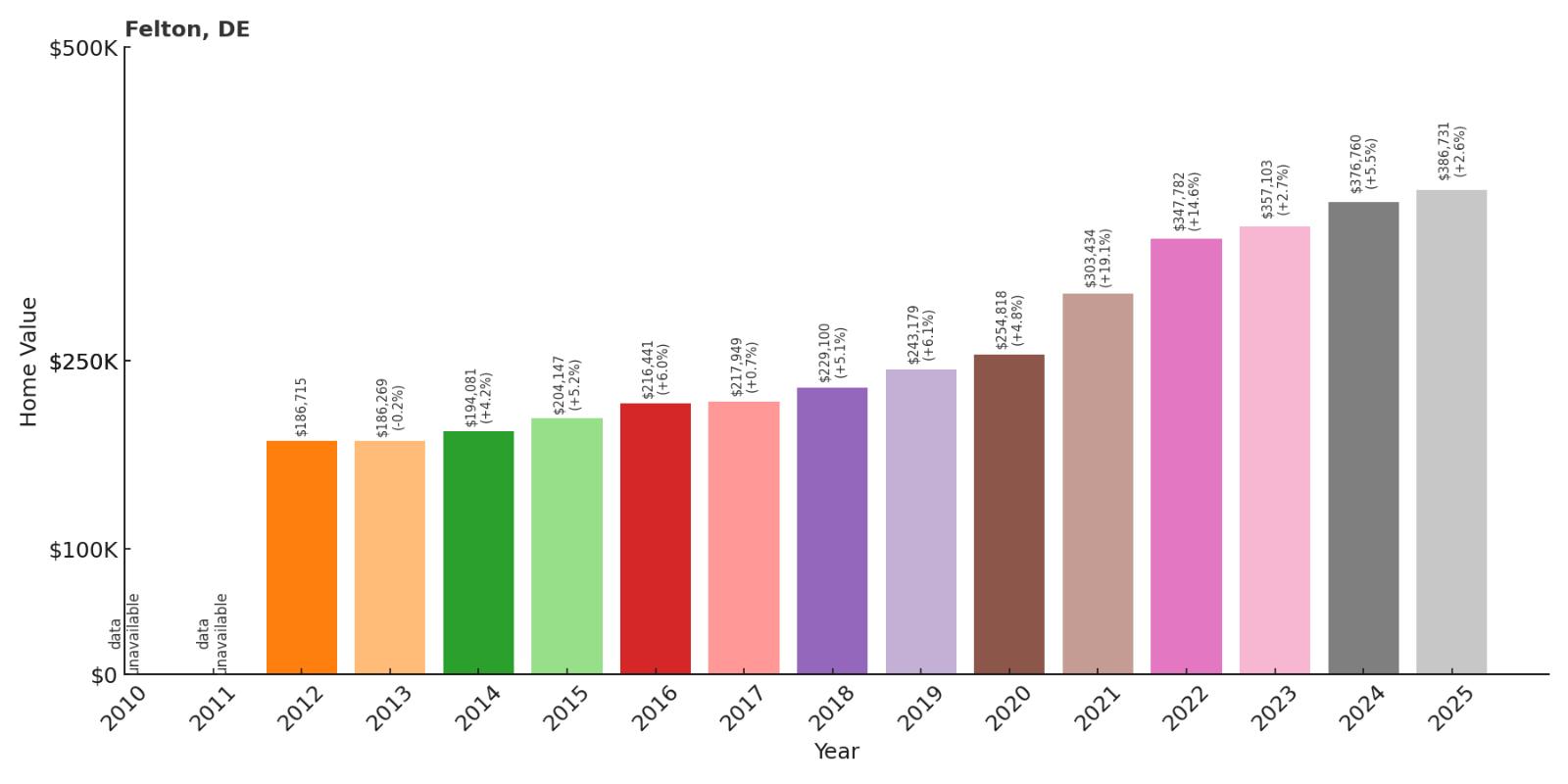
- 2010: N/A
- 2011: N/A
- 2012: $186,715
- 2013: $186,269
- 2014: $194,081
- 2015: $204,147
- 2016: $216,441
- 2017: $217,949
- 2018: $229,100
- 2019: $243,179
- 2020: $254,818
- 2021: $303,434
- 2022: $347,782
- 2023: $357,103
- 2024: $376,760
- 2025: $386,731
Felton has more than doubled in value since 2012, demonstrating remarkable growth for a small Kent County community. The most significant appreciation occurred during the pandemic years, with prices jumping nearly 19% in 2021 alone. Current median prices of $386,731 reflect the town’s emergence as a sought-after residential destination.
Why Felton?
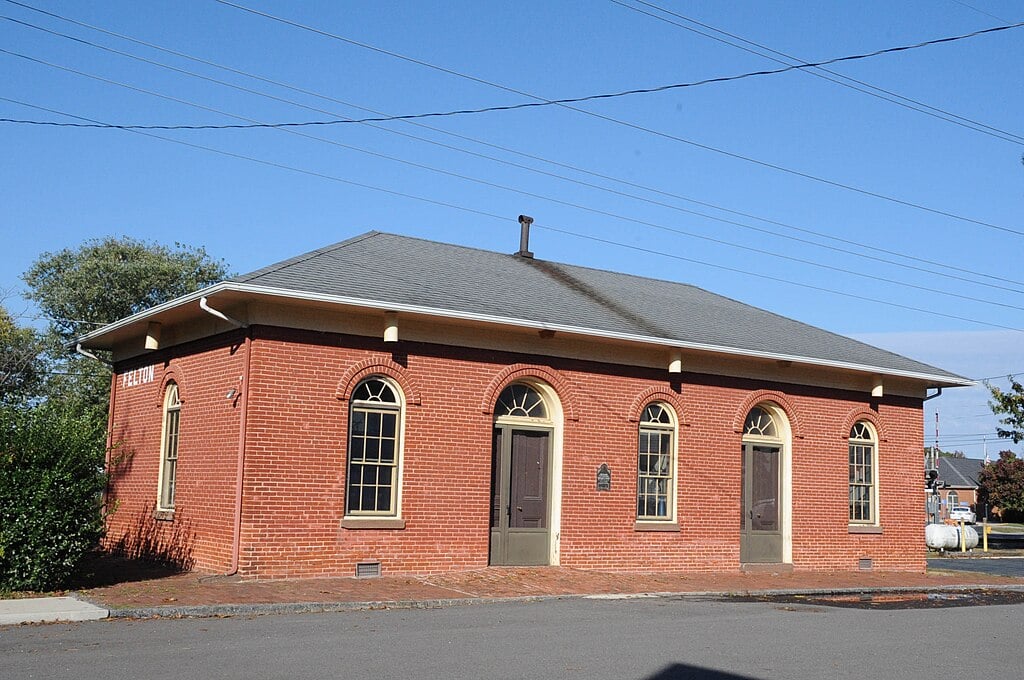
JERRYE & ROY KLOTZ, M.D., CC BY-SA 4.0, via Wikimedia Commons
Why are people willing to pay so much to live here? What’s special about it?
Felton attracts families and retirees seeking affordable small-town living with excellent access to regional amenities. The community offers a peaceful rural atmosphere, friendly neighbors, and easy access to both Dover and the Delaware beaches. Residents appreciate the lower property taxes and cost of living compared to coastal areas while maintaining reasonable commuting distance to major employment centers.
The town’s location in central Delaware provides the best of all worlds – close enough to beaches for weekend trips, near Dover for employment and shopping, yet far enough from urban areas to maintain a quiet, rural character. Felton has attracted families seeking space, value, and community spirit.
How Felton Rose to Prominence
Felton was incorporated in 1856 as a railroad town along the Delaware Railroad, serving as a shipping point for local agricultural products. The town was named after the Felton family, early settlers who owned significant land in the area and operated local businesses.
The community’s prominence grew during the late 20th century as Dover’s suburban expansion reached southward and families began seeking affordable alternatives to expensive coastal communities. Felton’s combination of available land, good schools, and central location made it increasingly attractive for residential development.
3 Interesting Tidbits
1. Railroad Heritage – The original railroad depot building still stands in town, serving as a reminder of Felton’s origins as a shipping hub for local farms.
2. Peach Country – Felton sits in the heart of Delaware’s historic peach-growing region, with several orchards still operating in the surrounding countryside.
3. Volunteer Spirit – The Felton Volunteer Fire Company has served the community for over 70 years, hosting the annual Felton Community Day that brings residents together each summer.
25. Ardentown – 66.2% Home Price Increase Since 2015
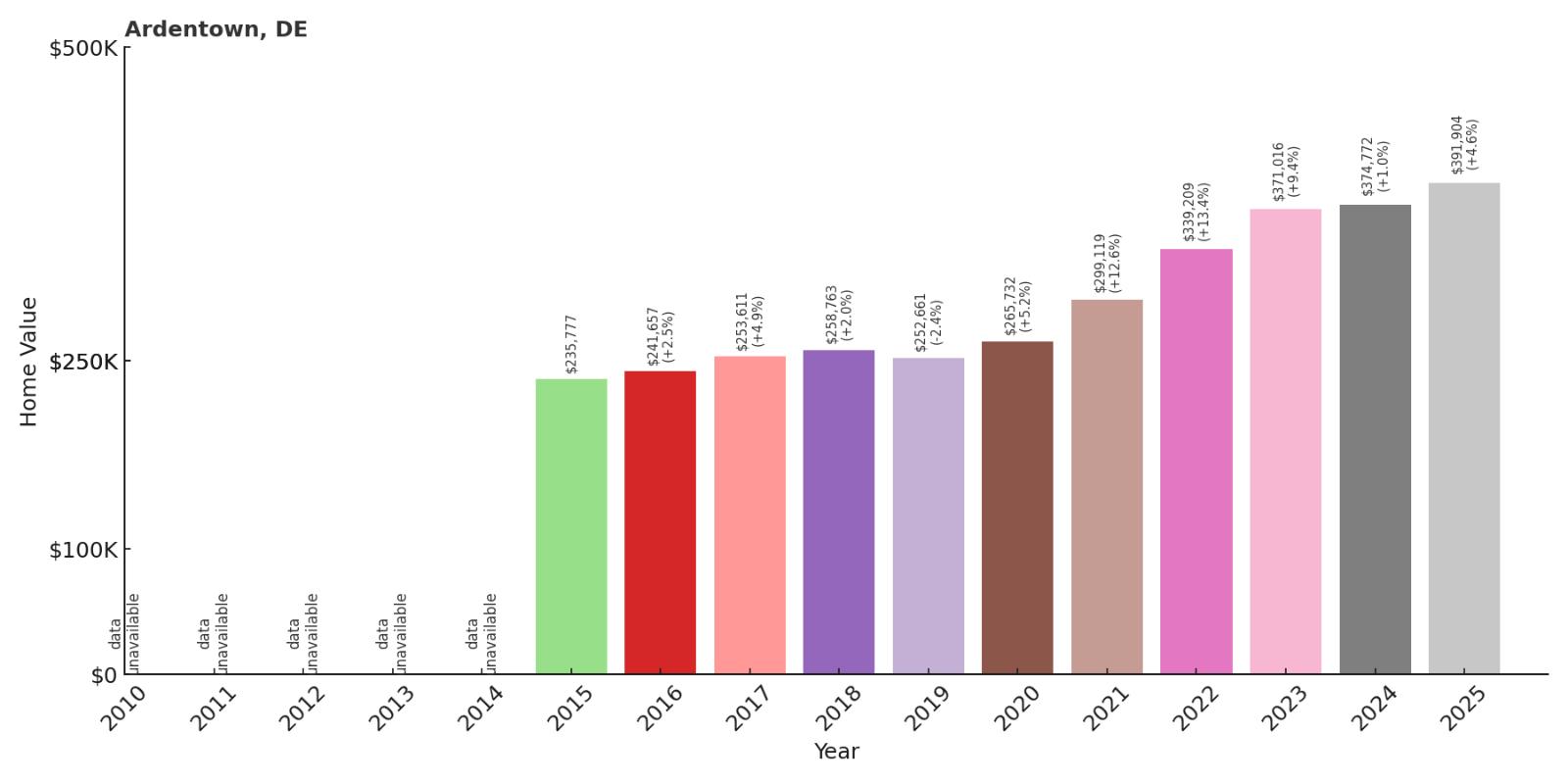
- 2010: N/A
- 2011: N/A
- 2012: N/A
- 2013: N/A
- 2014: N/A
- 2015: $235,777
- 2016: $241,657
- 2017: $253,611
- 2018: $258,763
- 2019: $252,661
- 2020: $265,732
- 2021: $299,119
- 2022: $339,209
- 2023: $371,016
- 2024: $374,772
- 2025: $391,904
Ardentown has gained over 66% in value since 2015, with particularly strong growth during the pandemic years. The community saw prices increase by more than 13% in 2022 alone, reflecting growing demand for this unique New Castle County enclave. Current median prices of $391,904 position Ardentown as an increasingly valuable residential market.
Why Ardentown?
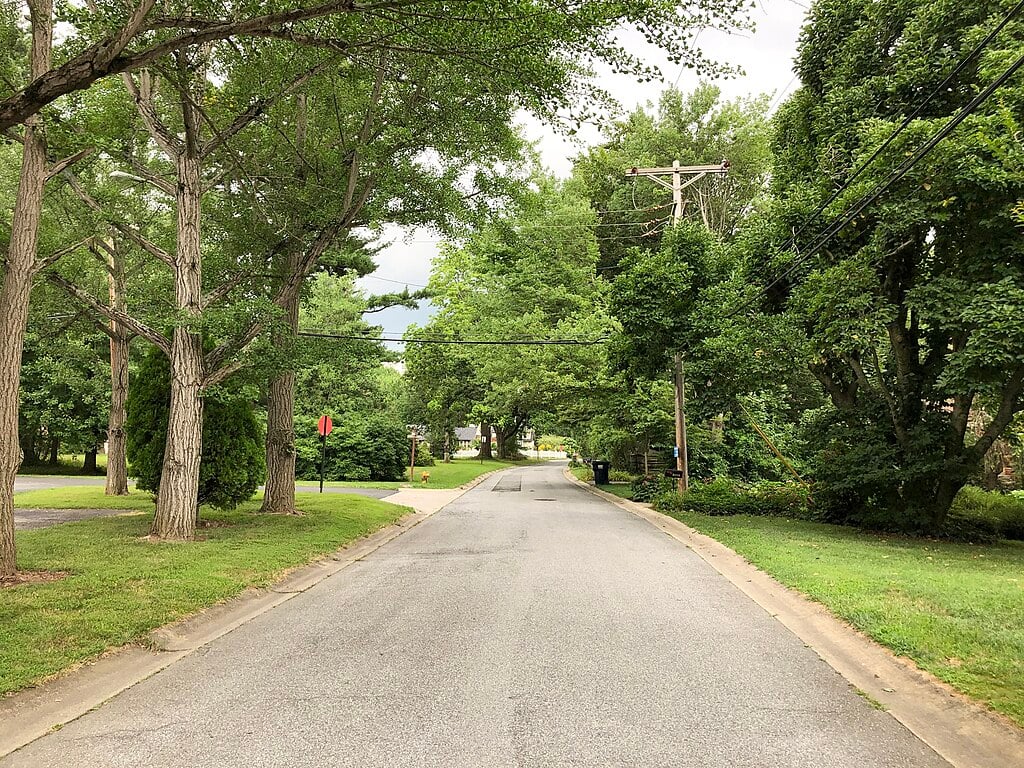
Why are people willing to pay so much to live here? What’s special about it?
Ardentown offers a distinctive arts-focused community atmosphere that appeals to creative professionals, intellectuals, and families seeking something beyond typical suburban living. The village maintains a unique cooperative spirit with community gardens, shared green spaces, and regular cultural events that foster strong neighborhood connections. Residents appreciate the walkable design, environmental consciousness, and proximity to Wilmington’s employment opportunities.
Unlike conventional subdivisions, Ardentown operates as a single-tax community where land is leased rather than owned outright, creating an affordable entry point into an established artistic community. The village’s commitment to preserving green space and promoting sustainable living attracts environmentally conscious residents.
How Ardentown Rose to Prominence
Ardentown was founded in 1922 as part of the Arden movement, inspired by the single-tax theories of economist Henry George. The community was established as an intentional village focused on arts, crafts, and cooperative living, attracting writers, artists, and intellectuals seeking an alternative to urban life.
The village gained prominence as a unique social experiment that successfully balanced individual creativity with community cooperation. Throughout the 20th century, Ardentown attracted notable residents including writers, musicians, and political activists who were drawn to its progressive ideals and artistic atmosphere.
3 Interesting Tidbits
1. Single-Tax Community – Residents lease land rather than owning it outright, with community fees funding shared amenities and services based on Henry George’s economic theories.
2. Shakespeare Connection – The three Arden villages (Arden, Ardentown, and Ardencroft) are named after the Forest of Arden from Shakespeare’s “As You Like It.”
3. Craft Tradition – The village maintains active guilds for pottery, weaving, woodworking, and other traditional crafts, continuing its founders’ emphasis on handmade arts.
24. Smyrna – 94% Home Price Increase Since 2010
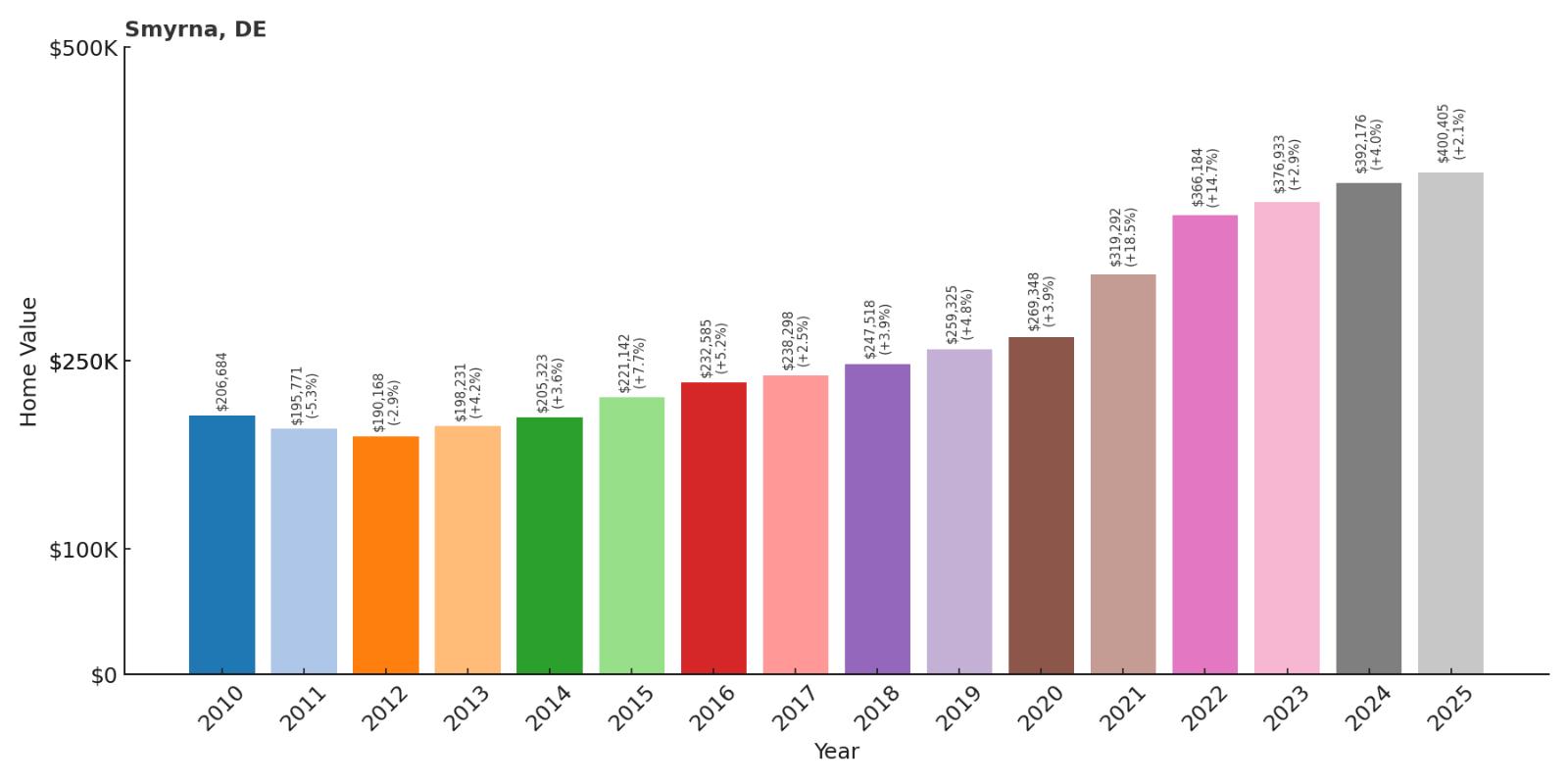
- 2010: $206,684
- 2011: $195,771
- 2012: $190,168
- 2013: $198,231
- 2014: $205,323
- 2015: $221,142
- 2016: $232,585
- 2017: $238,298
- 2018: $247,518
- 2019: $259,325
- 2020: $269,348
- 2021: $319,292
- 2022: $366,184
- 2023: $376,933
- 2024: $392,176
- 2025: $400,405
Smyrna has nearly doubled in value since 2010, showing remarkable resilience and growth throughout the past 15 years. The town experienced particularly strong appreciation during 2021-2022, gaining over 33% in just two years. Current median prices of $400,405 reflect Smyrna’s transformation into one of central Delaware’s most desirable communities.
Why Smyrna?
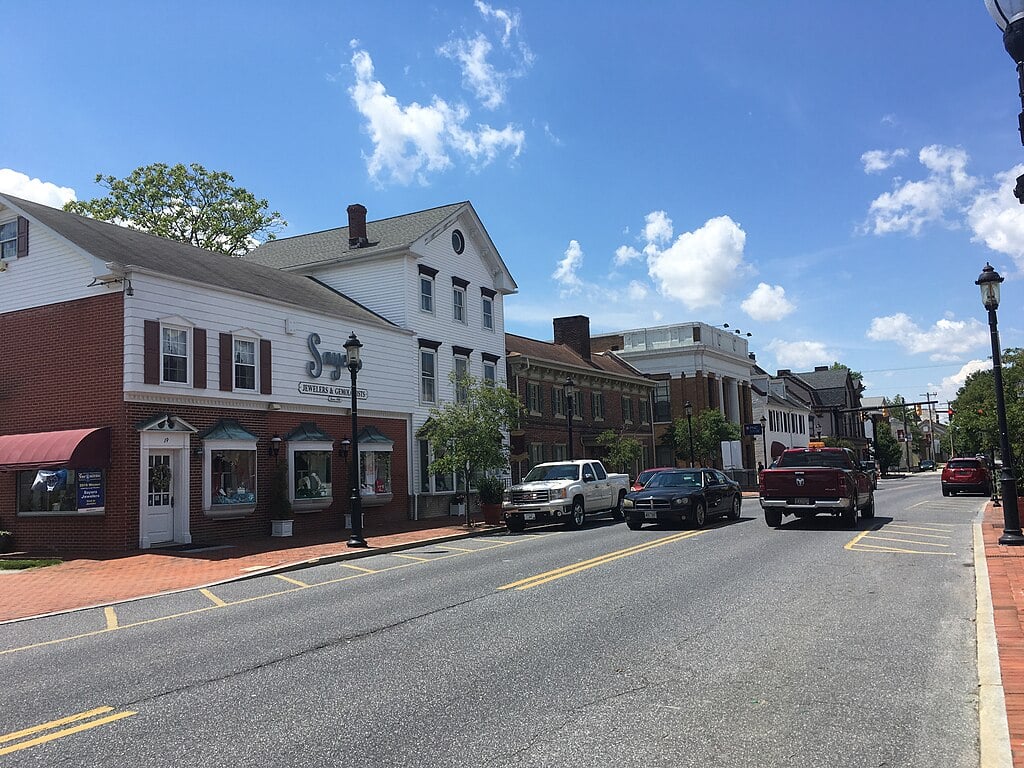
Why are people willing to pay so much to live here? What’s special about it?
Smyrna appeals to families and professionals seeking a perfect balance of small-town charm and modern amenities. The historic downtown offers shops, restaurants, and community events while newer developments provide contemporary housing options. Residents value the excellent schools, strong community spirit, and convenient access to both Wilmington and Dover for employment.
The town’s strategic location along Route 1 provides easy commuting to major employment centers while maintaining affordable living costs compared to northern Delaware. Smyrna has successfully managed growth to preserve its historic character while accommodating new families attracted to its quality of life.
How Smyrna Rose to Prominence
Founded in 1768, Smyrna originally served as a shipping port for agricultural products from the surrounding Kent County farmland. The town was named after the ancient Turkish port city, reflecting its role as a commercial hub during the colonial era.
Smyrna’s modern prominence emerged during the late 20th century as suburban growth from both Wilmington and Dover reached the area. The town’s historic downtown, combined with available land for development and excellent schools, attracted families seeking alternatives to more expensive northern communities.
3 Interesting Tidbits
1. Historic Depot – The restored Smyrna Train Station serves as a visitor center and reminder of the town’s role as a major railroad stop between Philadelphia and the Delmarva Peninsula.
2. Duck Creek Heritage – The town’s original prosperity came from shipping grain and lumber via Duck Creek to larger Delaware River ports, with several historic buildings dating to this era.
3. Opera House Legacy – Smyrna once boasted its own opera house in the late 1800s, reflecting the cultural sophistication that came with prosperity from agricultural shipping.
23. Camden – 90% Home Price Increase Since 2010
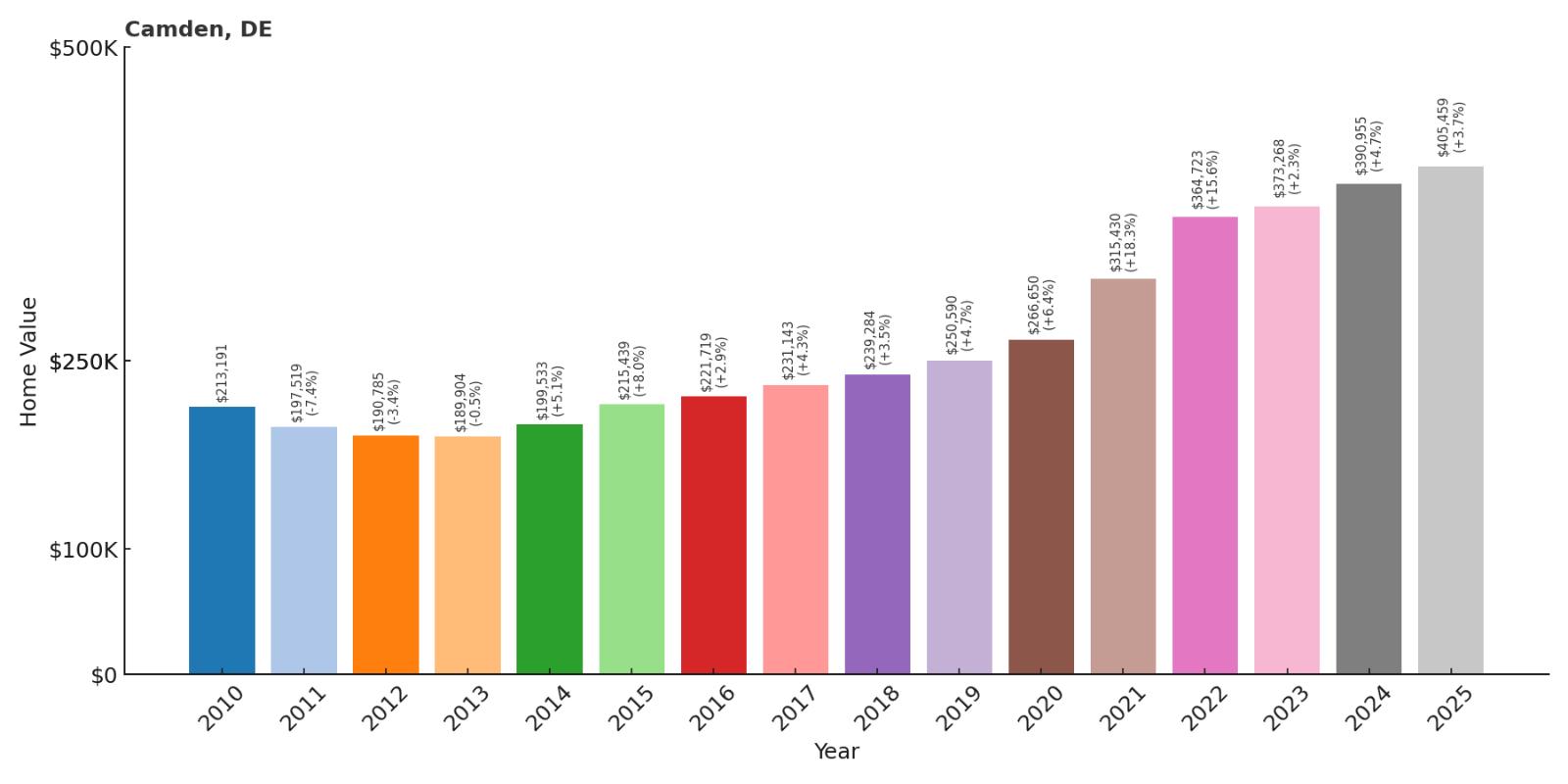
- 2010: $213,191
- 2011: $197,519
- 2012: $190,785
- 2013: $189,904
- 2014: $199,533
- 2015: $215,439
- 2016: $221,719
- 2017: $231,143
- 2018: $239,284
- 2019: $250,590
- 2020: $266,650
- 2021: $315,430
- 2022: $364,723
- 2023: $373,268
- 2024: $390,955
- 2025: $405,459
Camden has shown exceptional growth since 2010, nearly doubling in value over the past 15 years. The town experienced particularly dramatic appreciation during the pandemic era, with prices jumping over 18% in 2021 alone. Current median prices of $405,459 reflect Camden’s emergence as one of Kent County’s premier residential destinations.
Why Camden?

Why are people willing to pay so much to live here? What’s special about it?
Camden attracts families seeking high-quality suburban living with excellent schools and community amenities. The town offers a perfect blend of historic charm and modern convenience, with a walkable downtown area featuring shops, restaurants, and regular community events. Residents appreciate the strong school district, active youth sports programs, and convenient access to Dover and other regional centers.
The community’s commitment to maintaining its small-town character while providing modern amenities appeals to young families and empty nesters alike. Camden’s location provides easy access to Delaware beaches, Wilmington employment opportunities, and Philadelphia, making it ideal for commuters seeking quality of life.
How Camden Rose to Prominence
Camden was incorporated in 1875 as a railroad town along the Pennsylvania Railroad line connecting Philadelphia to the Delmarva Peninsula. The town was named after Camden, New Jersey, reflecting the railroad connections that linked these communities during the late 19th century.
The town’s prominence grew during the suburban expansion of the late 20th century as families from Wilmington and Dover sought affordable alternatives with good schools and community amenities. Camden’s combination of historic downtown charm and available land for development made it increasingly attractive for residential growth.
3 Interesting Tidbits
1. Railroad Town – The historic Camden Train Station still stands as a reminder of the town’s origins, though passenger service ended decades ago.
2. Peach Festival – Camden hosts an annual Peach Festival that celebrates the area’s agricultural heritage and brings together residents from across Kent County.
3. Sports Heritage – The town has produced several notable athletes, including professional baseball players who got their start in Camden’s youth leagues.
22. Clayton – 80% Home Price Increase Since 2010
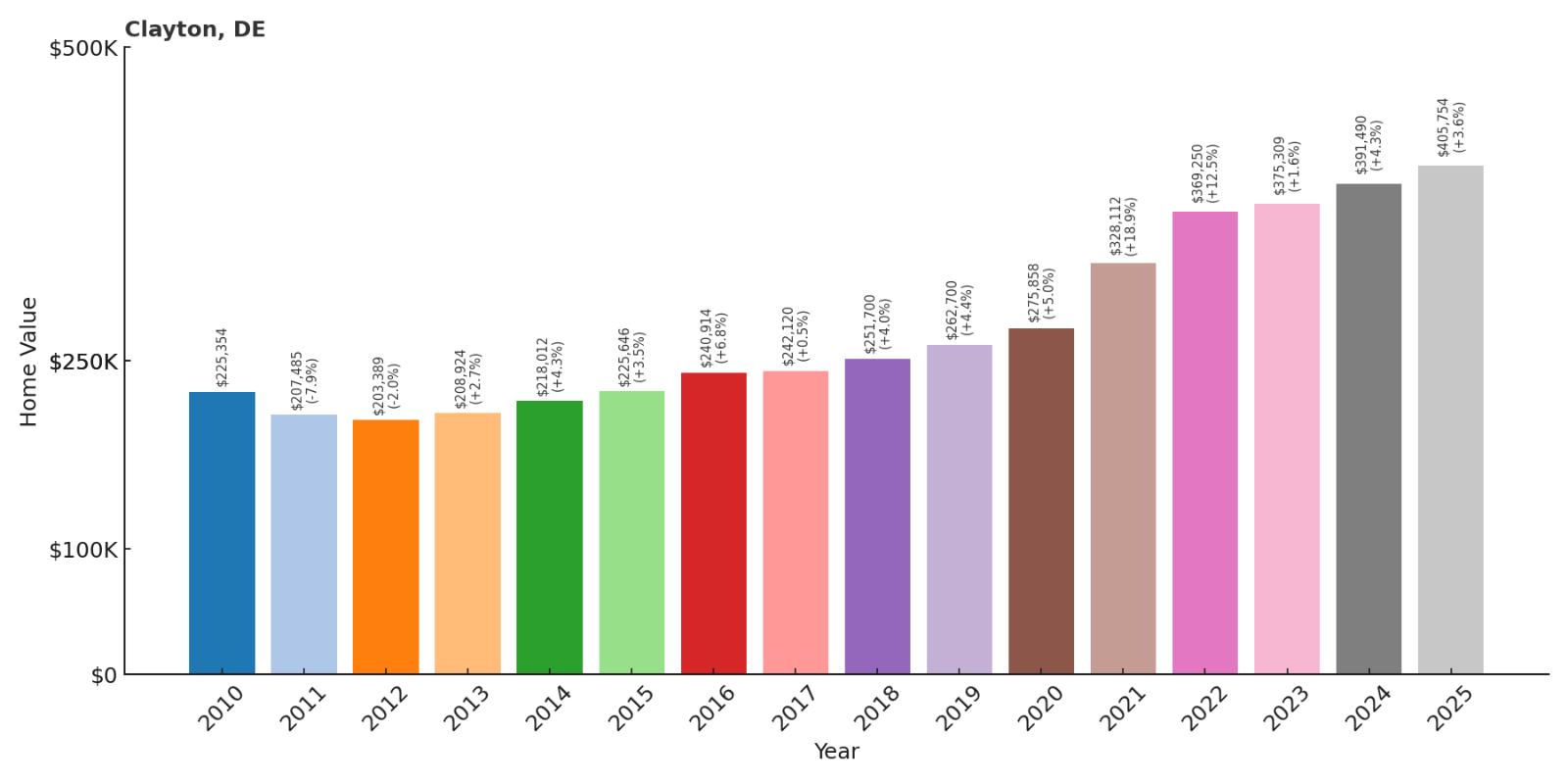
- 2010: $225,354
- 2011: $207,485
- 2012: $203,389
- 2013: $208,924
- 2014: $218,012
- 2015: $225,646
- 2016: $240,914
- 2017: $242,120
- 2018: $251,700
- 2019: $262,700
- 2020: $275,858
- 2021: $328,112
- 2022: $369,250
- 2023: $375,309
- 2024: $391,490
- 2025: $405,754
Clayton has gained 80% in value since 2010, demonstrating steady appreciation throughout the past 15 years. The town saw particularly strong growth during the pandemic years, with values increasing over 19% in 2021 alone. Current median prices of $405,754 reflect Clayton’s position as one of central Delaware’s most sought-after communities.
Why Clayton?
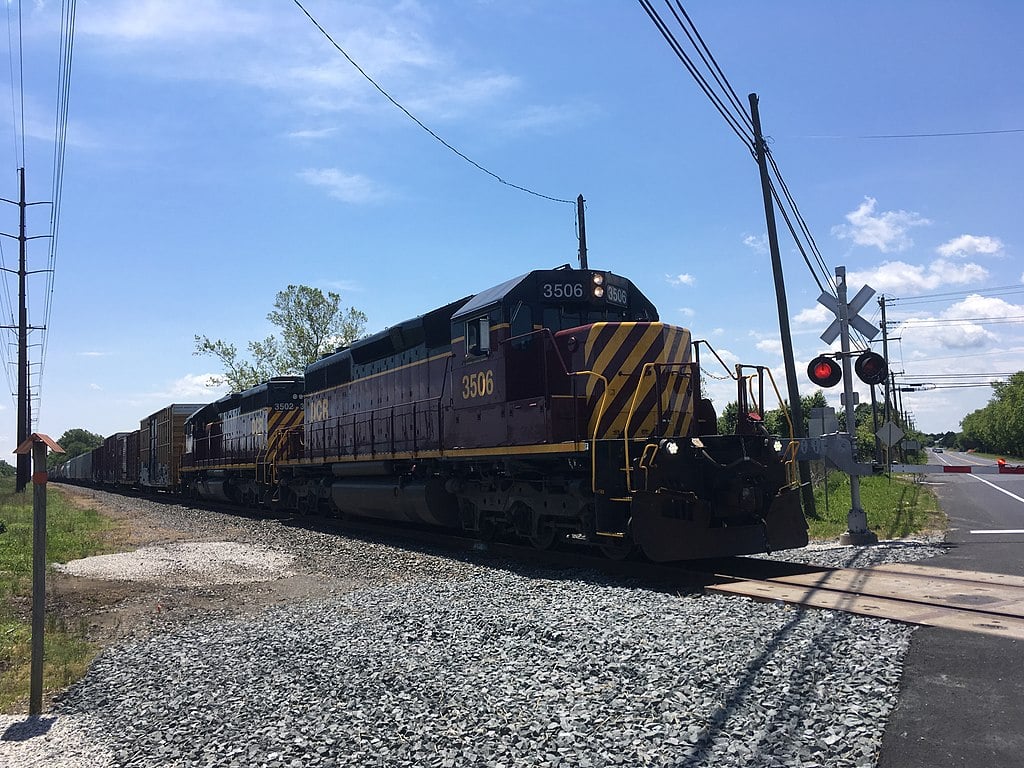
Why are people willing to pay so much to live here? What’s special about it?
Clayton appeals to families and professionals who want the convenience of modern suburban amenities while maintaining a strong sense of community. The town offers excellent schools, well-maintained neighborhoods, and a variety of housing options from starter homes to executive properties. Residents appreciate the balance between small-town charm and access to regional employment centers in Dover, Wilmington, and even Philadelphia.
The community’s strategic location along major transportation corridors provides easy commuting while preserving the peaceful residential atmosphere that families seek. Clayton has successfully managed growth to maintain neighborhood character while adding amenities like parks, shopping, and dining options that enhance quality of life.
How Clayton Rose to Prominence
Clayton was incorporated in 1959, making it one of Delaware’s newer municipalities, originally developed as a planned suburban community to accommodate post-World War II population growth. The town was named after local landowner John Clayton and designed with modern suburban planning principles including curved streets, parks, and varied housing styles.
The community’s prominence grew during the suburban expansion of the 1980s and 1990s as families from Wilmington and Dover sought newer housing with modern amenities. Clayton’s combination of good schools, available land for development, and convenient location made it a natural choice for residential growth in central Delaware.
3 Interesting Tidbits
1. Planned Community – Unlike many Delaware towns that grew organically, Clayton was deliberately planned as a modern suburb with amenities and infrastructure designed from the start.
2. Rapid Growth – The town’s population has grown from fewer than 1,000 residents at incorporation to over 3,000 today, reflecting its success as a residential destination.
3. Modern Infrastructure – Clayton was designed with modern utilities, wide streets, and planned green spaces that set it apart from older Delaware communities that grew around historic centers.
21. Millsboro – 53% Home Price Increase Since 2010
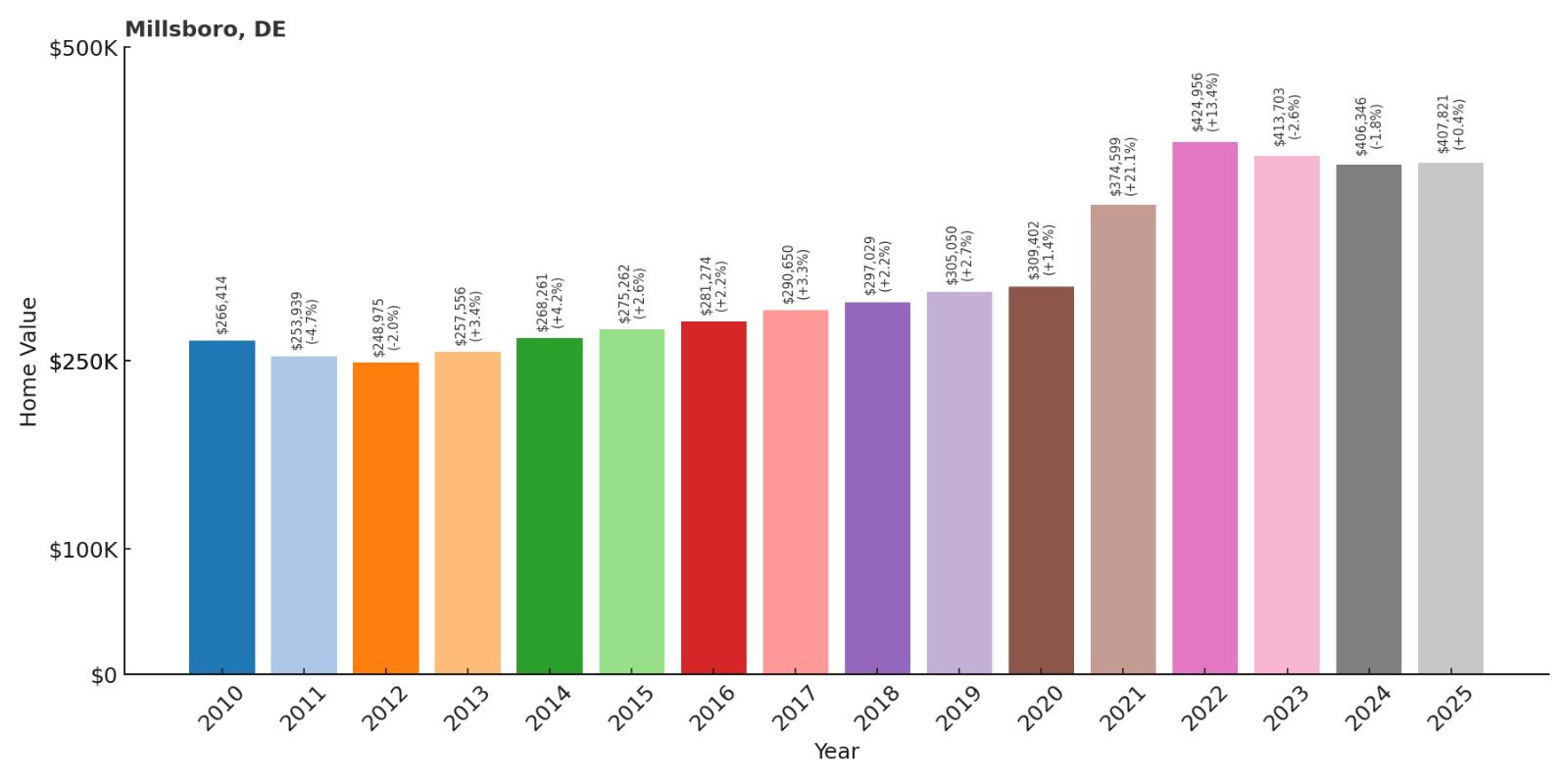
- 2010: $266,414
- 2011: $253,939
- 2012: $248,975
- 2013: $257,556
- 2014: $268,261
- 2015: $275,262
- 2016: $281,274
- 2017: $290,650
- 2018: $297,029
- 2019: $305,050
- 2020: $309,402
- 2021: $374,599
- 2022: $424,956
- 2023: $413,703
- 2024: $406,346
- 2025: $407,821
Millsboro has shown steady growth since 2010, gaining 53% over the past 15 years with dramatic appreciation during the pandemic era. The town saw values spike over 21% in 2021, followed by another significant increase in 2022. Current median prices of $407,821 reflect Millsboro’s position as an inland Sussex County community with coastal appeal.
Why Millsboro?
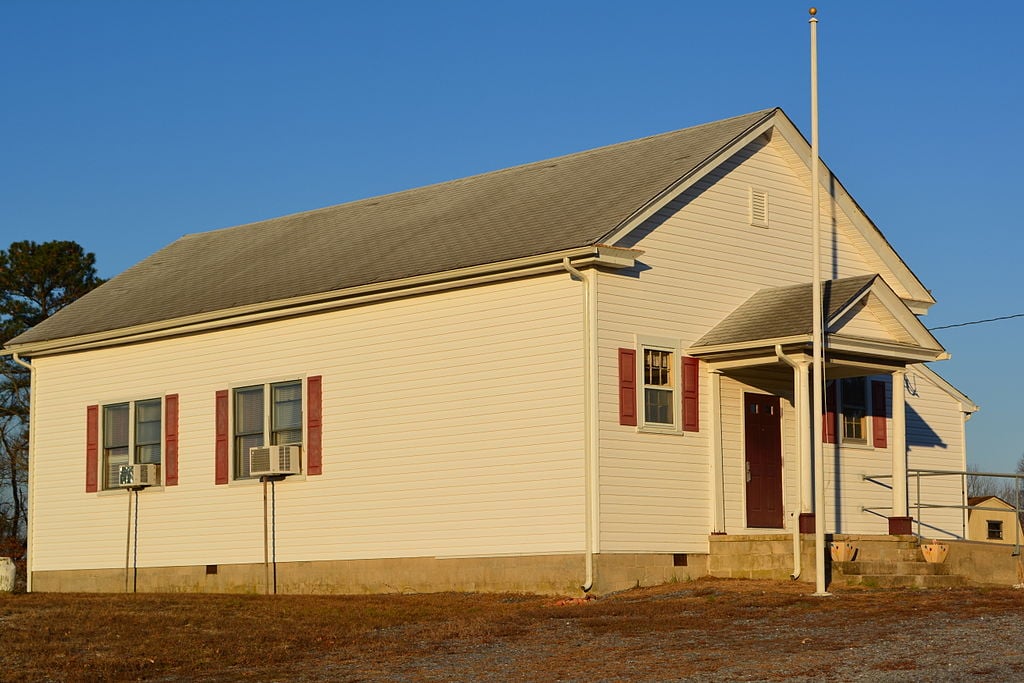
Why are people willing to pay so much to live here? What’s special about it?
Millsboro attracts retirees and families seeking coastal living without oceanfront prices. The town’s location along the Indian River provides waterfront access, boating opportunities, and scenic beauty while maintaining more affordable housing than beachfront communities. Residents appreciate the small-town atmosphere, friendly community, and easy access to Delaware beaches and Ocean City, Maryland.
The area’s growing reputation as a retirement destination has brought infrastructure improvements, new dining and shopping options, and quality healthcare facilities. Millsboro offers the best of coastal Delaware living with lower costs than oceanfront towns and access to both bay and ocean activities.
How Millsboro Rose to Prominence
Millsboro was founded in the early 1700s along the Indian River, originally serving as a mill town where farmers brought grain to be processed. The town’s name reflects its origins as a center for local mills that powered the rural economy throughout the colonial and early American periods.
The community’s modern prominence emerged as coastal Delaware development expanded inland and retirees began seeking alternatives to expensive beachfront properties. Millsboro’s combination of waterfront access, affordable housing, and proximity to beaches made it increasingly attractive for both retirees and families seeking coastal lifestyle benefits.
3 Interesting Tidbits
1. Mill Heritage – Several historic mill sites along the Indian River remind visitors of Millsboro’s origins as a grain processing center for surrounding farms.
2. Nanticoke Connection – The town sits in the heart of traditional Nanticoke Indian territory, with several archaeological sites and cultural connections to the area’s native heritage.
3. Chicken Capital – Millsboro is surrounded by some of Delaware’s largest poultry operations, making it a center of the state’s important agricultural industry.
20. Arden – 30% Home Price Increase Since 2010

- 2010: $315,365
- 2011: $269,601
- 2012: $238,291
- 2013: $252,598
- 2014: $274,928
- 2015: $288,433
- 2016: $292,522
- 2017: $296,324
- 2018: $312,271
- 2019: $306,400
- 2020: $303,554
- 2021: $356,702
- 2022: $396,244
- 2023: $405,866
- 2024: $391,837
- 2025: $411,267
Arden has shown modest but steady growth since 2010, gaining 30% over the past 15 years despite significant volatility in the early 2010s. The community experienced strong appreciation during the pandemic years, with values increasing over 17% in 2021. Current median prices of $411,267 reflect the unique value proposition of this historic artistic community.
Why Arden?
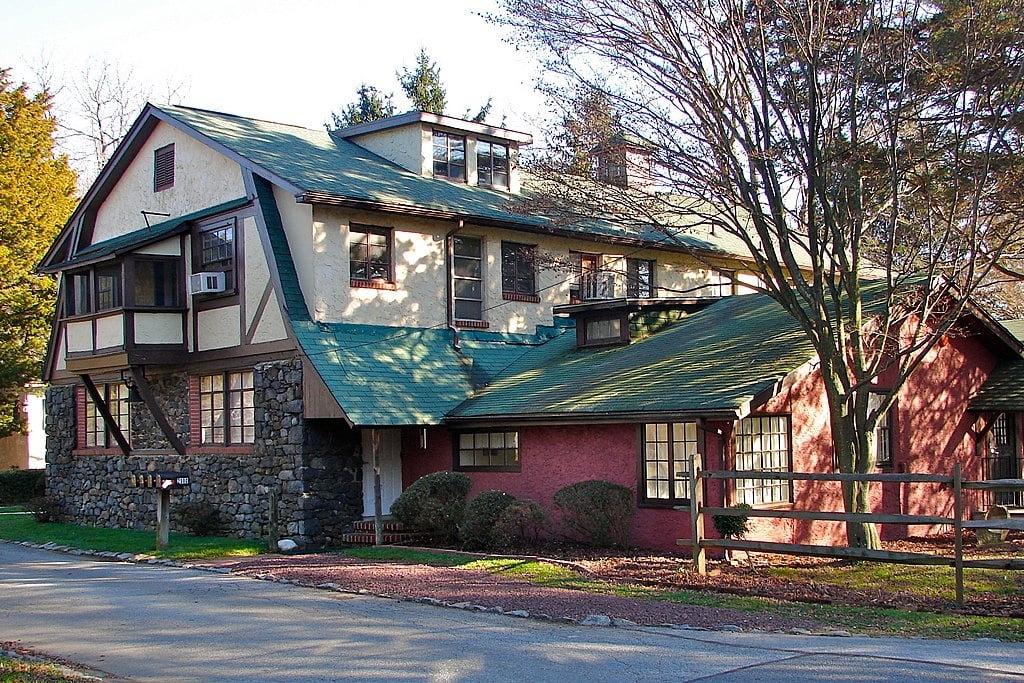
Why are people willing to pay so much to live here? What’s special about it?
Arden offers a distinctive living experience that appeals to artists, intellectuals, and families seeking community-centered lifestyle. The village operates as a single-tax community with shared green spaces, community gardens, and regular cultural events that foster strong neighborhood connections. Residents value the cooperative spirit, environmental consciousness, and creative atmosphere that sets Arden apart from conventional suburbs.
The community’s proximity to Wilmington provides access to employment and cultural amenities while maintaining a rural village feel. Arden’s commitment to preserving green space and promoting sustainable living attracts environmentally conscious residents who want authentic community engagement rather than typical suburban isolation.
How Arden Rose to Prominence
Arden was founded in 1900 by sculptor Frank Stephens and architect Will Price as a utopian community based on the single-tax theories of Henry George. The village was designed to prove that cooperative land ownership and taxation could create a more equitable and sustainable community than conventional real estate development.
The community gained prominence as an artists’ colony that attracted writers, musicians, and intellectuals throughout the 20th century. Notable residents included playwright George Bernard Shaw’s associates and various progressive thinkers who were drawn to Arden’s experimental social and economic structure.
3 Interesting Tidbits
1. Georgist Experiment – Arden remains one of the few successful implementations of Henry George’s single-tax theory, where residents lease land from the community rather than owning it outright.
2. Shakespeare Festival – The village hosts an annual outdoor Shakespeare festival in its forest theater, continuing a tradition that dates back to the early 1900s.
3. Historic Preservation – Many of Arden’s original Arts and Crafts-style homes remain intact, creating a unique architectural legacy that reflects the founders’ aesthetic ideals.
19. Ardencroft – 65.4% Home Price Increase Since 2015
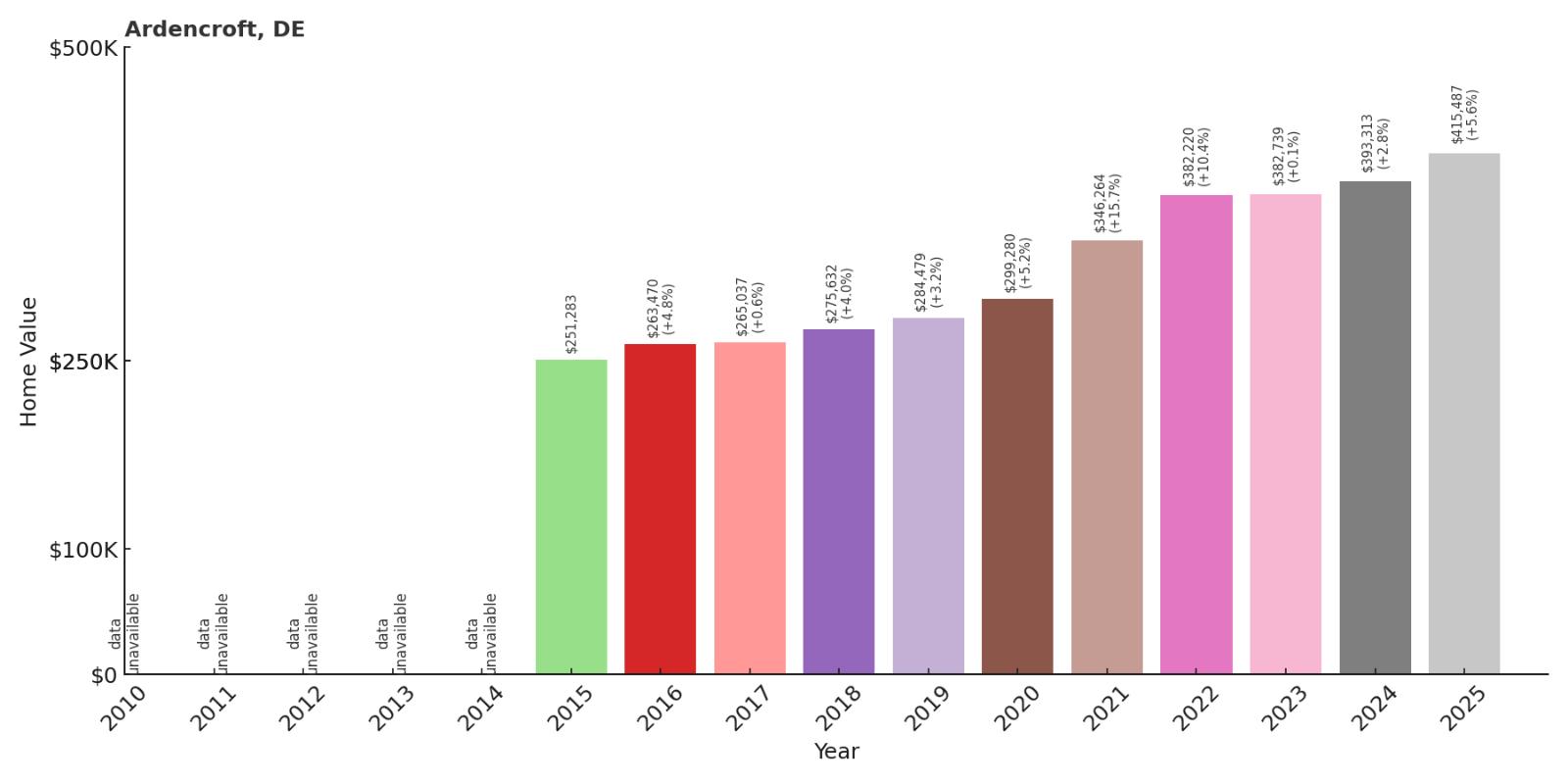
- 2010: N/A
- 2011: N/A
- 2012: N/A
- 2013: N/A
- 2014: N/A
- 2015: $251,283
- 2016: $263,470
- 2017: $265,037
- 2018: $275,632
- 2019: $284,479
- 2020: $299,280
- 2021: $346,264
- 2022: $382,220
- 2023: $382,739
- 2024: $393,313
- 2025: $415,487
Ardencroft has gained over 65% in value since 2015, showing particularly strong appreciation during the pandemic years. The community experienced significant growth in 2021-2022, with values increasing over 26% in just two years. Current median prices of $415,487 reflect growing demand for this unique cooperative community.
Why Ardencroft?
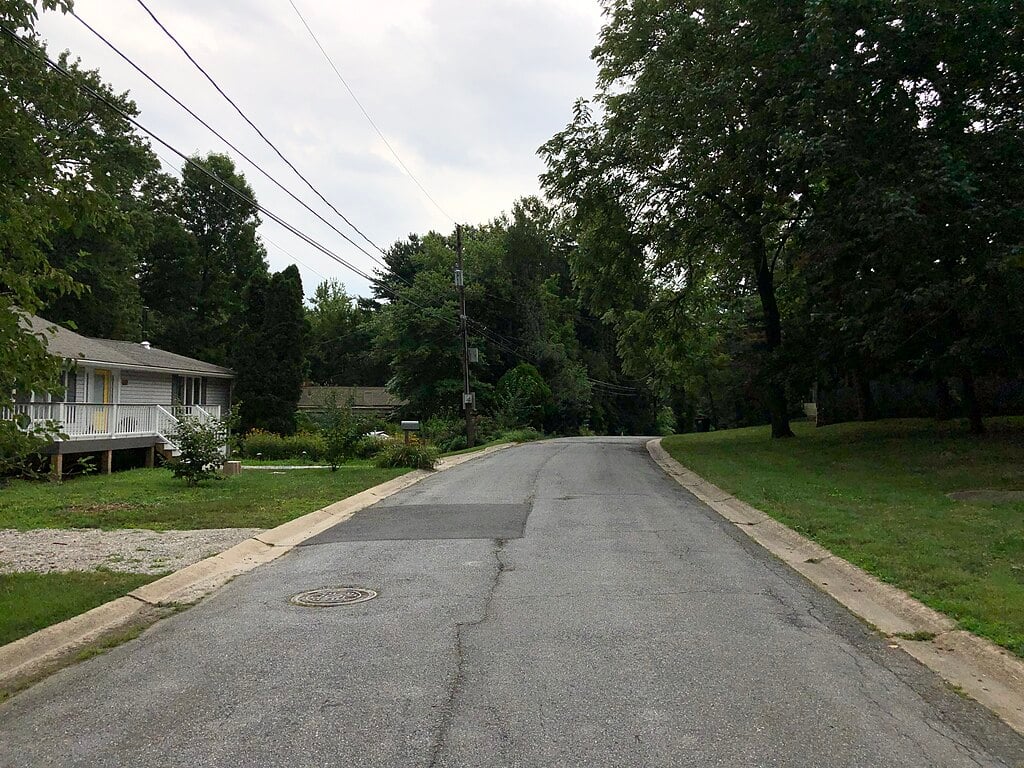
Why are people willing to pay so much to live here? What’s special about it?
Ardencroft appeals to residents seeking an alternative to conventional suburban living through its cooperative community structure and emphasis on shared responsibility. The village offers a unique blend of individual privacy and community engagement, with residents participating in local governance and maintaining common areas together. Families appreciate the safe, walkable environment and strong community bonds that develop through shared activities and decision-making.
The community’s location provides easy access to Wilmington employment while maintaining a distinctly rural village atmosphere. Ardencroft’s commitment to environmental stewardship and community cooperation attracts residents who value sustainability and authentic neighbor relationships over typical suburban anonymity.
How Ardencroft Rose to Prominence
Ardencroft was established in 1950 as the third and newest of the Arden villages, created to expand the single-tax community concept developed in nearby Arden and Ardentown. The village was planned as a residential community that would combine the cooperative ideals of the older villages with more conventional suburban amenities.
The community gained prominence as a successful example of cooperative living that balanced individual ownership with shared community responsibility. Throughout the latter half of the 20th century, Ardencroft attracted families and professionals who were drawn to its unique governance structure and community-centered lifestyle.
3 Interesting Tidbits
1. Newest Arden – Ardencroft is the youngest of the three Arden villages, representing a mid-20th century evolution of the original cooperative community concept.
2. Community Governance – Residents participate directly in village governance through town meetings and committees, maintaining the democratic ideals of the original Arden movement.
3. Green Legacy – The village maintains extensive common green spaces and walking trails that connect to the larger Arden forest preserve system.
18. Magnolia – 86% Home Price Increase Since 2010
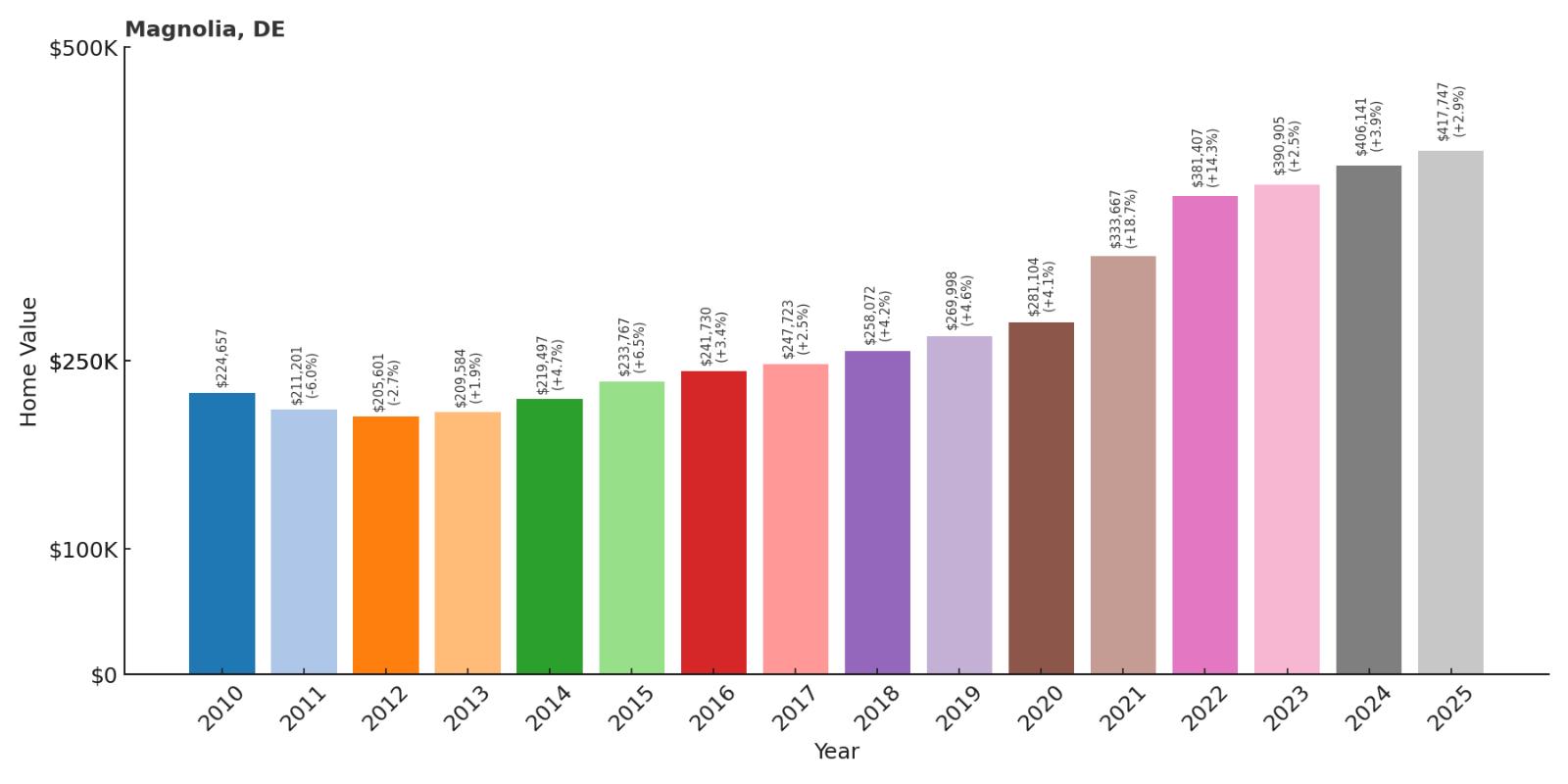
- 2010: $224,657
- 2011: $211,201
- 2012: $205,601
- 2013: $209,584
- 2014: $219,497
- 2015: $233,767
- 2016: $241,730
- 2017: $247,723
- 2018: $258,072
- 2019: $269,998
- 2020: $281,104
- 2021: $333,667
- 2022: $381,407
- 2023: $390,905
- 2024: $406,141
- 2025: $417,747
Magnolia has shown impressive growth since 2010, gaining 86% over the past 15 years with particularly strong appreciation during the pandemic era. The town experienced dramatic growth in 2021-2022, with values increasing over 32% in just two years. Current median prices of $417,747 reflect Magnolia’s emergence as a sought-after Kent County community.
Why Magnolia?
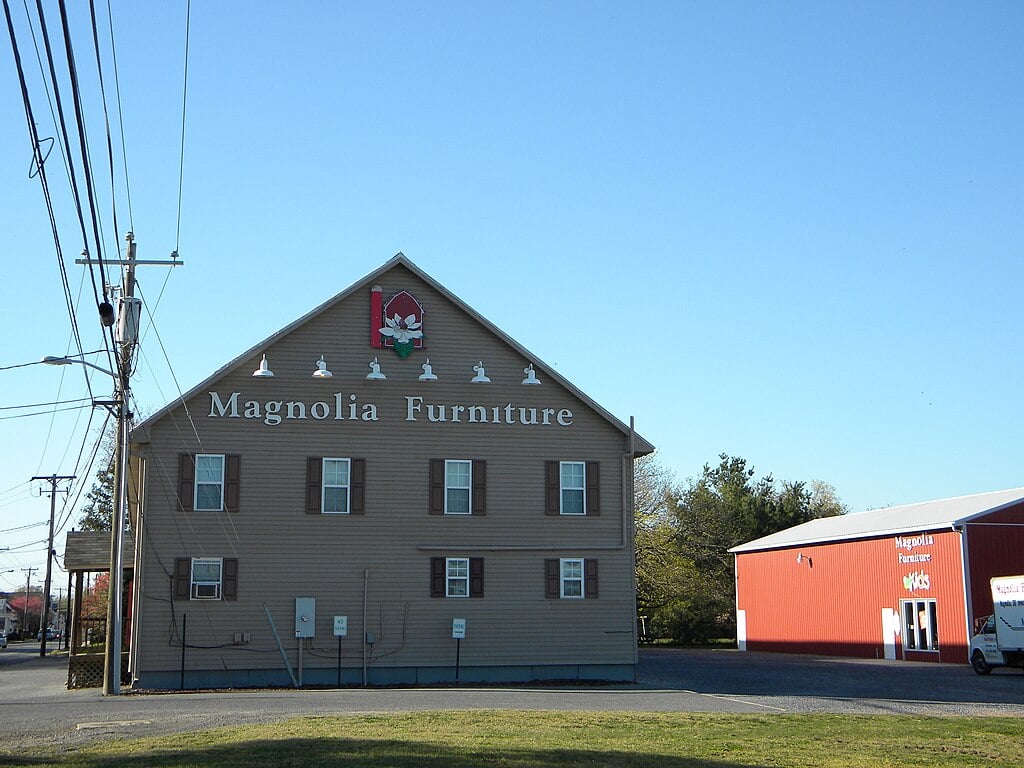
Why are people willing to pay so much to live here? What’s special about it?
Magnolia attracts families seeking small-town charm with convenient access to regional employment centers. The community offers a peaceful rural atmosphere, strong community spirit, and affordable living compared to northern Delaware counties. Residents appreciate the excellent schools, safe neighborhoods, and easy access to both Dover and Wilmington for employment and cultural amenities.
The town’s location in central Kent County provides the perfect balance of rural tranquility and suburban convenience. Magnolia has maintained its agricultural character while welcoming new residential development that appeals to young families and retirees seeking quality of life at reasonable prices.
How Magnolia Rose to Prominence
Magnolia was incorporated in 1885 as a railroad town along the Delaware Railroad line, serving as a shipping point for local agricultural products, particularly the peaches and corn that dominated Kent County farming. The town was named for the magnolia trees that grew in the area, reflecting the community’s appreciation for its natural setting.
The town’s modern prominence emerged during the suburban expansion of recent decades as families from Dover and Wilmington sought affordable alternatives with good schools and community amenities. Magnolia’s combination of available land, central location, and small-town character made it increasingly attractive for residential development.
3 Interesting Tidbits
1. Peach Heritage – Magnolia was once surrounded by extensive peach orchards that shipped fruit throughout the mid-Atlantic region via the local railroad depot.
2. Railroad Legacy – The town’s original prosperity came from its role as a shipping point for agricultural products traveling between local farms and Philadelphia markets.
3. Community Spirit – Magnolia hosts several annual community events that bring together residents from across Kent County, maintaining its tradition as a regional gathering place.
17. Bear – 66% Home Price Increase Since 2010
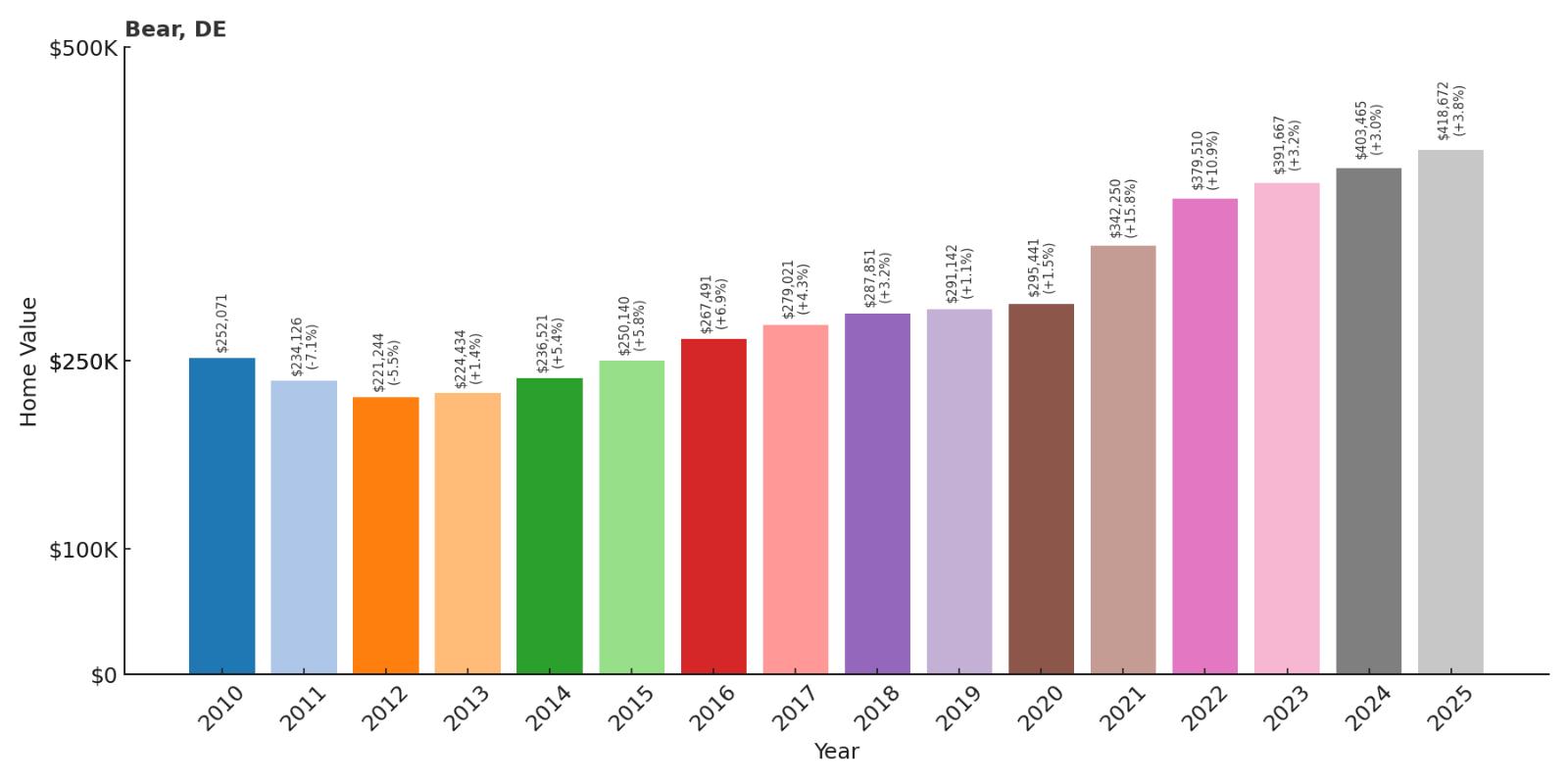
- 2010: $252,071
- 2011: $234,126
- 2012: $221,244
- 2013: $224,434
- 2014: $236,521
- 2015: $250,140
- 2016: $267,491
- 2017: $279,021
- 2018: $287,851
- 2019: $291,142
- 2020: $295,441
- 2021: $342,250
- 2022: $379,510
- 2023: $391,667
- 2024: $403,465
- 2025: $418,672
Bear has gained 66% in value since 2010, showing steady appreciation with acceleration during the pandemic years. The community experienced strong growth from 2021-2022, with values increasing over 26% in just two years. Current median prices of $418,672 reflect Bear’s position as one of New Castle County’s most popular suburban communities.
Why Bear?

Why are people willing to pay so much to live here? What’s special about it?
Bear appeals to families seeking suburban convenience with excellent schools and diverse housing options. The community offers easy access to Wilmington employment while maintaining more affordable housing than closer-in suburbs. Residents appreciate the variety of neighborhoods, from established developments to newer communities, along with shopping centers, restaurants, and recreational facilities.
The area’s strategic location provides quick access to major highways connecting Wilmington, Philadelphia, and Baltimore, making it ideal for commuters. Bear has successfully balanced growth with livability, offering suburban amenities while preserving green spaces and community character.
How Bear Rose to Prominence
Bear developed as a suburban community during the post-World War II expansion of New Castle County, growing from rural farmland into one of Delaware’s largest unincorporated communities. The area was named after a local tavern called the Bear Tavern that served travelers along the old Baltimore Pike.
The community’s prominence grew during the suburban boom of the 1970s and 1980s as families from Wilmington sought newer housing with modern amenities. Bear’s combination of available land, good schools, and convenient location made it one of the most successful suburban developments in Delaware.
3 Interesting Tidbits
1. Tavern Origins – The community takes its name from the historic Bear Tavern, which served travelers on the old Baltimore Pike connecting Wilmington to Maryland.
2. Suburban Success – Bear grew from rural farmland to over 20,000 residents in just a few decades, making it one of Delaware’s largest unincorporated communities.
3. Shopping Hub – The Christiana Mall and surrounding retail developments make Bear a regional shopping destination that attracts visitors from across the mid-Atlantic.
16. Dagsboro – 82% Home Price Increase Since 2010
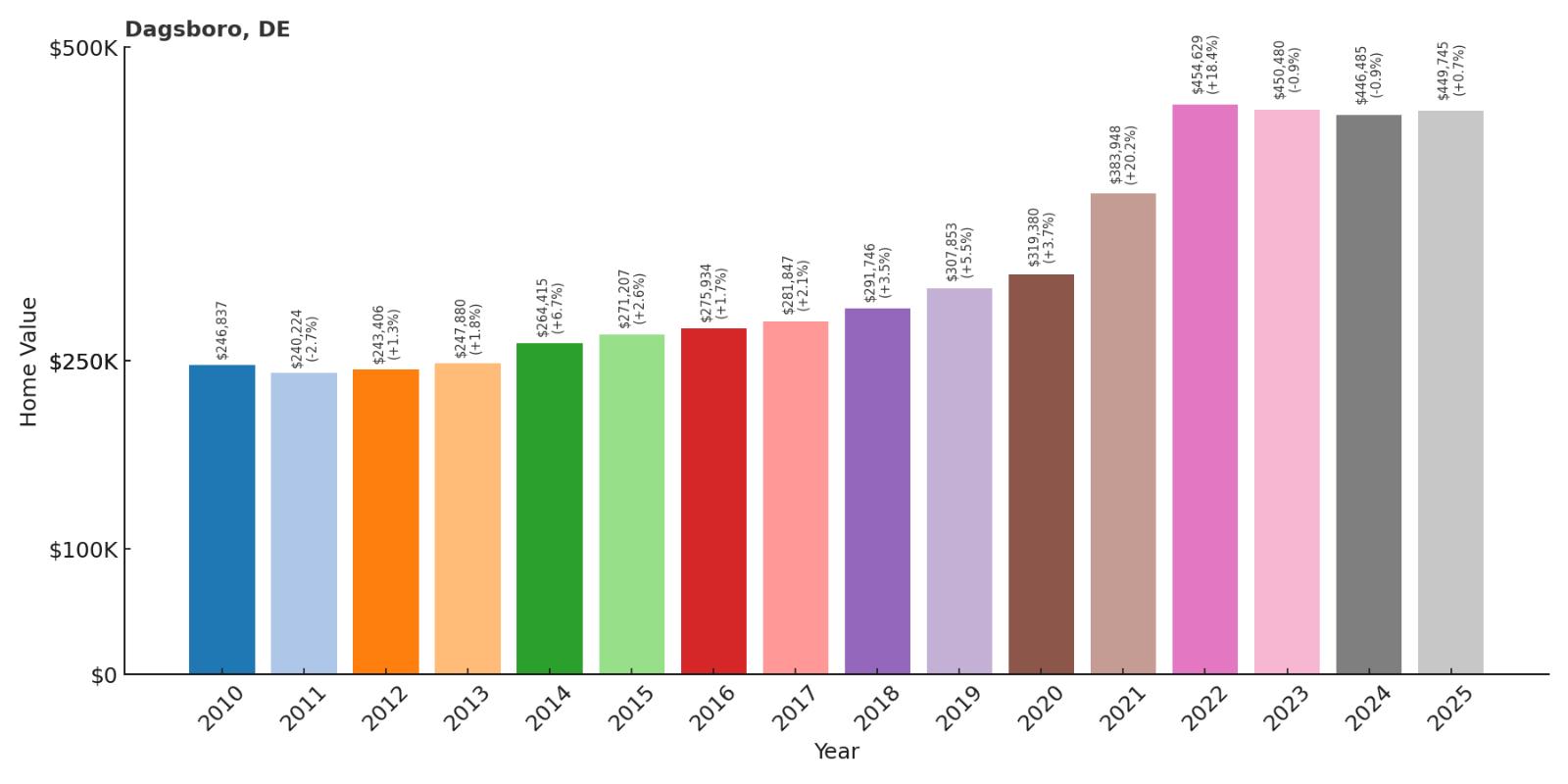
- 2010: $246,837
- 2011: $240,224
- 2012: $243,406
- 2013: $247,880
- 2014: $264,415
- 2015: $271,207
- 2016: $275,934
- 2017: $281,847
- 2018: $291,746
- 2019: $307,853
- 2020: $319,380
- 2021: $383,948
- 2022: $454,629
- 2023: $450,480
- 2024: $446,485
- 2025: $449,745
Dagsboro has gained 82% in value since 2010, with particularly dramatic appreciation during the pandemic years. The town saw values spike over 20% in 2021 and another 18% in 2022, reflecting intense demand for this inland Sussex County community. Current median prices of $449,745 position Dagsboro as an increasingly valuable alternative to coastal properties.
Why Dagsboro?
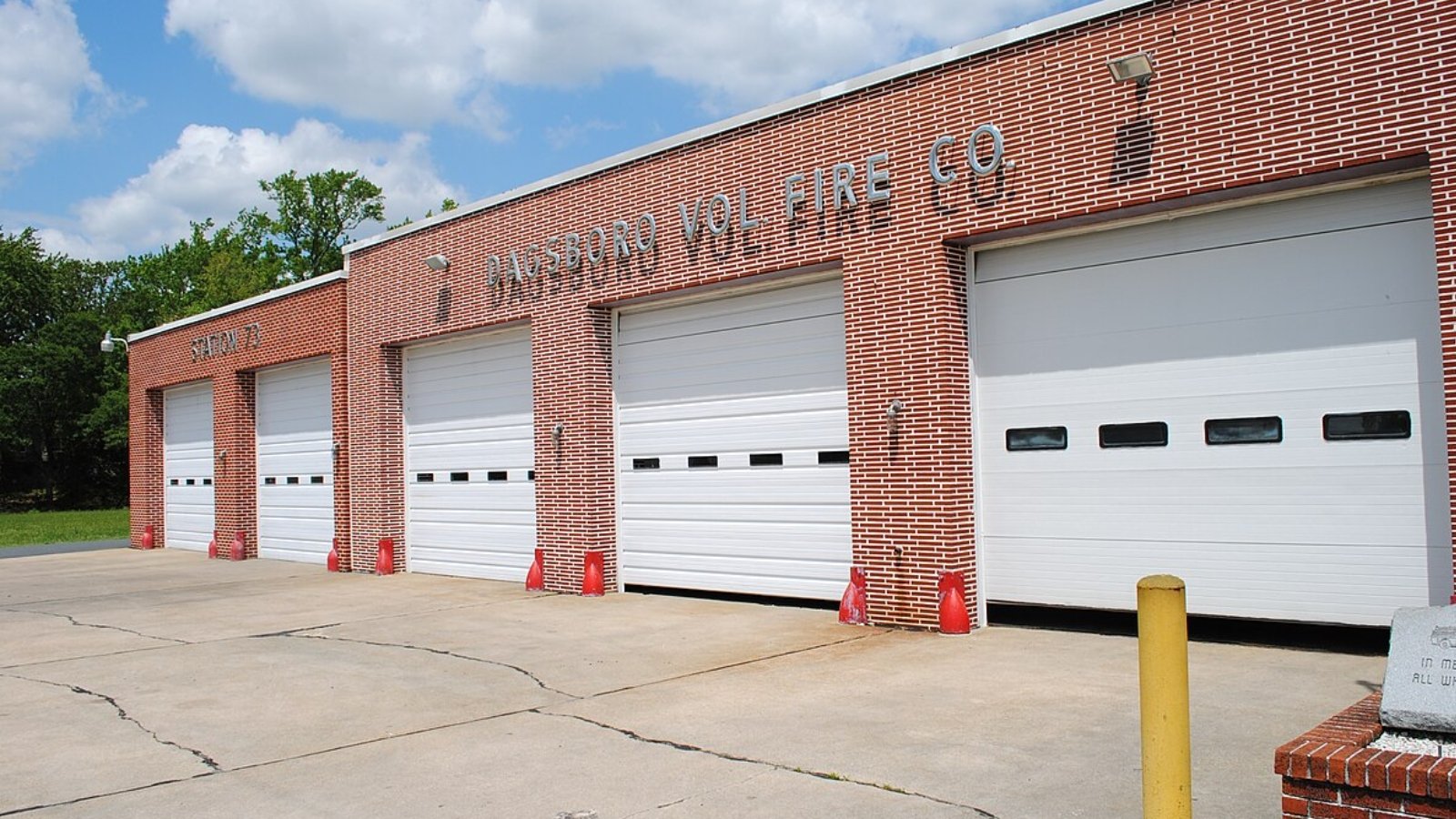
Why are people willing to pay so much to live here? What’s special about it?
Dagsboro attracts families and retirees seeking coastal Delaware living without oceanfront prices. The town offers a quiet, small-town atmosphere with easy access to Delaware beaches and Ocean City, Maryland. Residents appreciate the affordable housing compared to beachfront communities, friendly community spirit, and growing selection of local businesses and restaurants.
The area’s location provides the best of both worlds – close enough to beaches for regular visits yet far enough inland to avoid tourist crowds and high coastal prices. Dagsboro has become increasingly popular as coastal real estate prices have risen, offering similar lifestyle benefits at more accessible price points.
How Dagsboro Rose to Prominence
Dagsboro was founded in the late 1800s along the Pennsylvania Railroad line, serving as a shipping point for agricultural products from surrounding Sussex County farms. The town was named after the local Dagworthy family, prominent landowners who played important roles in the area’s early development.
The community’s modern prominence emerged as coastal Delaware development expanded inland and families began seeking alternatives to expensive beachfront properties. Dagsboro’s combination of small-town charm, affordable housing, and proximity to beaches made it increasingly attractive for both retirees and families seeking coastal lifestyle benefits.
3 Interesting Tidbits
1. Railroad Heritage – The town’s original prosperity came from shipping agricultural products via the Pennsylvania Railroad to markets in Philadelphia and Baltimore.
2. Dagworthy Legacy – The town was named after the influential Dagworthy family, whose members included colonial-era military leaders and prominent local landowners.
3. Strawberry Capital – Dagsboro was once known for its extensive strawberry farms that supplied fresh berries to Philadelphia and New York markets via railroad shipping.
15. Frankford – 89% Home Price Increase Since 2010
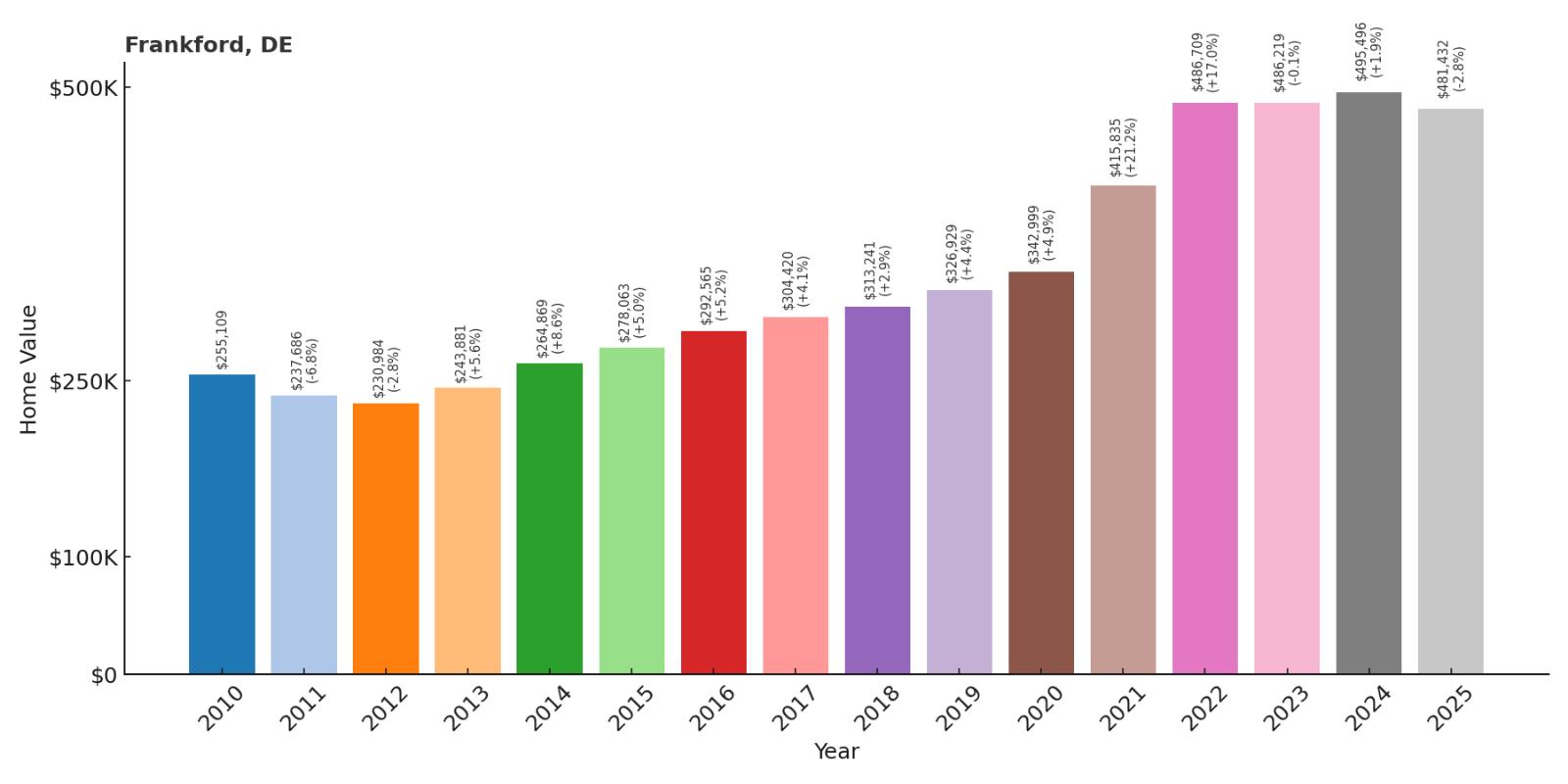
- 2010: $255,109
- 2011: $237,686
- 2012: $230,984
- 2013: $243,881
- 2014: $264,869
- 2015: $278,063
- 2016: $292,565
- 2017: $304,420
- 2018: $313,241
- 2019: $326,929
- 2020: $342,999
- 2021: $415,835
- 2022: $486,709
- 2023: $486,219
- 2024: $495,496
- 2025: $481,432
Frankford has gained 89% in value since 2010, with explosive growth during the pandemic years. The town experienced dramatic appreciation in 2021-2022, with values increasing over 38% in just two years. Current median prices of $481,432 reflect Frankford’s transformation into one of inland Sussex County’s most valuable residential markets.
Why Frankford?
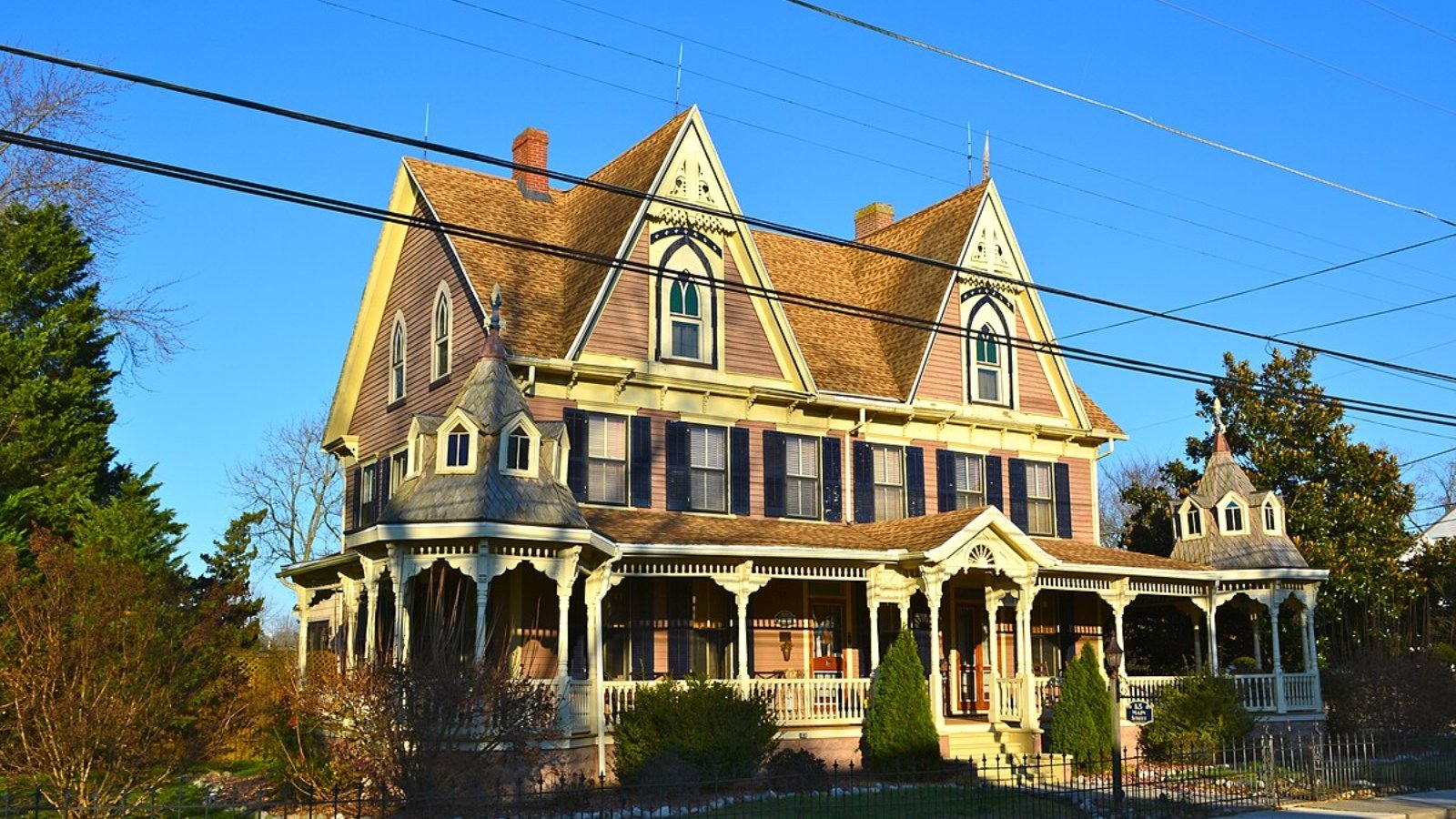
Why are people willing to pay so much to live here? What’s special about it?
Frankford appeals to families and retirees seeking coastal Delaware lifestyle benefits without oceanfront costs. The town offers a charming small-town atmosphere with historic buildings, local shops, and community events while providing easy access to Delaware beaches and Ocean City. Residents value the strong community spirit, affordable living compared to beachfront areas, and growing selection of dining and shopping options.
The community’s location provides convenient access to multiple beach destinations while maintaining lower cost of living and less tourist congestion than coastal towns. Frankford has attracted residents seeking authentic small-town character with modern amenities and reasonable commuting distance to employment centers.
How Frankford Rose to Prominence
Frankford was incorporated in 1889 and served as an important railroad town along the Pennsylvania Railroad line connecting the Delmarva Peninsula to Philadelphia. The town was named after Frankfurt, Germany, reflecting the German heritage of many early settlers who came to farm the rich Sussex County soil.
The community’s prominence grew as coastal development expanded inland and families began seeking alternatives to expensive beachfront properties. Frankford’s combination of historic character, available land for development, and proximity to beaches made it increasingly attractive for residential growth throughout the late 20th and early 21st centuries.
3 Interesting Tidbits
1. German Heritage – The town was settled largely by German immigrants who brought their farming expertise to Sussex County’s fertile agricultural lands.
2. Railroad Hub – Frankford’s depot served as a major shipping point for agricultural products traveling from Delmarva farms to Philadelphia and New York markets.
3. Historic Main Street – Many of the town’s original late-1800s commercial buildings still line Main Street, creating an authentic small-town atmosphere that attracts residents and visitors.
14. Milton – 93% Home Price Increase Since 2010
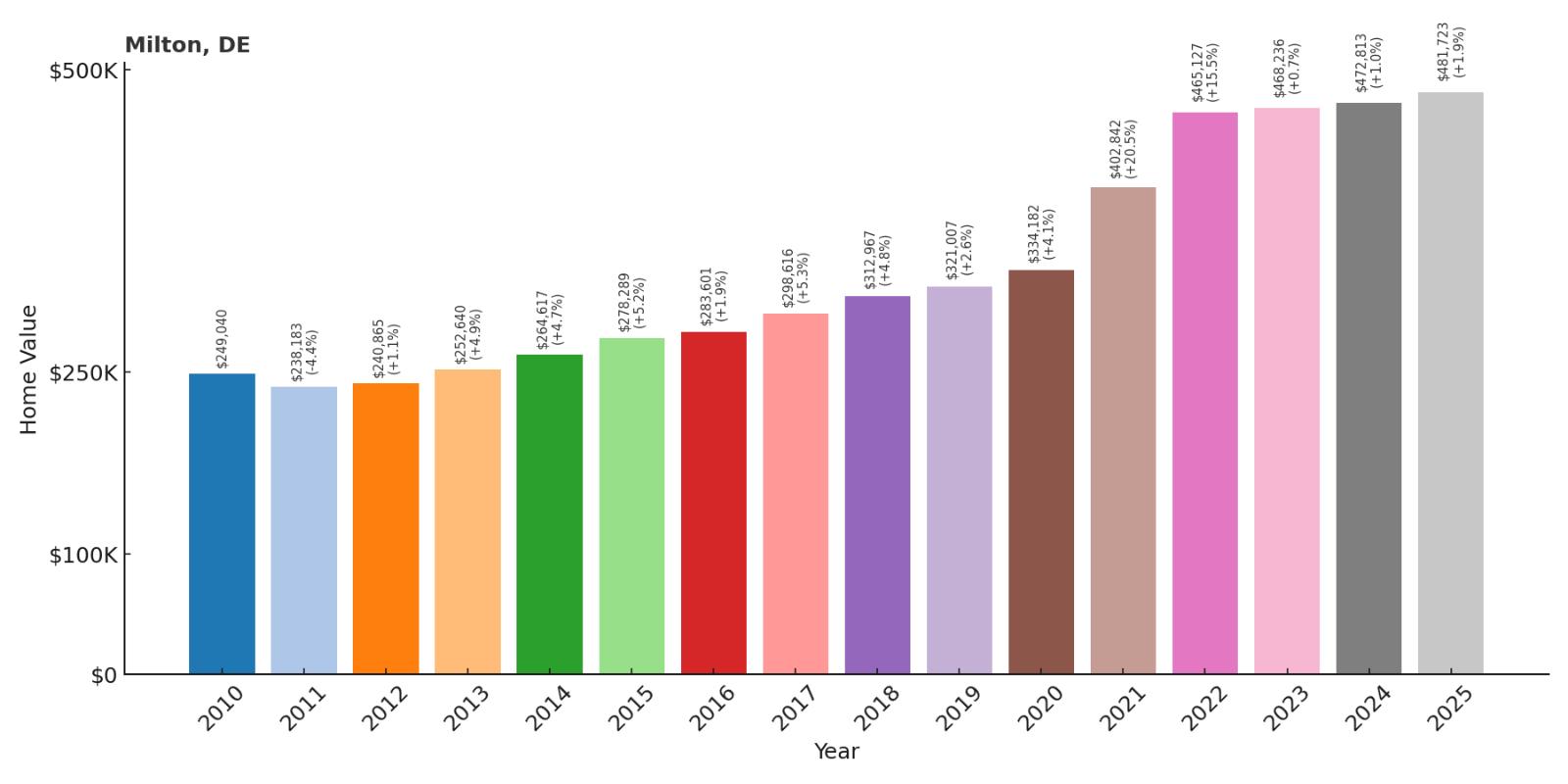
- 2010: $249,040
- 2011: $238,183
- 2012: $240,865
- 2013: $252,640
- 2014: $264,617
- 2015: $278,289
- 2016: $283,601
- 2017: $298,616
- 2018: $312,967
- 2019: $321,007
- 2020: $334,182
- 2021: $402,842
- 2022: $465,127
- 2023: $468,236
- 2024: $472,813
- 2025: $481,723
Milton has nearly doubled in value since 2010, gaining 93% over the past 15 years with dramatic acceleration during the pandemic era. The town experienced exceptional growth in 2021-2022, with values increasing over 35% in just two years. Current median prices of $481,723 reflect Milton’s emergence as one of Delaware’s most desirable inland communities.
Why Milton?

Why are people willing to pay so much to live here? What’s special about it?
Milton attracts residents seeking authentic small-town charm with modern amenities and cultural sophistication. The historic downtown features art galleries, boutique shops, craft breweries, and award-winning restaurants that create a vibrant community atmosphere. Families and retirees appreciate the walkable downtown, regular festivals and events, and easy access to both Lewes beaches and Rehoboth without the tourist crowds.
The town’s location along the Broadkill River provides scenic beauty and recreational opportunities while maintaining convenient access to coastal destinations. Milton has successfully balanced preservation of its historic character with welcoming new businesses and residents who value quality of life and community engagement.
How Milton Rose to Prominence
Milton was founded in 1672 and originally served as a major shipbuilding center along the Broadkill River, with shipyards producing vessels that sailed throughout the Atlantic. The town was named after the English poet John Milton and became Sussex County’s county seat from 1680 to 1791.
The community’s modern prominence emerged as it transformed from a quiet agricultural town into a thriving arts and cultural destination. Milton’s combination of preserved historic architecture, riverside location, and growing reputation for dining and arts attracted residents seeking authentic character and community engagement.
3 Interesting Tidbits
1. Shipbuilding Legacy – Milton’s shipyards built over 200 vessels between 1760 and 1880, including ships that served in the War of 1812 and Civil War.
2. Former County Seat – Milton served as Sussex County’s government center for over a century, with the old courthouse building still standing as a reminder of its political importance.
3. Craft Beer Destination – The town has become known for its craft breweries and distilleries, creating a food and beverage tourism industry that attracts visitors from across the region.
13. Townsend – 81% Home Price Increase Since 2010
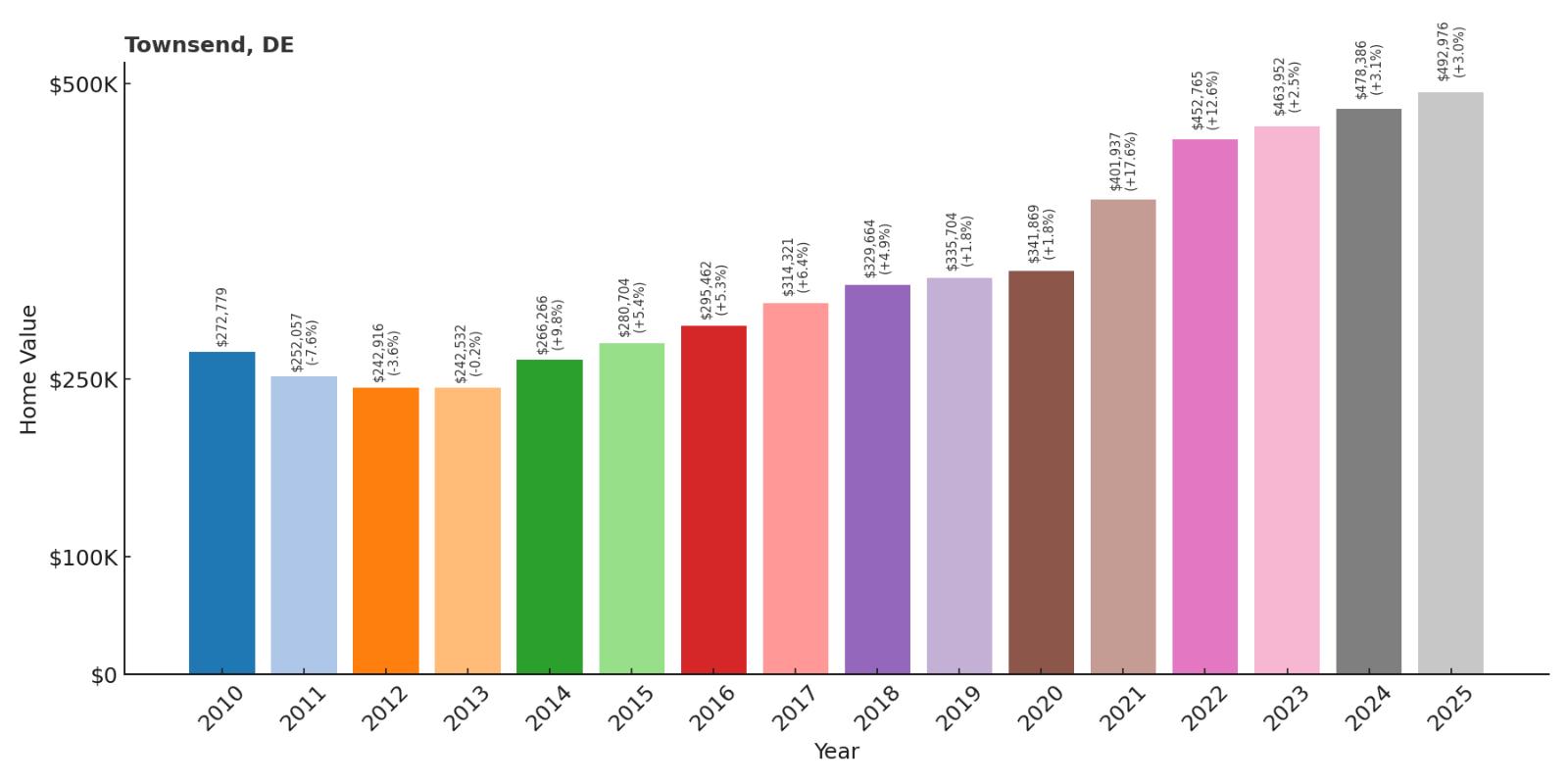
- 2010: $272,779
- 2011: $252,057
- 2012: $242,916
- 2013: $242,532
- 2014: $266,266
- 2015: $280,704
- 2016: $295,462
- 2017: $314,321
- 2018: $329,664
- 2019: $335,704
- 2020: $341,869
- 2021: $401,937
- 2022: $452,765
- 2023: $463,952
- 2024: $478,386
- 2025: $492,976
Townsend has gained 81% in value since 2010, with particularly strong appreciation during the pandemic years. The town experienced significant growth from 2021-2022, with values increasing over 30% in just two years. Current median prices of $492,976 reflect Townsend’s position as one of New Castle County’s most rapidly appreciating communities.
Why Townsend?
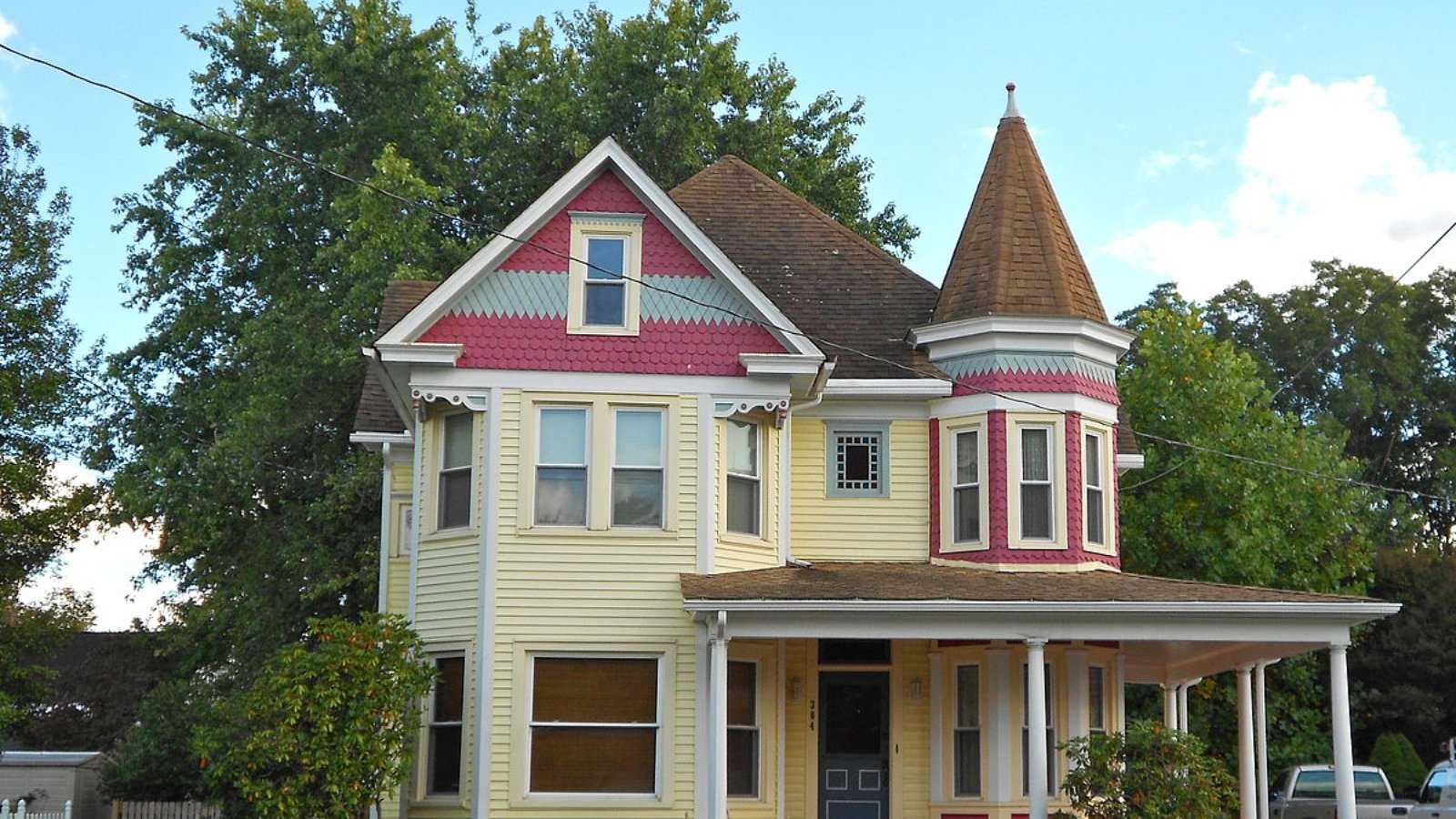
Why are people willing to pay so much to live here? What’s special about it?
Townsend appeals to families seeking new construction homes with modern amenities in a well-planned community setting. The area offers excellent schools, safe neighborhoods, and convenient access to both Wilmington and Dover employment centers. Residents appreciate the newer housing stock, planned community amenities like parks and trails, and the family-friendly atmosphere that comes with thoughtful development.
The community’s strategic location provides easy commuting to major employment centers while maintaining a suburban feel with plenty of green space. Townsend has attracted families seeking modern homes with contemporary floor plans and energy efficiency that older communities often can’t provide.
How Townsend Rose to Prominence
Townsend developed as a planned suburban community during the late 20th century residential boom in New Castle County. The area was largely agricultural until developers recognized its potential for large-scale residential development that could serve families seeking alternatives to more expensive northern communities.
The community’s prominence grew rapidly as one of Delaware’s most successful master-planned developments, attracting families from across the region who were drawn to its combination of new construction, good schools, and convenient location. Townsend’s careful planning and infrastructure development made it a model for suburban growth in central Delaware.
3 Interesting Tidbits
1. Master-Planned Success – Townsend represents one of Delaware’s most successful examples of large-scale planned community development, with coordinated infrastructure and amenities.
2. Rapid Growth – The community has grown from farmland to thousands of homes in just a few decades, making it one of the fastest-developing areas in New Castle County.
3. Modern Infrastructure – Townsend was built with contemporary utilities, wide streets, and planned green spaces that set it apart from older Delaware communities that grew organically.
12. Slaughter Beach – 77.3% Home Price Increase Since 2018
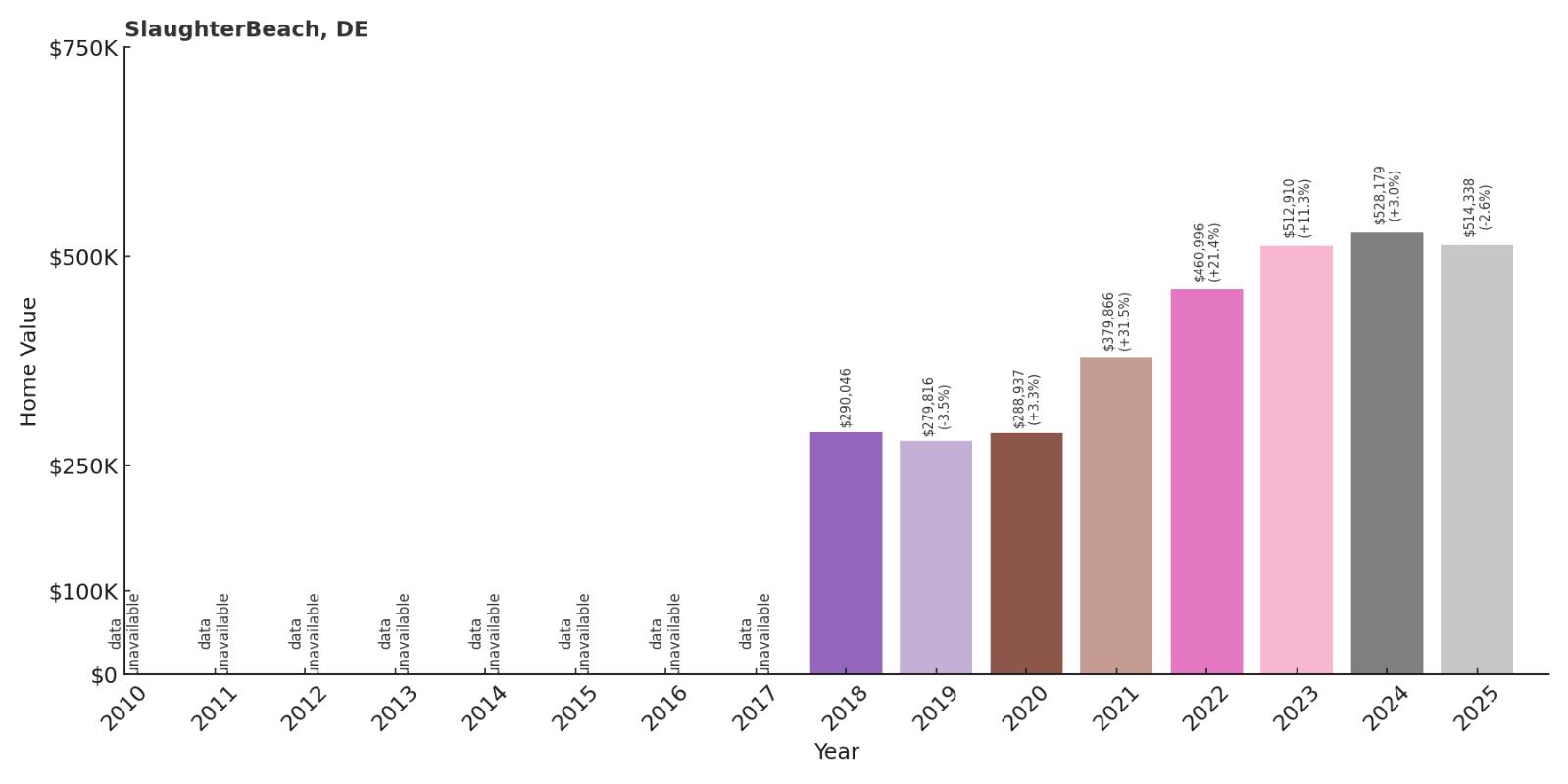
- 2010: N/A
- 2011: N/A
- 2012: N/A
- 2013: N/A
- 2014: N/A
- 2015: N/A
- 2016: N/A
- 2017: N/A
- 2018: $290,046
- 2019: $279,816
- 2020: $288,937
- 2021: $379,866
- 2022: $460,996
- 2023: $512,910
- 2024: $528,179
- 2025: $514,338
Slaughter Beach has shown dramatic appreciation since 2018, gaining over 77% in just seven years. The community experienced explosive growth from 2020-2023, with values nearly doubling during this period. Current median prices of $514,338 reflect intense demand for this unique Delaware Bay waterfront community.
Why Slaughter Beach?
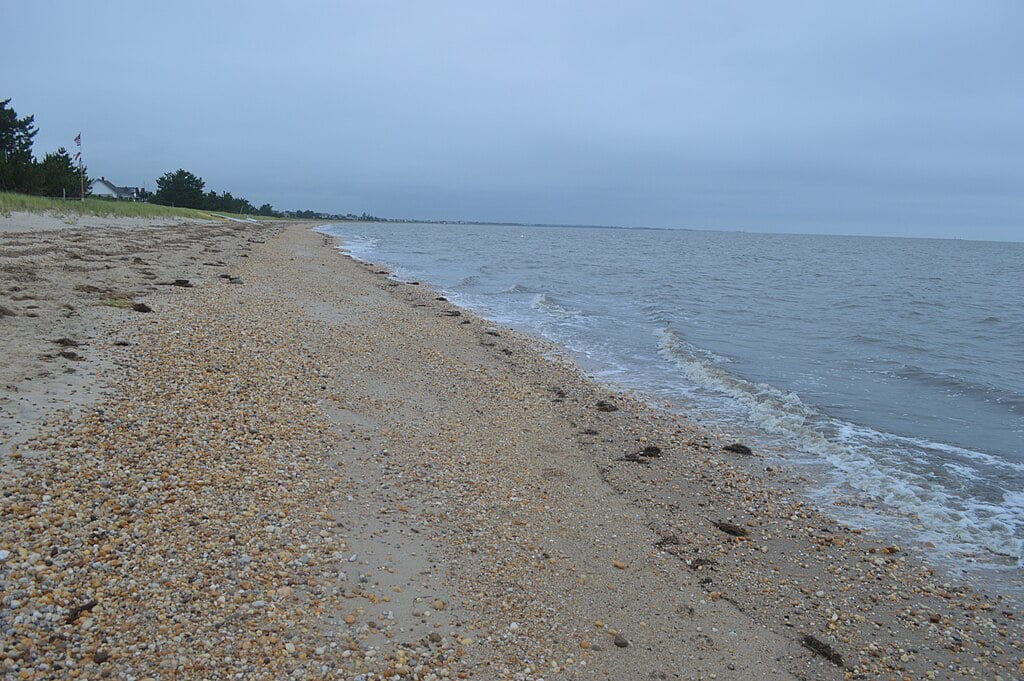
Why are people willing to pay so much to live here? What’s special about it?
Slaughter Beach offers exclusive waterfront living along the Delaware Bay with stunning sunset views and direct water access. The small community provides a peaceful retreat atmosphere with private beaches, excellent fishing, and boating opportunities while maintaining proximity to inland amenities. Residents value the secluded feel, natural beauty, and tight-knit community that comes with living in one of Delaware’s most distinctive waterfront enclaves.
Unlike crowded ocean beaches, Slaughter Beach offers tranquil bay waters perfect for kayaking, fishing, and wildlife watching, particularly during horseshoe crab spawning season. The community attracts those seeking authentic waterfront lifestyle without the commercialization of more developed beach towns.
How Slaughter Beach Rose to Prominence
Slaughter Beach was named after William Slaughter, a local postmaster in the early 1900s, dispelling any sinister connotations of its unusual name. The community developed as a fishing and farming village along the Delaware Bay, taking advantage of the rich waters and fertile marshlands.
The area’s prominence as a residential destination emerged as waterfront properties became increasingly scarce and expensive elsewhere in Delaware. Slaughter Beach’s combination of authentic bay front location, natural beauty, and relative affordability compared to ocean beaches made it increasingly attractive to buyers seeking unique waterfront experiences.
3 Interesting Tidbits
1. Horseshoe Crab Haven – The beach is famous for massive horseshoe crab spawning events that attract thousands of migratory birds and nature enthusiasts each spring.
2. Postmaster’s Legacy – The town’s unusual name comes from early postmaster William Slaughter, not any violent history as many visitors assume.
3. Sunset Paradise – The westward-facing Delaware Bay location provides some of the most spectacular sunset views available anywhere along the Delaware coast.
11. Middletown – 107% Home Price Increase Since 2010
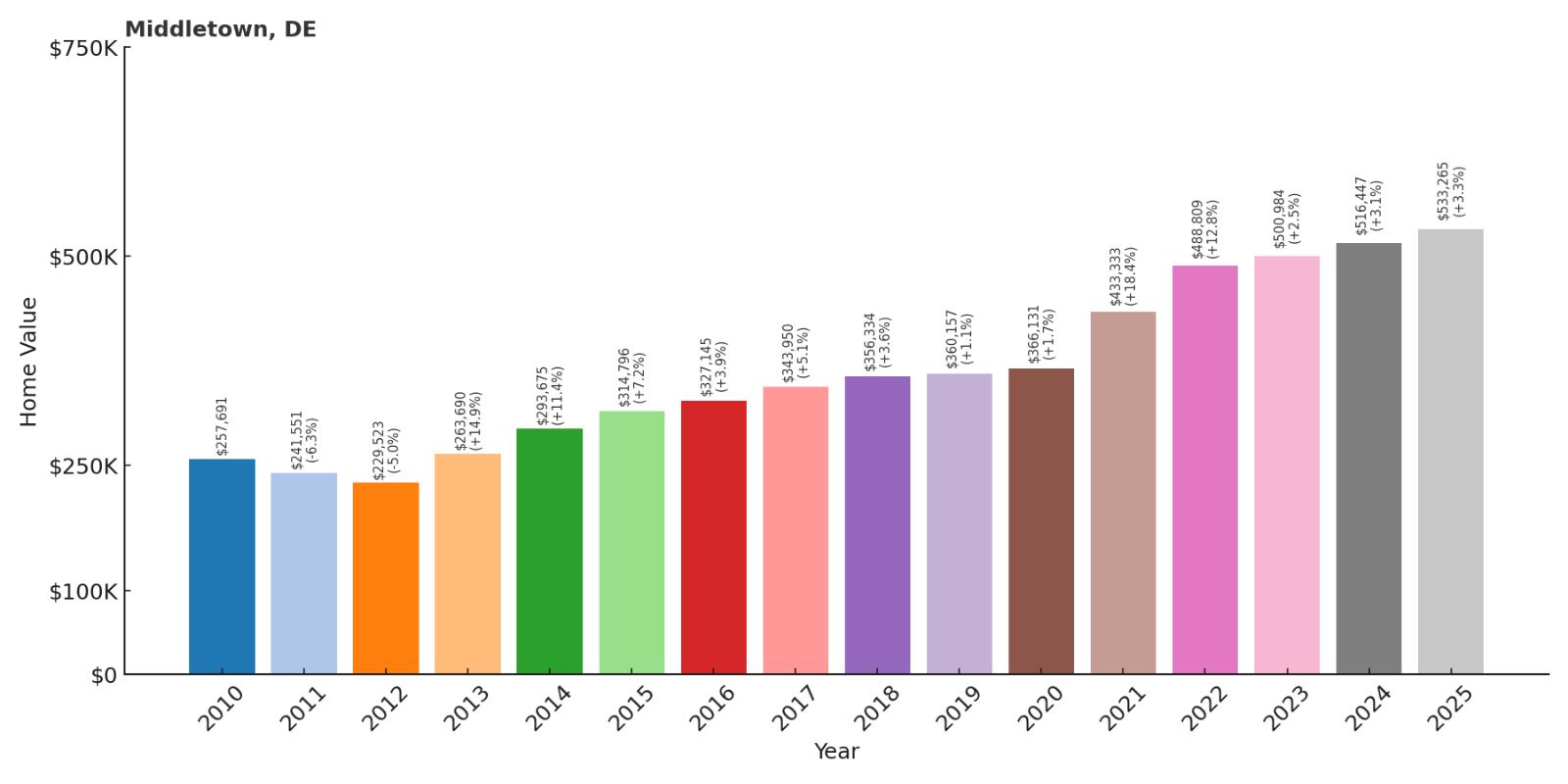
- 2010: $257,691
- 2011: $241,551
- 2012: $229,523
- 2013: $263,690
- 2014: $293,675
- 2015: $314,796
- 2016: $327,145
- 2017: $343,950
- 2018: $356,334
- 2019: $360,157
- 2020: $366,131
- 2021: $433,333
- 2022: $488,809
- 2023: $500,984
- 2024: $516,447
- 2025: $533,265
Middletown has more than doubled in value since 2010, gaining an impressive 107% over the past 15 years. The town experienced particularly strong growth during the pandemic era, with values increasing over 33% from 2021-2022. Current median prices of $533,265 reflect Middletown’s transformation into one of Delaware’s premier suburban communities.
Why Middletown?
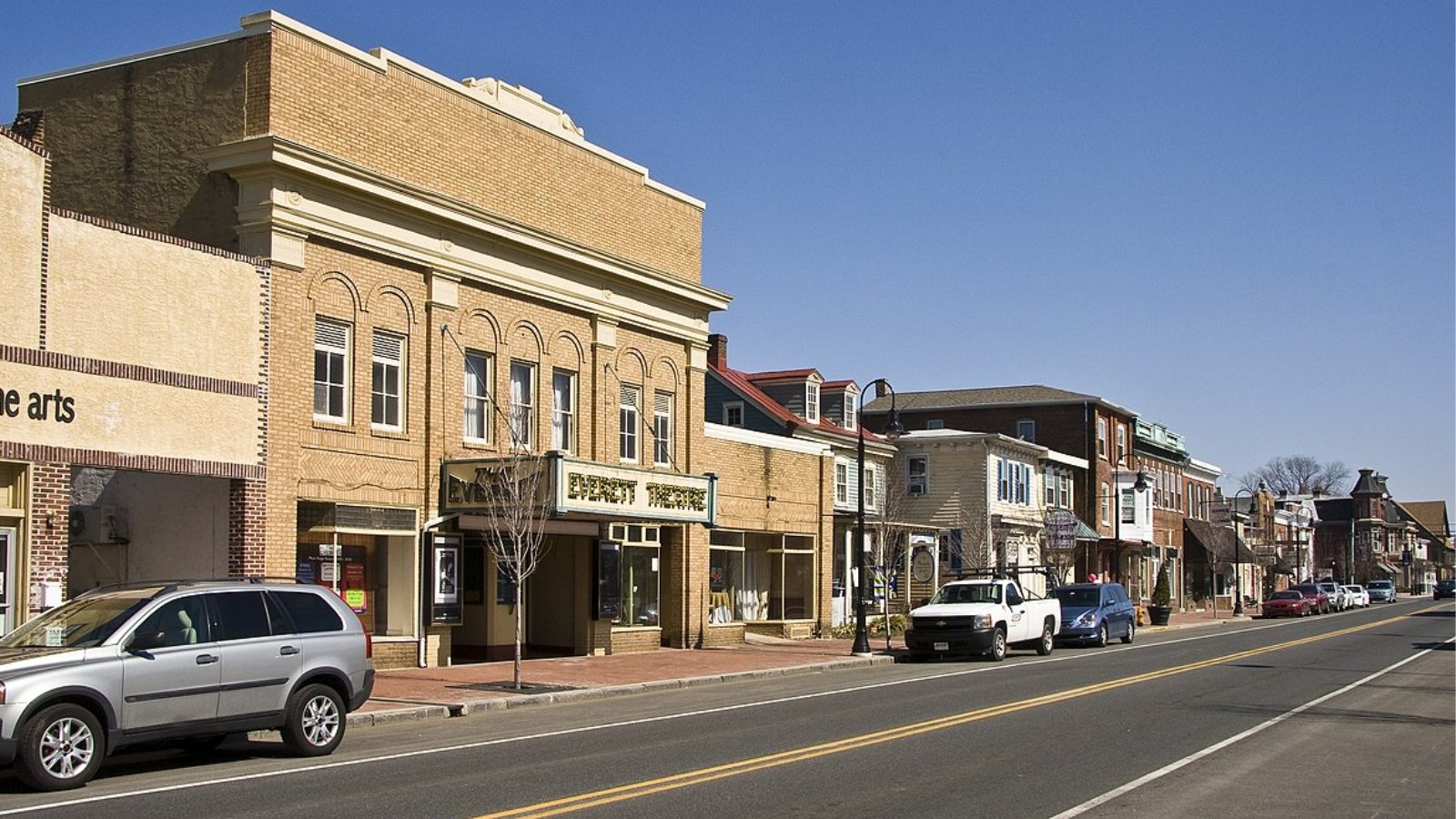
Why are people willing to pay so much to live here? What’s special about it?
Middletown attracts families seeking modern suburban living with excellent schools and comprehensive community amenities. The town offers new construction neighborhoods, well-planned infrastructure, and convenient access to both Wilmington and Dover employment centers. Residents appreciate the family-friendly atmosphere, quality schools, and abundance of parks, shopping, and dining options that create a complete suburban lifestyle.
The community’s strategic location provides easy commuting to major employment centers while maintaining affordable housing compared to northern Delaware counties. Middletown has successfully managed rapid growth to create a cohesive community with modern amenities and strong property values.
How Middletown Rose to Prominence
Middletown was originally founded in the 1600s as a crossroads settlement between the Delaware River and Chesapeake Bay, earning its name from being roughly halfway between these two major waterways. The town served as an important stop on colonial trade routes connecting the Atlantic and Chesapeake regions.
The community’s modern prominence emerged during the suburban boom of recent decades as one of Delaware’s most successful examples of planned growth. Middletown’s combination of historic character, available land, and strategic location made it attractive for large-scale residential development that transformed it from a small town into a major suburban center.
3 Interesting Tidbits
1. Crossroads Heritage – The town’s name reflects its historic role as the midpoint between Delaware River and Chesapeake Bay shipping routes during colonial times.
2. Growth Champion – Middletown has been one of the fastest-growing communities in Delaware, expanding from fewer than 7,000 residents in 2000 to over 25,000 today.
3. Historic Downtown – Despite rapid suburban growth, Middletown has preserved its historic downtown area with colonial-era buildings and traditional Main Street character.
10. Selbyville – 85% Home Price Increase Since 2010
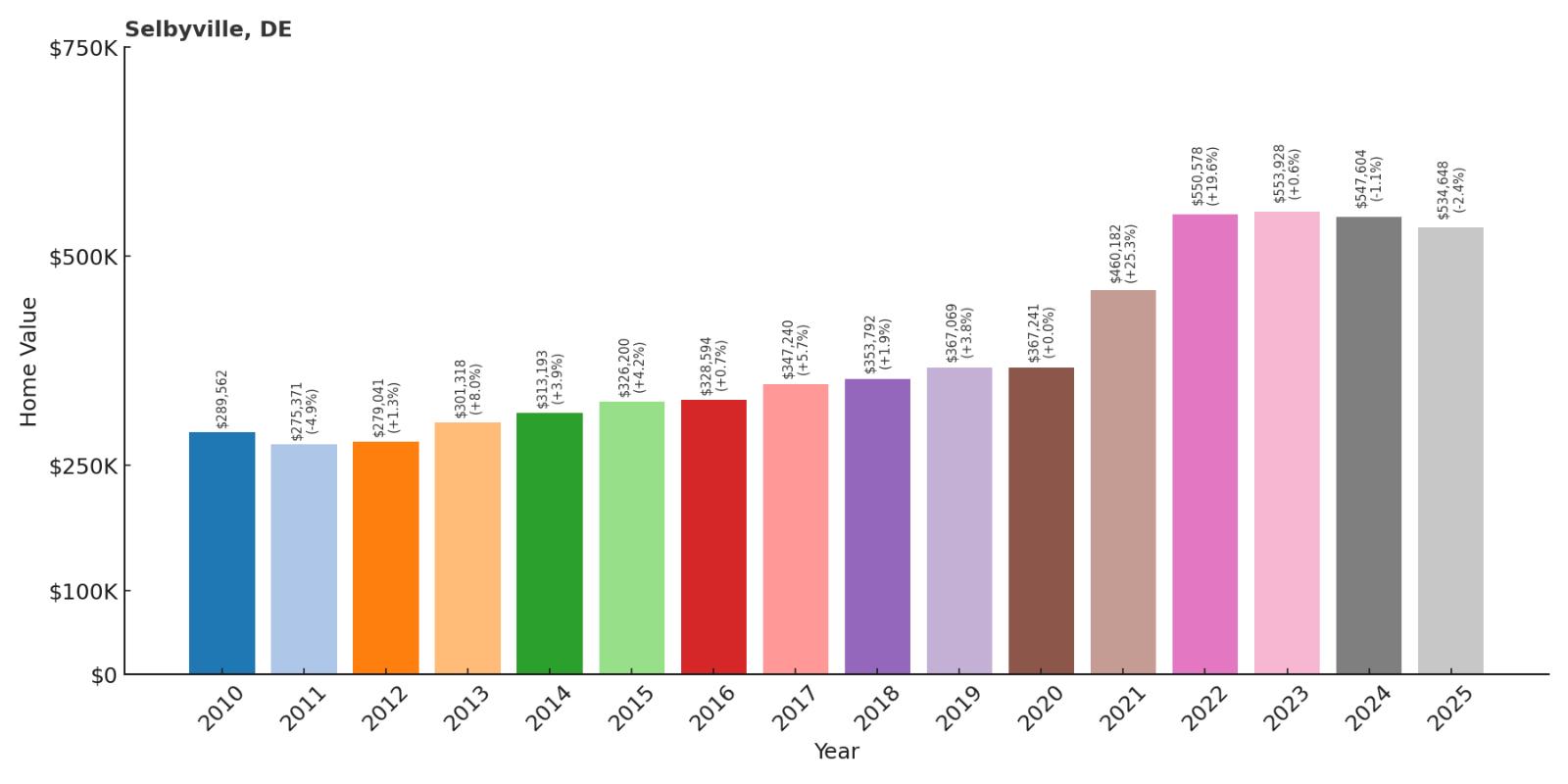
- 2010: $289,562
- 2011: $275,371
- 2012: $279,041
- 2013: $301,318
- 2014: $313,193
- 2015: $326,200
- 2016: $328,594
- 2017: $347,240
- 2018: $353,792
- 2019: $367,069
- 2020: $367,241
- 2021: $460,182
- 2022: $550,578
- 2023: $553,928
- 2024: $547,604
- 2025: $534,648
Selbyville has gained 85% in value since 2010, with explosive growth during the pandemic years. The town experienced dramatic appreciation from 2021-2022, with values increasing over 45% in just two years. Current median prices of $534,648 reflect Selbyville’s position as one of southern Delaware’s most valuable inland communities.
Why Selbyville?
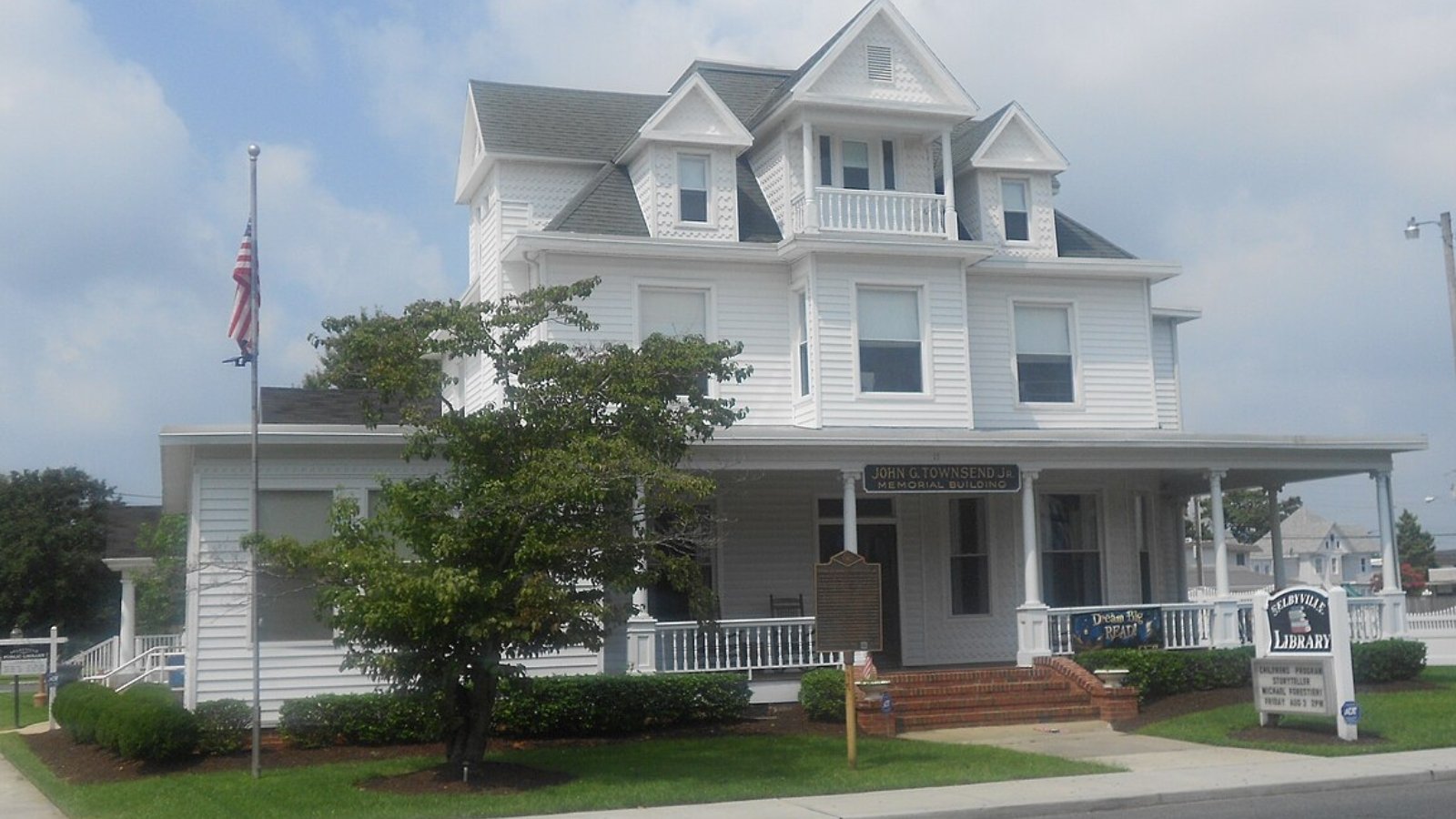
Why are people willing to pay so much to live here? What’s special about it?
Selbyville appeals to families and retirees seeking coastal Delaware lifestyle benefits without oceanfront costs. The town offers easy access to Delaware beaches and Ocean City while maintaining a small-town atmosphere with local shops, restaurants, and community events. Residents value the central location that provides convenient access to multiple beach destinations and the growing selection of amenities as the community continues to develop.
The area’s location near the Delaware-Maryland border provides access to employment and recreational opportunities in both states while maintaining lower costs than beachfront communities. Selbyville has attracted residents seeking authentic small-town character with modern conveniences and reasonable commuting distance to coastal destinations.
How Selbyville Rose to Prominence
Selbyville was incorporated in 1906 and developed as a railroad town along the Pennsylvania Railroad line connecting the Delmarva Peninsula to major markets. The town was named after Selby Hickman, a local landowner who donated land for the railroad depot and encouraged commercial development.
The community’s prominence grew as coastal development expanded inland and families began seeking alternatives to expensive beachfront properties. Selbyville’s combination of small-town charm, available land for development, and proximity to beaches made it increasingly attractive for both residential and commercial growth.
3 Interesting Tidbits
1. Railroad Origins – The town developed around a Pennsylvania Railroad depot that served as a major shipping point for agricultural products from southern Delaware and Maryland’s Eastern Shore.
2. Border Town – Selbyville sits just three miles from the Maryland border, giving residents easy access to Ocean City and other Maryland Eastern Shore destinations.
3. Agricultural Hub – The town remains surrounded by active farmland, particularly poultry operations that make Sussex County one of the nation’s largest chicken-producing regions.
9. Harbeson – 94% Home Price Increase Since 2010
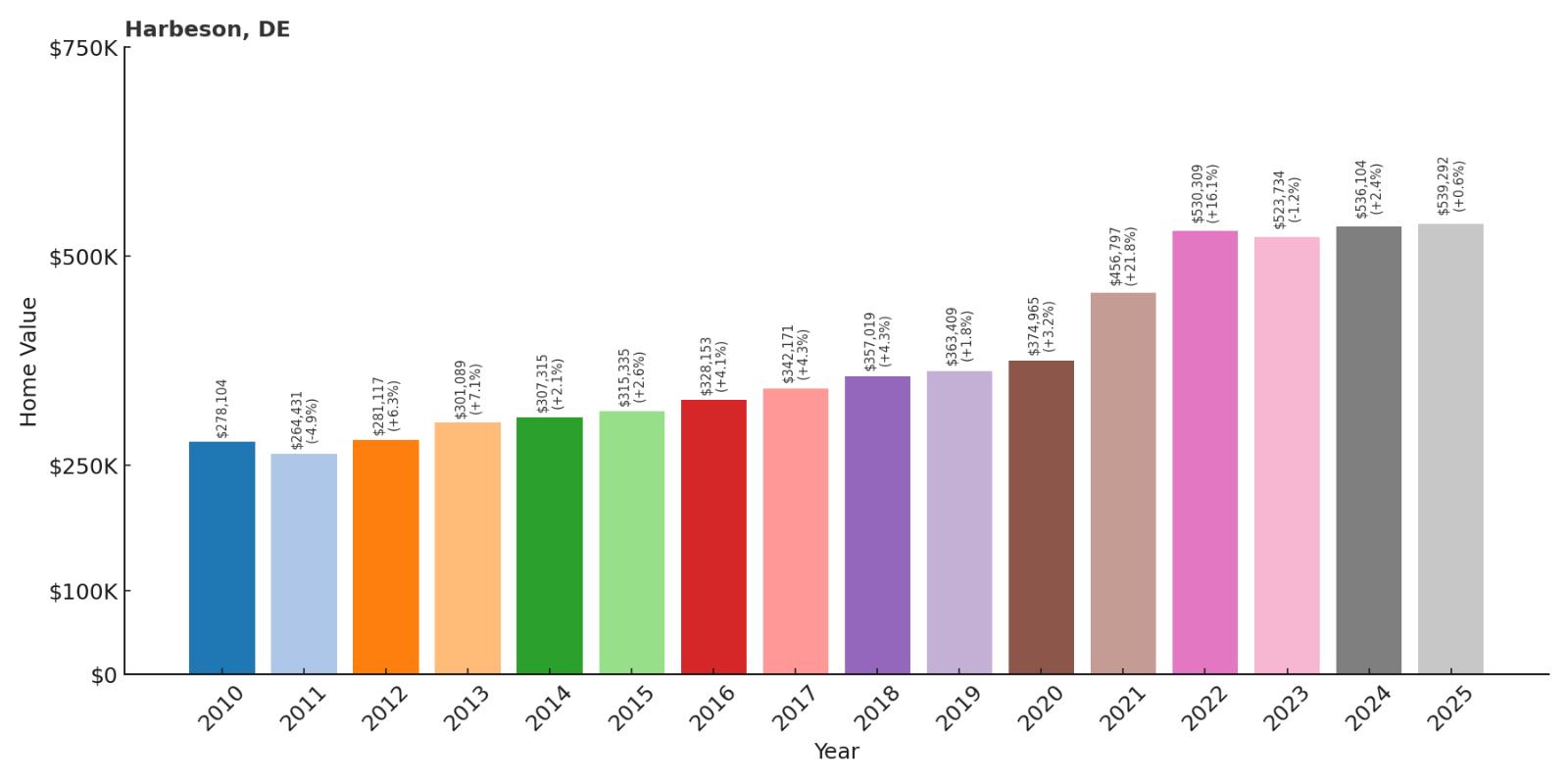
- 2010: $278,104
- 2011: $264,431
- 2012: $281,117
- 2013: $301,089
- 2014: $307,315
- 2015: $315,335
- 2016: $328,153
- 2017: $342,171
- 2018: $357,019
- 2019: $363,409
- 2020: $374,965
- 2021: $456,797
- 2022: $530,309
- 2023: $523,734
- 2024: $536,104
- 2025: $539,292
Harbeson has nearly doubled in value since 2010, gaining 94% over the past 15 years with particularly strong appreciation during the pandemic era. The community experienced explosive growth from 2021-2022, with values increasing over 38% in just two years. Current median prices of $539,292 reflect Harbeson’s emergence as one of inland Sussex County’s most valuable residential markets.
Why Harbeson?
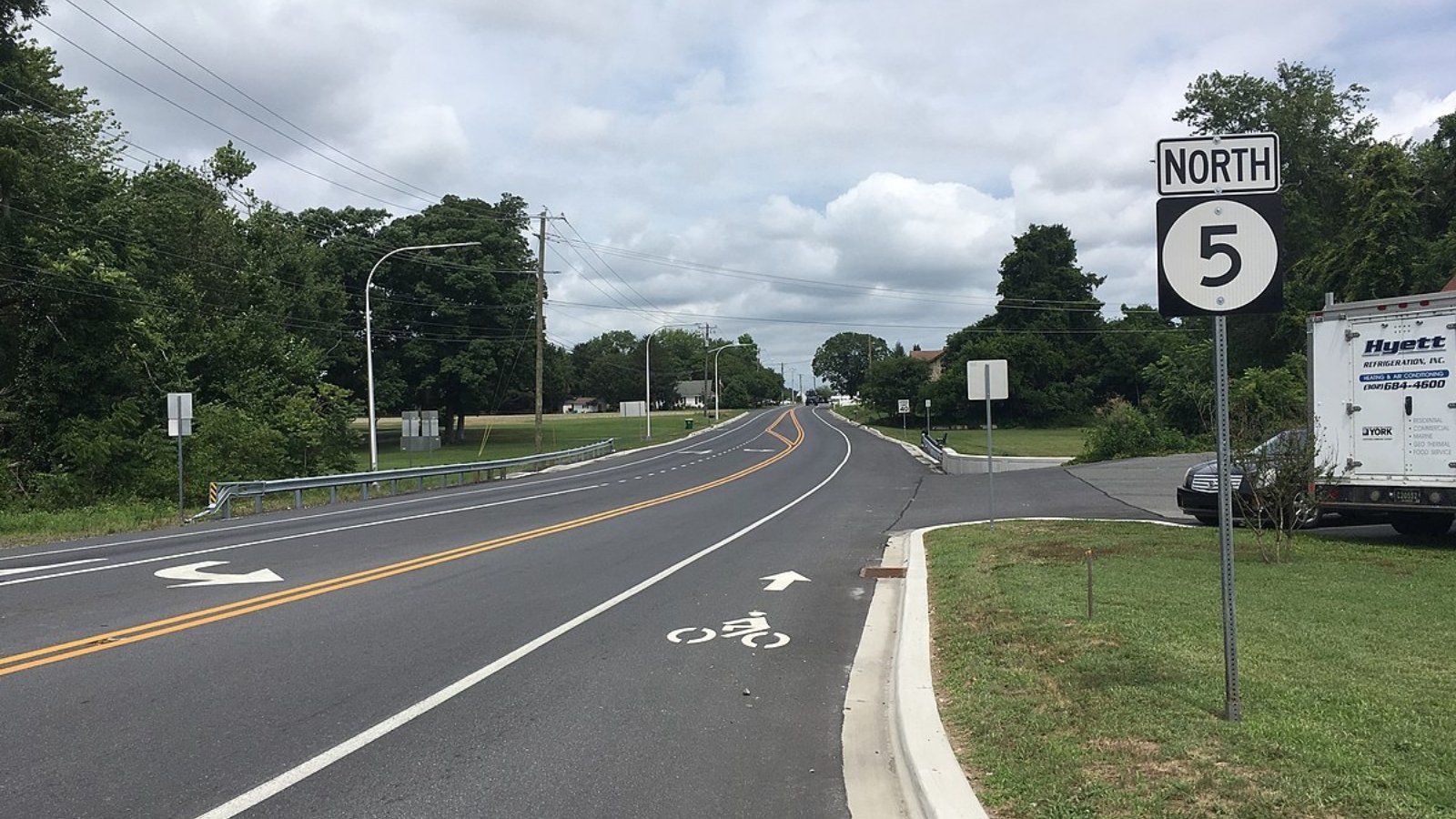
Why are people willing to pay so much to live here? What’s special about it?
Harbeson attracts families and retirees seeking peaceful rural living with convenient access to Delaware’s beaches and resort areas. The community offers large lots, newer construction, and a quiet countryside atmosphere while maintaining reasonable commuting distance to Rehoboth, Lewes, and other coastal destinations. Residents appreciate the lower cost of living compared to beachfront areas and the strong sense of community that comes with small-town living.
The area’s location provides the perfect balance of rural tranquility and coastal convenience, making it popular with those who want to enjoy beach activities without paying oceanfront premiums. Harbeson has attracted residents seeking space, value, and easy access to Delaware’s recreational opportunities.
How Harbeson Rose to Prominence
Harbeson developed as a small farming community in inland Sussex County, taking advantage of the area’s fertile soil and favorable growing conditions. The community was named after early settlers and remained primarily agricultural throughout most of its history.
The area’s prominence as a residential destination emerged as coastal development expanded inland and families began seeking alternatives to expensive beachfront properties. Harbeson’s combination of rural character, available land for development, and proximity to beaches made it increasingly attractive for residential growth throughout the early 21st century.
3 Interesting Tidbits
1. Agricultural Roots – Harbeson remains surrounded by active farmland, with corn, soybeans, and poultry operations defining much of the area’s rural character.
2. Beach Access – Despite its inland location, Harbeson provides convenient access to multiple Delaware beaches within a 20-30 minute drive.
3. Rural Character – The community has maintained its agricultural and rural atmosphere even as residential development has increased property values and attracted new residents.
8. Ocean View – 57% Home Price Increase Since 2010
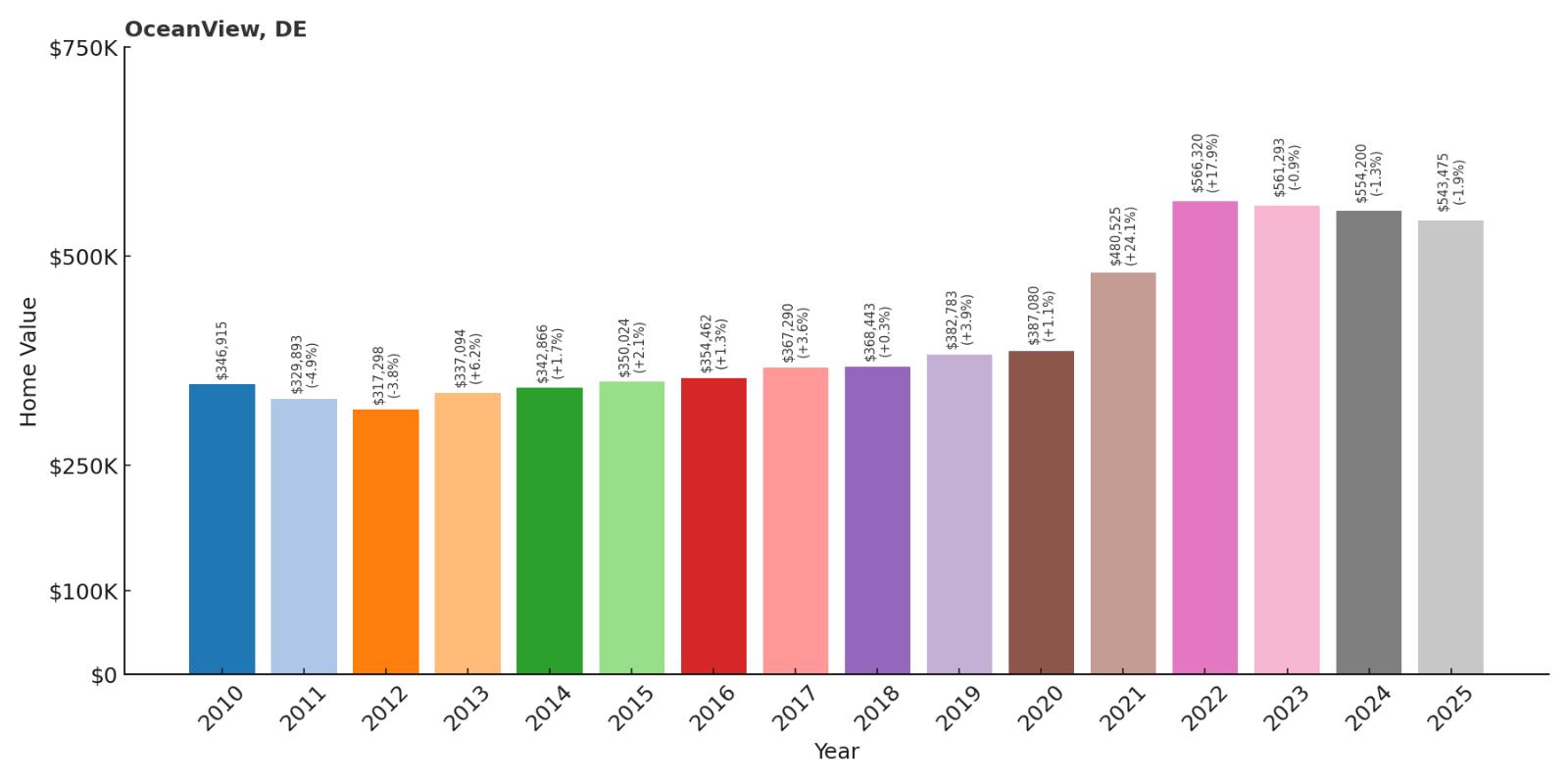
- 2010: $346,915
- 2011: $329,893
- 2012: $317,298
- 2013: $337,094
- 2014: $342,866
- 2015: $350,024
- 2016: $354,462
- 2017: $367,290
- 2018: $368,443
- 2019: $382,783
- 2020: $387,080
- 2021: $480,525
- 2022: $566,320
- 2023: $561,293
- 2024: $554,200
- 2025: $543,475
Ocean View has gained 57% in value since 2010, with dramatic acceleration during the pandemic years. The community experienced explosive growth from 2020-2022, with values increasing over 46% in just three years. Current median prices of $543,475 reflect Ocean View’s position as a premier coastal Delaware destination just inland from the ocean beaches.
Why Ocean View?
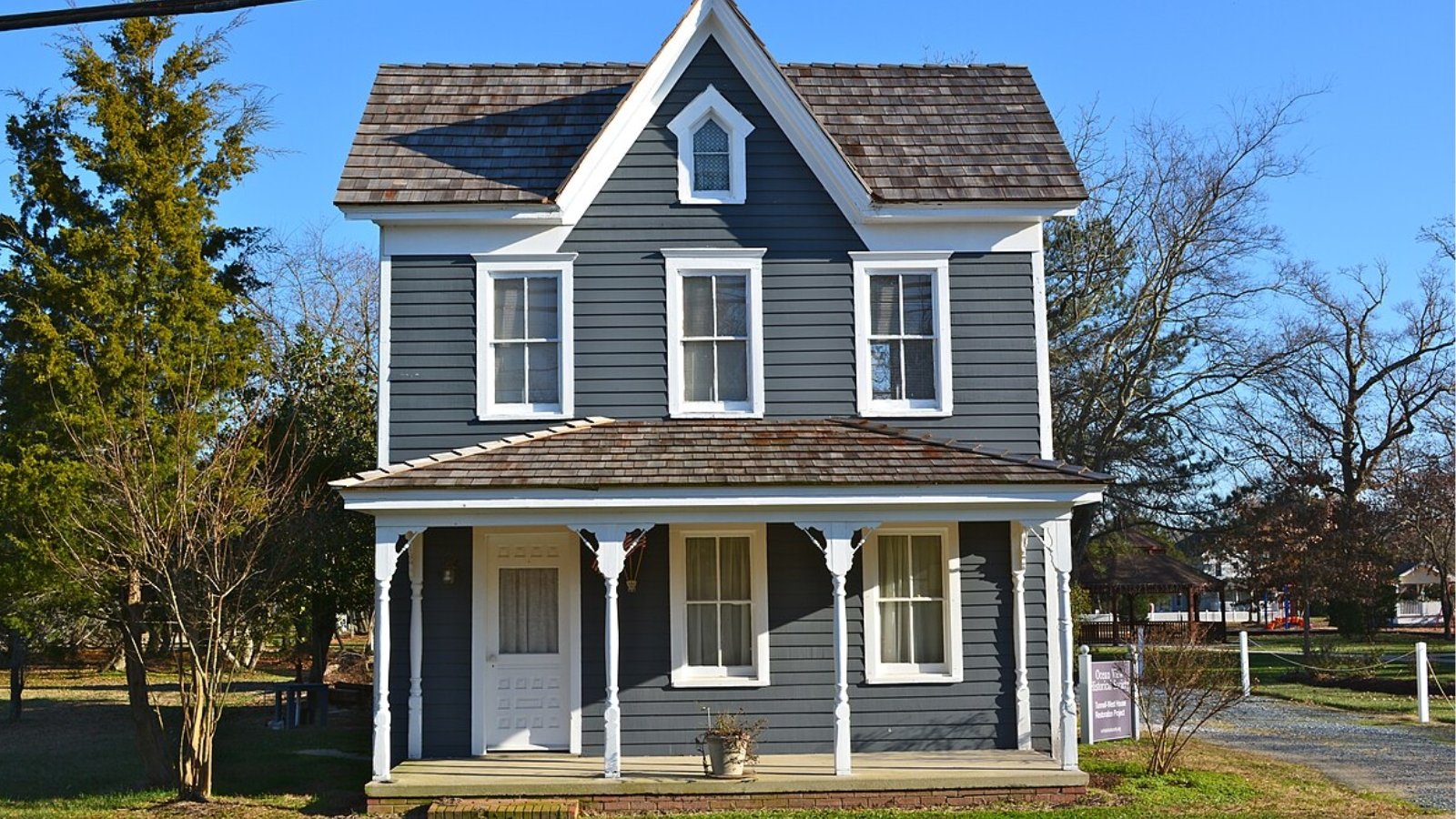
Why are people willing to pay so much to live here? What’s special about it?
Ocean View offers the ultimate coastal Delaware lifestyle with easy access to both ocean and bay waters. The community provides a relaxed beach town atmosphere with excellent restaurants, shops, and recreational facilities while maintaining more affordable housing than oceanfront locations. Residents enjoy quick access to Bethany Beach, direct bay access for boating and fishing, and a year-round community that doesn’t feel deserted in winter months.
The town’s location between the Atlantic Ocean and Indian River Bay provides unparalleled recreational opportunities, from surfing and beach activities to kayaking and fishing. Ocean View has successfully balanced growth with maintaining its laid-back coastal character that attracts both retirees and families seeking the beach lifestyle.
How Ocean View Rose to Prominence
Ocean View developed in the early 1900s as a small fishing and farming community taking advantage of both bay and ocean proximity. The town was named for its elevated location that provided views of the Atlantic Ocean, unusual for an inland community in flat coastal Delaware.
The community’s prominence grew as coastal Delaware became a major tourist and retirement destination, with Ocean View offering beach access without oceanfront prices. The town’s combination of water access, growing amenities, and central coastal location made it increasingly attractive for both seasonal and year-round residents.
3 Interesting Tidbits
1. Dual Water Access – Ocean View provides residents access to both the Atlantic Ocean and Indian River Bay, offering diverse recreational opportunities from surfing to kayaking.
2. Elevated Location – Unlike most coastal Delaware communities, Ocean View sits on slightly higher ground that historically provided ocean views, hence the town’s name.
3. Culinary Destination – The town has become known for its excellent restaurants that attract diners from across coastal Delaware and nearby Maryland.
7. Hockessin – 57% Home Price Increase Since 2010
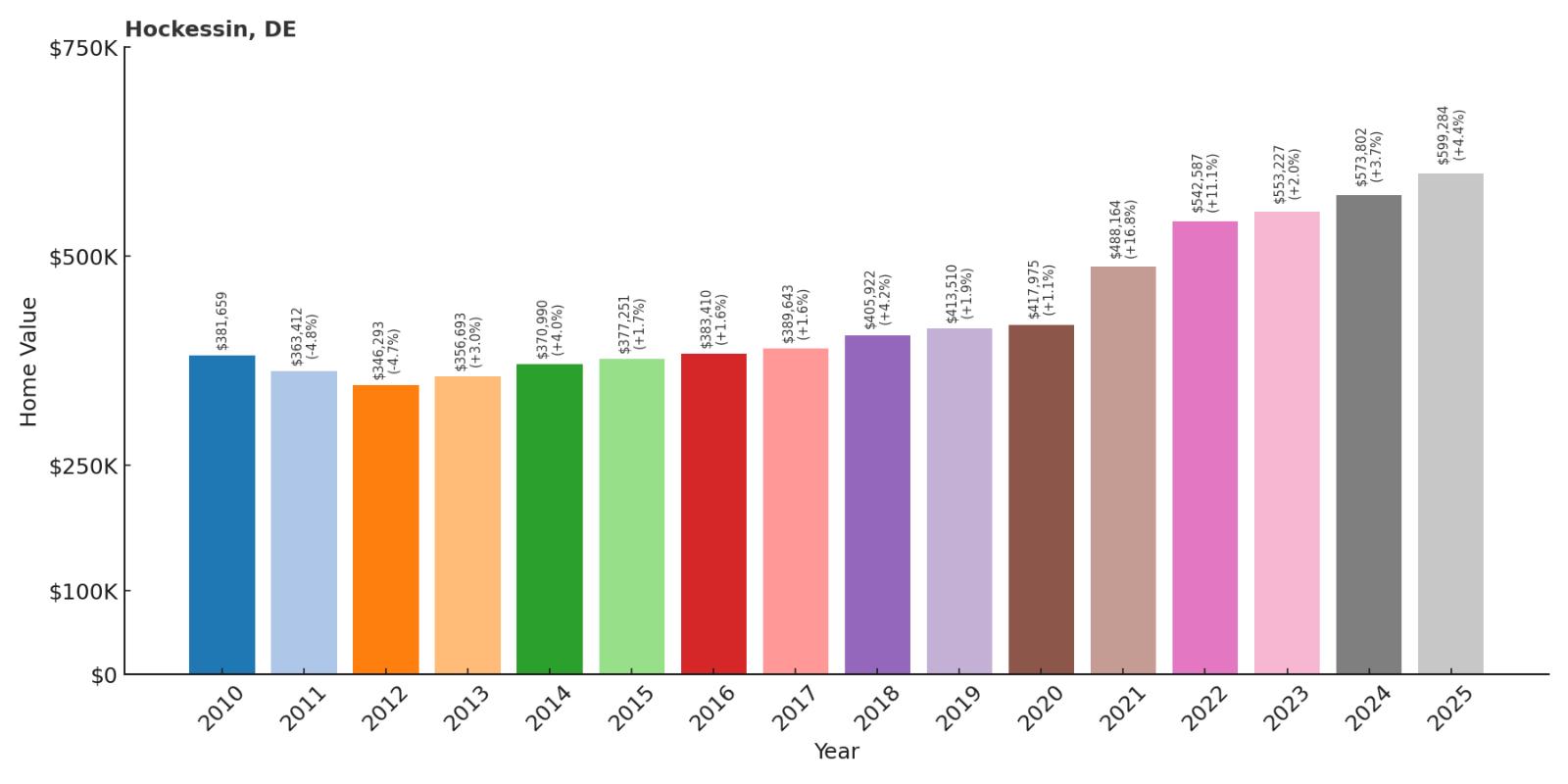
- 2010: $381,659
- 2011: $363,412
- 2012: $346,293
- 2013: $356,693
- 2014: $370,990
- 2015: $377,251
- 2016: $383,410
- 2017: $389,643
- 2018: $405,922
- 2019: $413,510
- 2020: $417,975
- 2021: $488,164
- 2022: $542,587
- 2023: $553,227
- 2024: $573,802
- 2025: $599,284
Hockessin has gained 57% in value since 2010, with steady appreciation accelerating during the pandemic years. The community experienced strong growth from 2020-2025, with values increasing over 43% in just five years. Current median prices of $599,284 reflect Hockessin’s status as one of northern Delaware’s most prestigious suburban communities.
Why Hockessin?
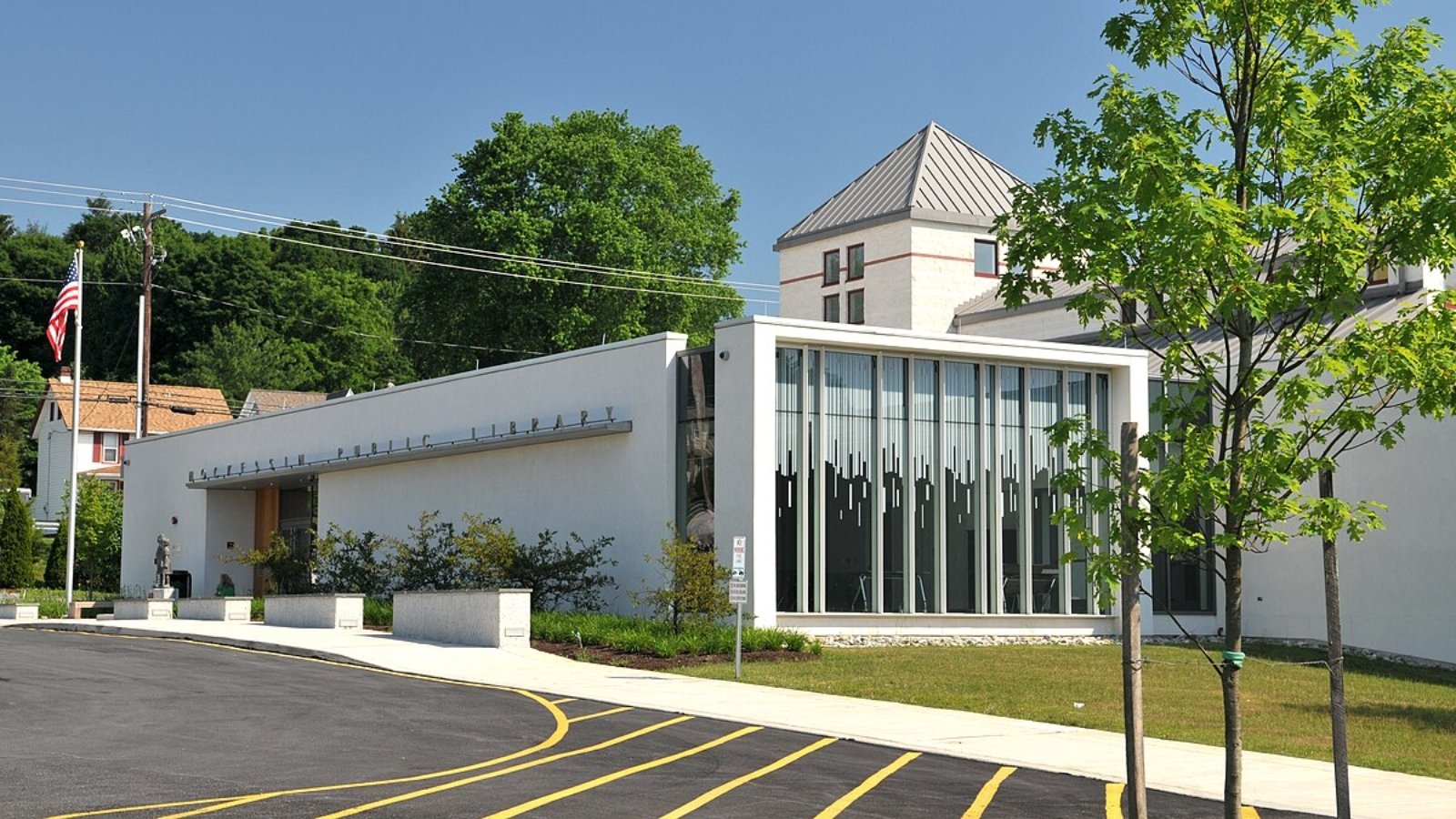
Why are people willing to pay so much to live here? What’s special about it?
Hockessin attracts affluent professionals seeking upscale suburban living with excellent schools and proximity to Wilmington. The community offers large homes on spacious lots, top-rated schools, and a country club atmosphere while maintaining convenient access to major employment centers. Residents value the high-quality neighborhoods, strong property values, and sophisticated suburban amenities that create an exclusive residential environment.
The area’s location near the Pennsylvania border provides easy access to Philadelphia and Baltimore employment markets while offering lower taxes and less congestion than similar communities in neighboring states. Hockessin has attracted executives and professionals seeking luxury suburban living with convenient commuting options.
How Hockessin Rose to Prominence
Hockessin was settled in the late 1600s by Quaker families who established farms and mills along Mill Creek. The community’s name derives from the Lenape word “hoccsissun,” meaning “place where there is good bark,” referring to trees suitable for canoe construction.
The area’s prominence as an upscale suburban destination emerged during the post-World War II era as Wilmington executives sought country living with city access. Hockessin’s combination of historic character, large lots, excellent schools, and proximity to major employment centers made it one of Delaware’s most prestigious residential communities.
3 Interesting Tidbits
1. Quaker Heritage – The Hockessin Friends Meetinghouse, built in 1738, still serves the community and reflects the area’s deep Quaker roots.
2. Country Estate Living – Many Hockessin properties feature horse facilities and large lots that maintain the area’s rural estate character despite suburban development.
3. Educational Excellence – The community is served by some of Delaware’s highest-rated schools, making it particularly attractive to families with school-age children.
6. Lewes – 70% Home Price Increase Since 2010
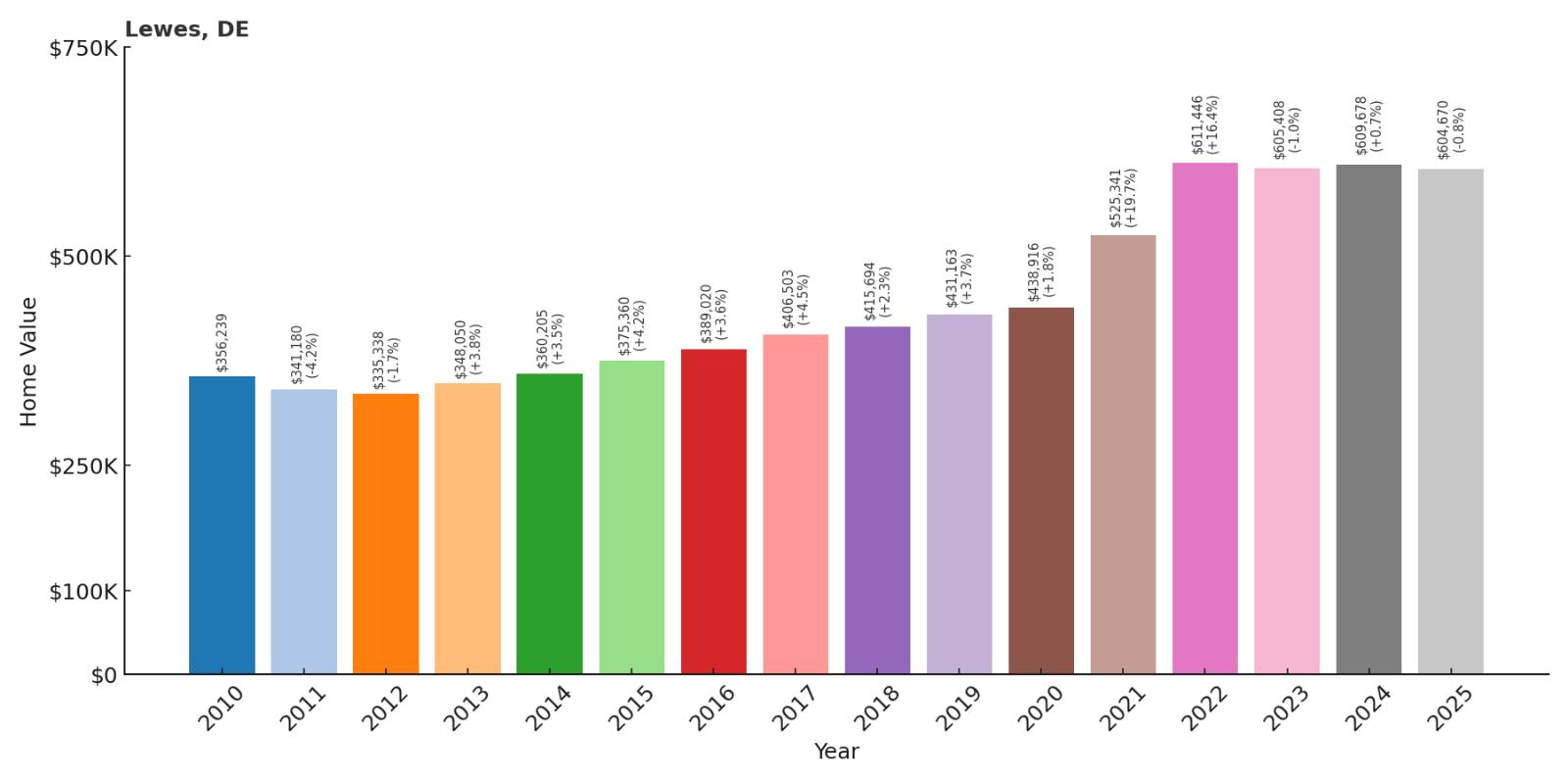
- 2010: $356,239
- 2011: $341,180
- 2012: $335,338
- 2013: $348,050
- 2014: $360,205
- 2015: $375,360
- 2016: $389,020
- 2017: $406,503
- 2018: $415,694
- 2019: $431,163
- 2020: $438,916
- 2021: $525,341
- 2022: $611,446
- 2023: $605,408
- 2024: $609,678
- 2025: $604,670
Lewes has gained 70% in value since 2010, with particularly strong appreciation during the pandemic era. The historic coastal town experienced dramatic growth from 2020-2022, with values increasing over 39% in just three years. Current median prices of $604,670 reflect Lewes’ status as one of Delaware’s most desirable historic coastal communities.
Why Lewes?

Why are people willing to pay so much to live here? What’s special about it?
Lewes offers an unparalleled combination of historic charm, natural beauty, and modern amenities that creates one of the most desirable coastal living experiences on the East Coast. The town features a beautifully preserved historic district, excellent restaurants, unique shops, and access to both Delaware Bay and Atlantic beaches. Residents enjoy year-round cultural events, art galleries, and a sophisticated community atmosphere that maintains its authenticity despite tourism pressures.
The community’s location at the mouth of Delaware Bay provides spectacular water views, excellent fishing, and convenient ferry access to Cape May, New Jersey. Lewes has successfully preserved its historic character while offering modern conveniences that appeal to discerning buyers seeking authentic coastal living.
How Lewes Rose to Prominence
Lewes was founded in 1631 by Dutch colonists, making it one of the oldest European settlements in Delaware and earning it the nickname “The First Town in The First State.” The town served as an important port and pilot station throughout the colonial and early American periods, guiding ships safely into Delaware Bay.
The community’s modern prominence as a premier residential and tourist destination emerged as historic preservation efforts in the mid-20th century restored and protected its colonial architecture. Lewes’ combination of authentic history, natural beauty, and sophisticated amenities made it increasingly attractive to affluent retirees and second-home buyers.
3 Interesting Tidbits
1. First Town – Lewes claims the distinction of being Delaware’s first European settlement, founded by Dutch colonists in 1631.
2. Historic District – The entire downtown area is listed on the National Register of Historic Places, with buildings dating back to the 1600s and 1700s.
3. Cape Henlopen Connection – The town serves as the gateway to Cape Henlopen State Park, offering pristine beaches and the historic Fort Miles World War II installation.
5. Rehoboth Beach – 77% Home Price Increase Since 2010
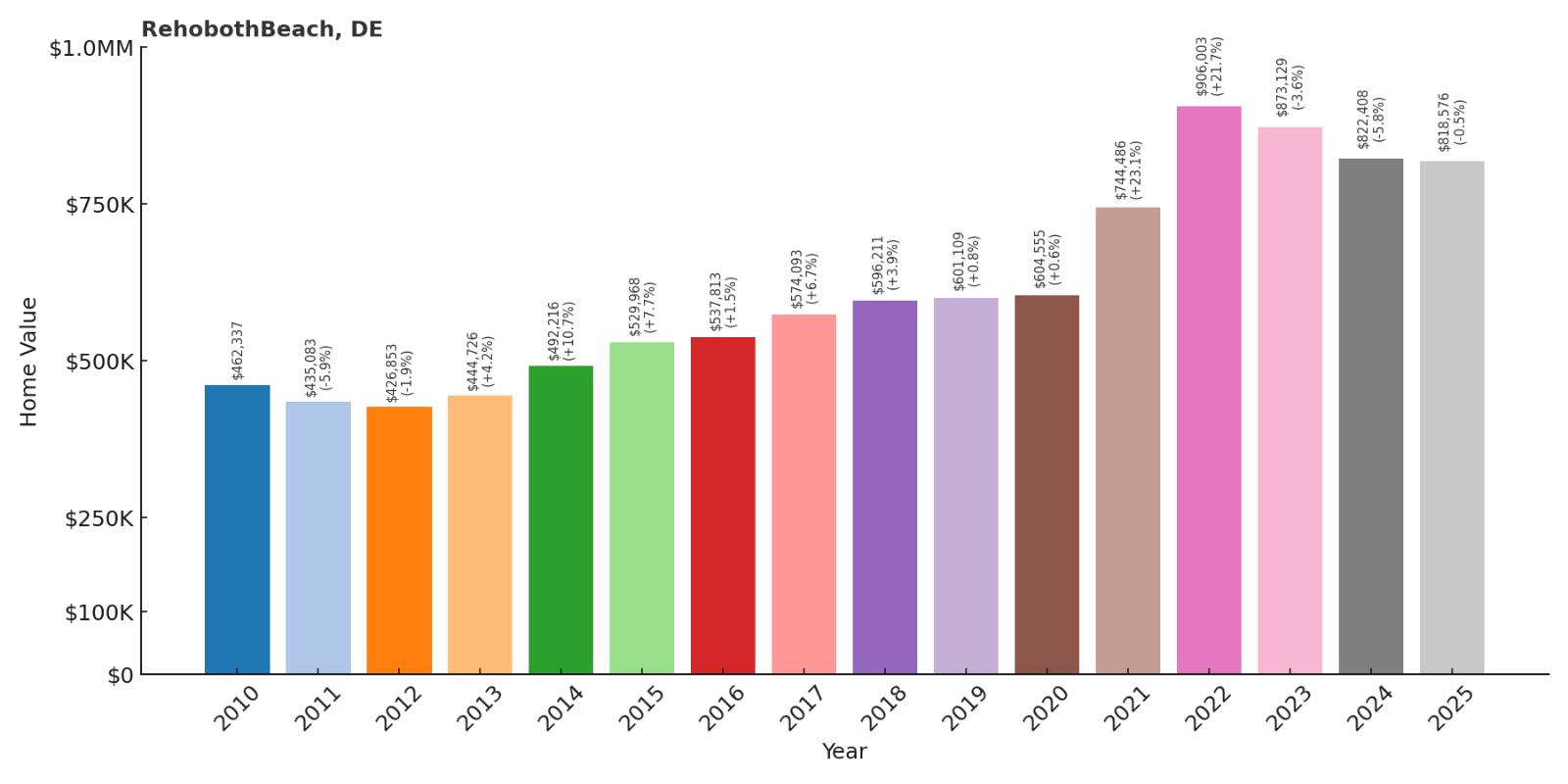
- 2010: $462,337
- 2011: $435,083
- 2012: $426,853
- 2013: $444,726
- 2014: $492,216
- 2015: $529,968
- 2016: $537,813
- 2017: $574,093
- 2018: $596,211
- 2019: $601,109
- 2020: $604,555
- 2021: $744,486
- 2022: $906,003
- 2023: $873,129
- 2024: $822,408
- 2025: $818,576
Rehoboth Beach has gained 77% in value since 2010, with explosive growth during the pandemic era. The famous resort town experienced dramatic appreciation from 2020-2022, with values increasing over 50% in just three years. Current median prices of $818,576 reflect Rehoboth’s position as Delaware’s premier beach destination and one of the East Coast’s most valuable resort markets.
Why Rehoboth Beach?
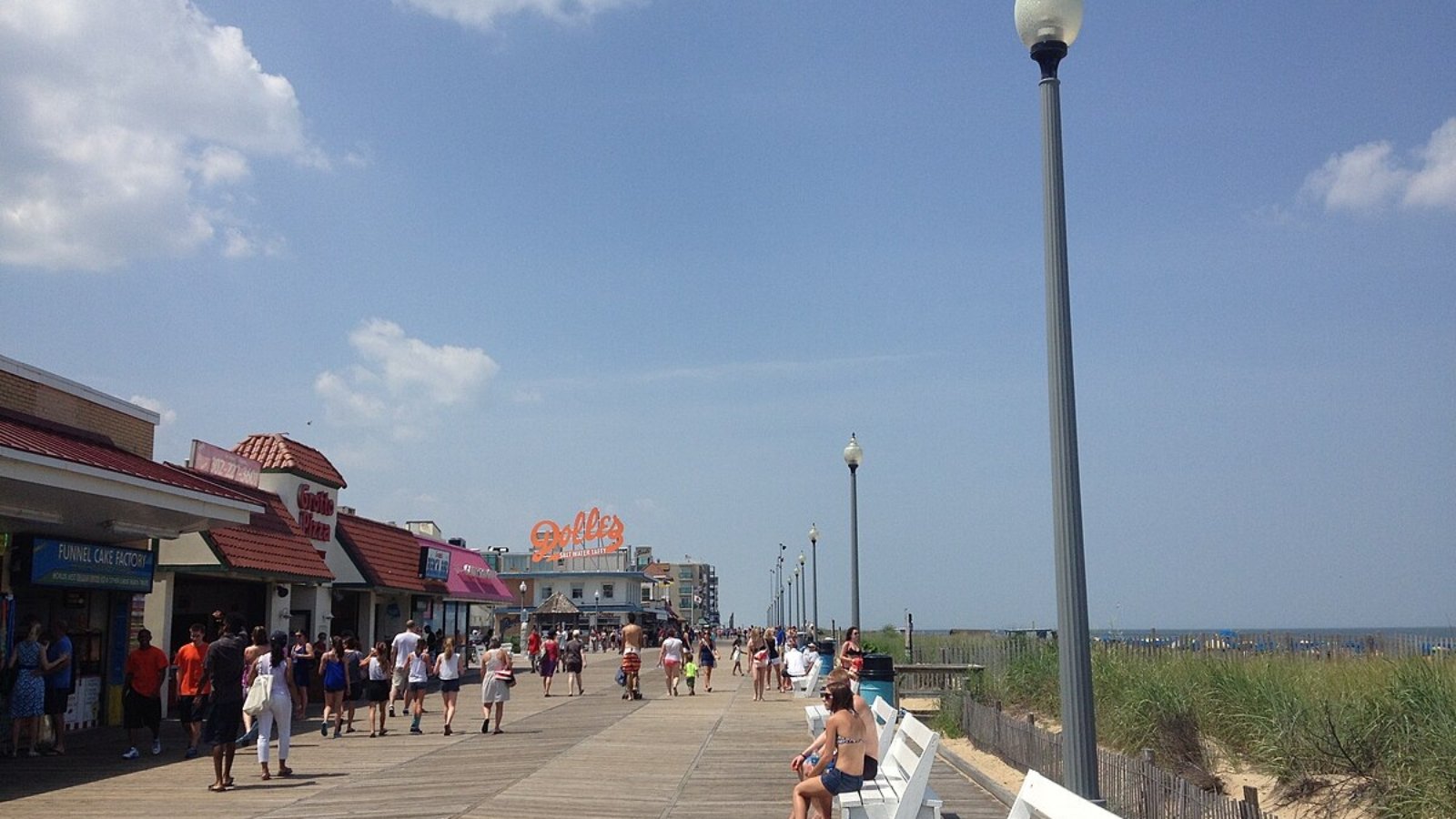
Why are people willing to pay so much to live here? What’s special about it?
Rehoboth Beach represents the pinnacle of East Coast beach living with its iconic mile-long boardwalk, pristine sandy beaches, and vibrant year-round community. The town offers world-class dining, unique shopping, and cultural events while maintaining the authentic beach town character that has attracted visitors for over a century. Residents enjoy walking to beaches, restaurants, and entertainment while being part of a sophisticated community that balances tourist appeal with local livability.
The community’s reputation as “The Nation’s Summer Capital” stems from its proximity to Washington, D.C., and its ability to offer luxury beach living with big-city amenities. Rehoboth has successfully maintained its charm while evolving into a year-round destination that attracts affluent residents seeking the ultimate coastal lifestyle.
How Rehoboth Beach Rose to Prominence
Rehoboth Beach was founded in 1873 by Methodist ministers as a religious seaside retreat called the Rehoboth Beach Camp Meeting Association. The name “Rehoboth” comes from the Bible, meaning “room” or “broad places,” reflecting the founders’ vision of a spacious spiritual retreat by the sea.
The town’s transformation from religious retreat to premier resort destination began in the early 1900s as it attracted visitors from Washington, Baltimore, and Philadelphia. Rehoboth’s combination of excellent beaches, convenient rail access, and growing amenities established it as one of the mid-Atlantic’s premier summer destinations, earning its nickname as “The Nation’s Summer Capital.”
3 Interesting Tidbits
1. Methodist Origins – The town was founded as a religious retreat by Methodist ministers, with the original tabernacle building still standing as a reminder of these spiritual roots.
2. Boardwalk Legacy – The famous Rehoboth boardwalk, built in 1930, stretches for one mile and features the iconic Dolle’s saltwater taffy and Funland amusement park.
3. Presidential Visits – Multiple U.S. presidents have vacationed in Rehoboth, cementing its reputation as a sophisticated and secure destination for high-profile visitors.
4. Bethany Beach – 28% Home Price Increase Since 2010
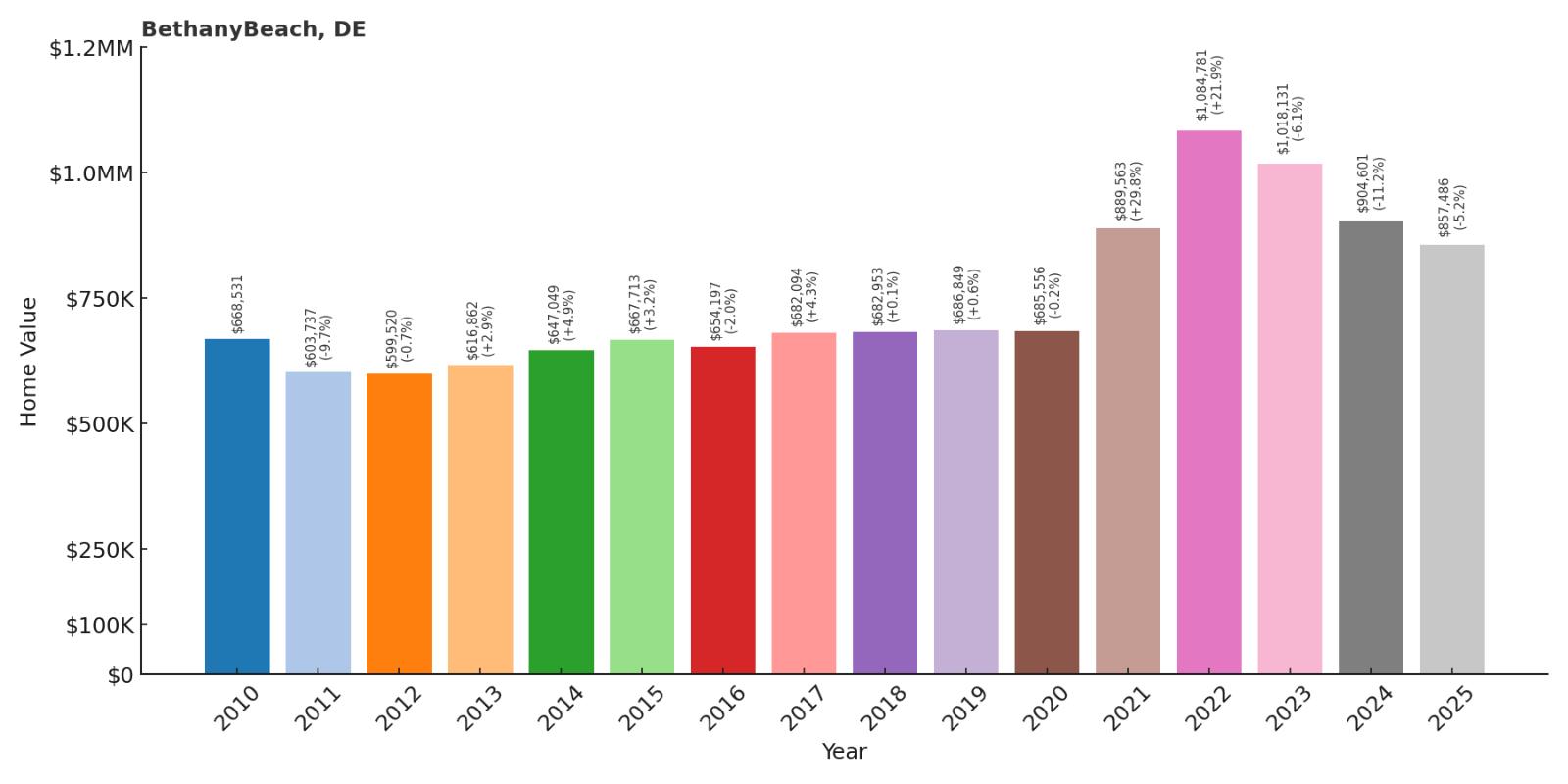
- 2010: $668,531
- 2011: $603,737
- 2012: $599,520
- 2013: $616,862
- 2014: $647,049
- 2015: $667,713
- 2016: $654,197
- 2017: $682,094
- 2018: $682,953
- 2019: $686,849
- 2020: $685,556
- 2021: $889,563
- 2022: $1,084,781
- 2023: $1,018,131
- 2024: $904,601
- 2025: $857,486
Bethany Beach has gained 28% in value since 2010, with explosive growth during the pandemic years despite the modest overall increase. The quiet resort town experienced dramatic appreciation from 2020-2022, with values increasing over 58% in just three years before moderating. Current median prices of $857,486 reflect Bethany’s status as one of Delaware’s most exclusive and family-oriented beach communities.
Why Bethany Beach?

Why are people willing to pay so much to live here? What’s special about it?
Bethany Beach offers the perfect family-oriented beach experience with its quiet, clean beaches and strong community atmosphere. Known as “The Quiet Resort,” the town provides a more relaxed alternative to busier beach destinations while maintaining excellent amenities including unique shops, quality restaurants, and the iconic Bethany Beach Boardwalk. Families value the safe environment, multi-generational beach house traditions, and the town’s commitment to preserving its small-town character.
The community’s emphasis on family values and environmental preservation creates a unique beach destination that attracts multi-generational ownership and long-term residents. Bethany Beach has successfully balanced tourism with livability, creating a genuine community atmosphere that sets it apart from more commercialized beach towns.
How Bethany Beach Rose to Prominence
Bethany Beach was founded in 1901 by the Christian Missionary Alliance as a religious seaside retreat called Bethany Beach Camp. The name “Bethany” refers to the biblical town where Jesus visited Mary, Martha, and Lazarus, reflecting the community’s spiritual foundations.
The town’s evolution from religious retreat to family-oriented resort began in the 1920s as it attracted families from the mid-Atlantic region seeking a quieter alternative to more crowded beach destinations. Bethany’s commitment to maintaining its family-friendly character and environmental quality established it as one of Delaware’s most prestigious beach communities.
3 Interesting Tidbits
1. Quiet Resort – Bethany Beach proudly maintains its designation as “The Quiet Resort,” with ordinances that preserve the peaceful atmosphere families seek.
2. Totem Pole Landmark – The famous Bethany Beach totem pole, erected in 1976, has become an iconic symbol of the town and a popular gathering spot for visitors.
3. Sea Colony Connection – The nearby Sea Colony resort community adds to Bethany’s appeal with its oceanfront condominiums and extensive recreational facilities.
3. Fenwick Island – 89% Home Price Increase Since 2010
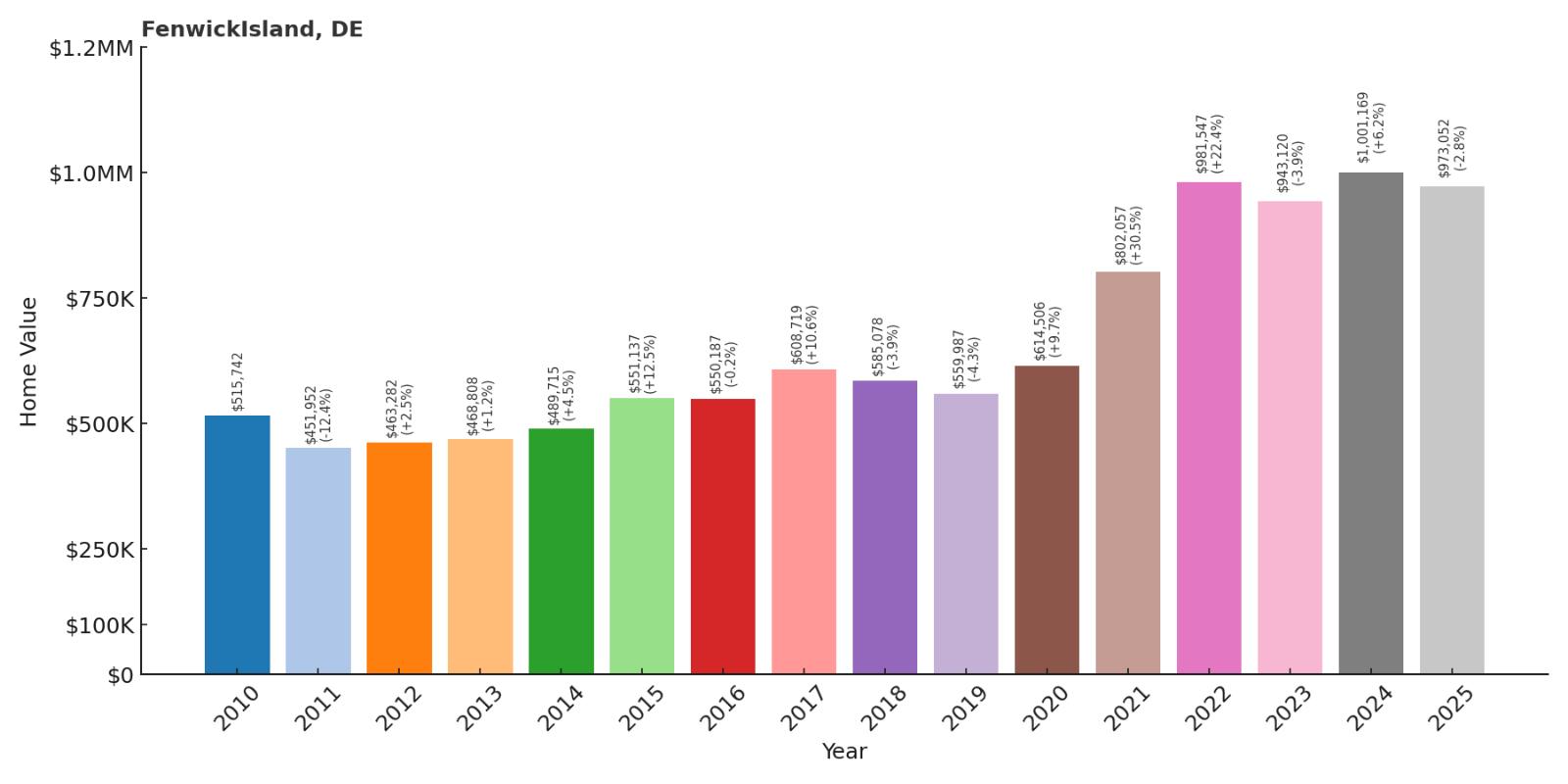
- 2010: $515,742
- 2011: $451,952
- 2012: $463,282
- 2013: $468,808
- 2014: $489,715
- 2015: $551,137
- 2016: $550,187
- 2017: $608,719
- 2018: $585,078
- 2019: $559,987
- 2020: $614,506
- 2021: $802,057
- 2022: $981,547
- 2023: $943,120
- 2024: $1,001,169
- 2025: $973,052
Fenwick Island has gained 89% in value since 2010, with explosive growth during the pandemic era. The exclusive beach community experienced dramatic appreciation from 2020-2022, with values increasing over 60% in just three years. Current median prices of $973,052 reflect Fenwick Island’s status as one of Delaware’s most expensive and exclusive coastal communities.
Why Fenwick Island?
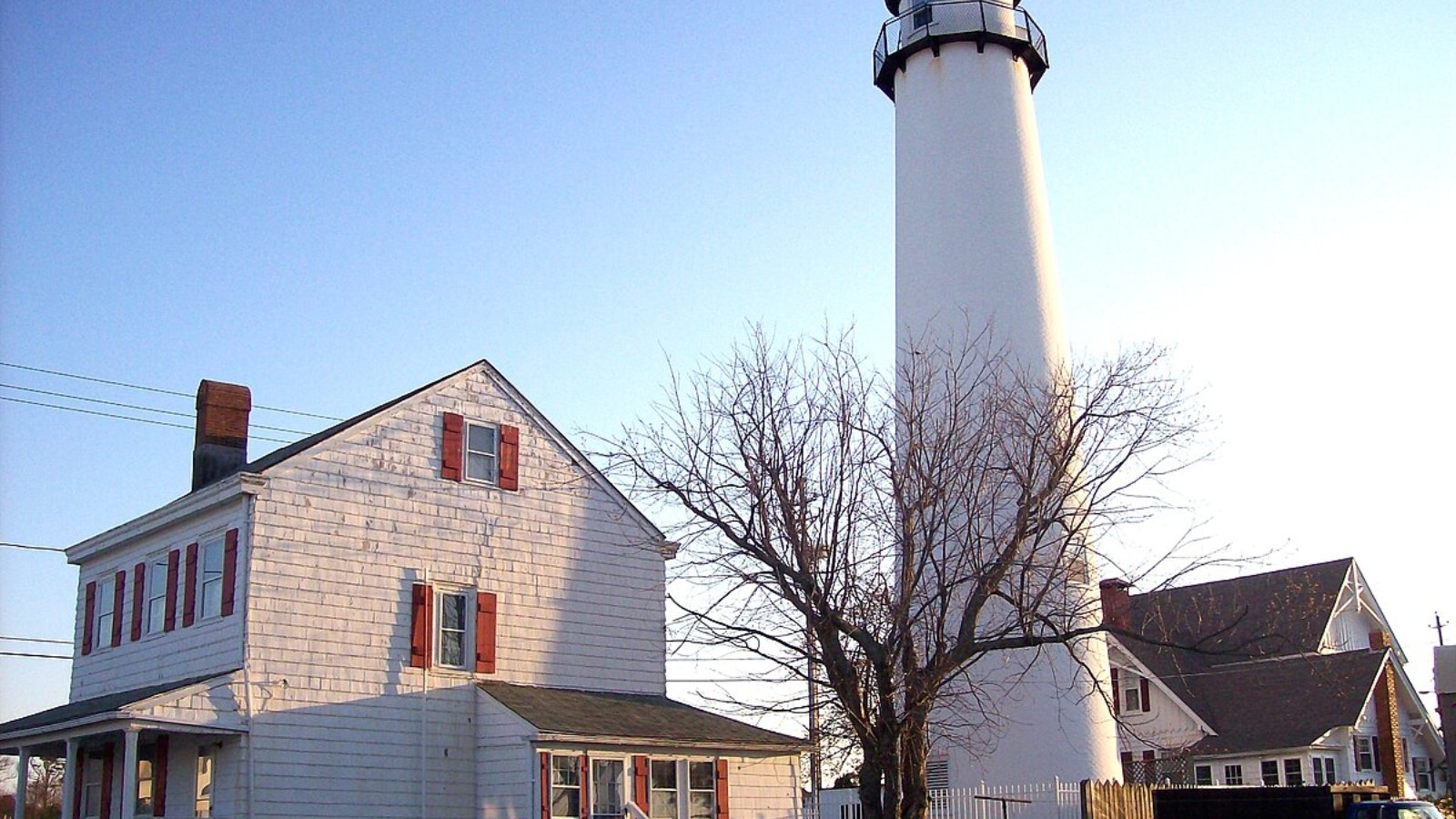
Why are people willing to pay so much to live here? What’s special about it?
Fenwick Island offers the ultimate in exclusive beach living with pristine sandy beaches, upscale homes, and a sophisticated community atmosphere. Located on the Delaware-Maryland border, the town provides a quieter, more refined alternative to busier beach destinations while maintaining easy access to Ocean City’s entertainment and dining. Residents enjoy private beach access, luxury amenities, and a tight-knit community of affluent neighbors who value privacy and quality.
The community’s small size and exclusive character create an intimate beach experience that appeals to wealthy families and retirees seeking sophisticated coastal living. Fenwick Island has successfully maintained its upscale residential character while providing convenient access to regional attractions and amenities.
How Fenwick Island Rose to Prominence
Fenwick Island was named after Thomas Fenwick, who received a land grant from William Penn in 1682. The island remained largely undeveloped until the mid-20th century when it began attracting wealthy families from Baltimore, Washington, and Philadelphia seeking exclusive beach retreats.
The community’s prominence as a luxury destination emerged as coastal development transformed it from a remote barrier island into one of the most exclusive beach communities on the East Coast. Fenwick Island’s combination of pristine beaches, limited development, and proximity to Ocean City made it increasingly attractive to affluent buyers seeking sophisticated coastal living.
3 Interesting Tidbits
1. Border Location – Fenwick Island sits directly on the Delaware-Maryland state line, with some properties technically located in both states.
2. Lighthouse Legacy – The historic Fenwick Island Lighthouse, built in 1858, serves as a landmark and reminder of the area’s maritime heritage.
3. Exclusive Development – The town has maintained strict development controls that preserve its upscale character and prevent over-commercialization.
2. Dewey Beach – 47% Home Price Increase Since 2010
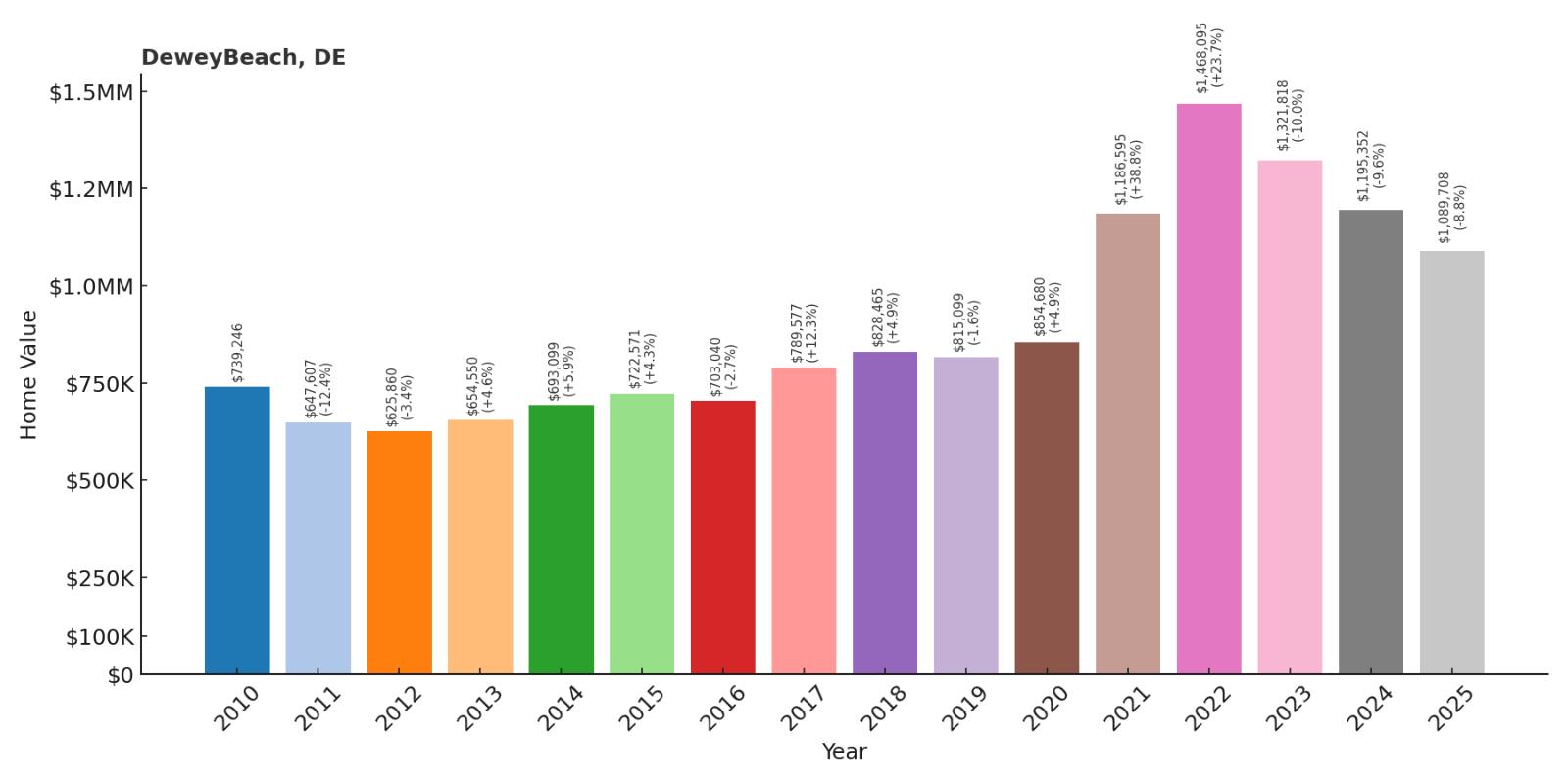
- 2010: $739,246
- 2011: $647,607
- 2012: $625,860
- 2013: $654,550
- 2014: $693,099
- 2015: $722,571
- 2016: $703,040
- 2017: $789,577
- 2018: $828,465
- 2019: $815,099
- 2020: $854,680
- 2021: $1,186,595
- 2022: $1,468,095
- 2023: $1,321,818
- 2024: $1,195,352
- 2025: $1,089,708
Dewey Beach has gained 47% in value since 2010, with explosive growth during the pandemic era despite the modest overall increase. The vibrant beach town experienced dramatic appreciation from 2020-2022, with values increasing over 72% in just three years before moderating. Current median prices of $1,089,708 reflect Dewey Beach’s status as Delaware’s second most expensive community and premier party destination.
Why Dewey Beach?
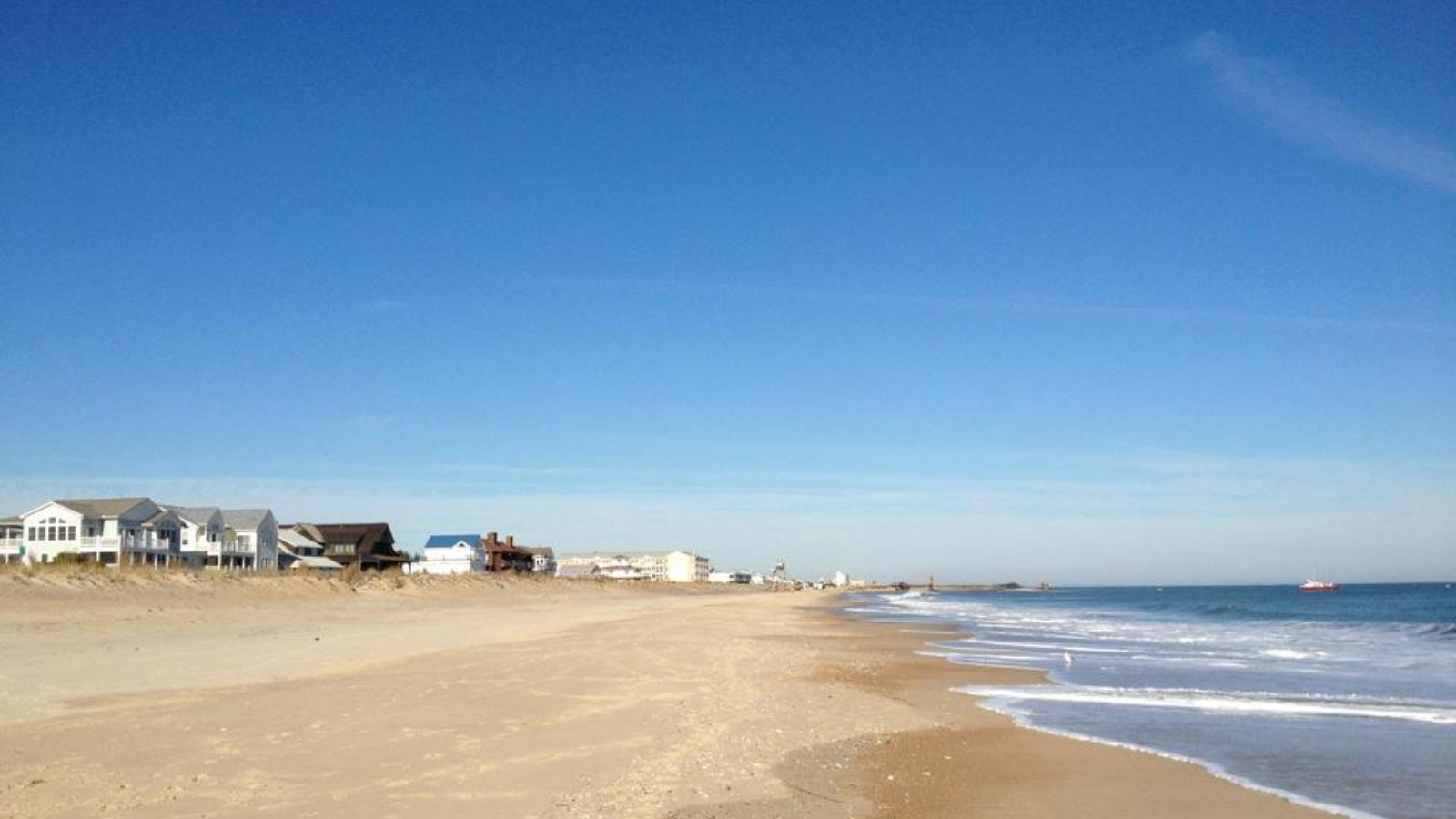
Why are people willing to pay so much to live here? What’s special about it?
Dewey Beach offers an unparalleled combination of beach living and vibrant nightlife that attracts affluent young professionals and entertainment-seeking retirees. The mile-long stretch between the Atlantic Ocean and Rehoboth Bay provides both ocean and bay access, while the town’s legendary nightlife scene creates a unique party atmosphere. Residents enjoy walkable access to numerous bars, restaurants, and entertainment venues while maintaining luxury beach living in one of the most energetic coastal communities on the East Coast.
The community’s compact size and dual water access create an exclusive island-like feeling that appeals to those seeking both luxury and excitement. Dewey Beach has successfully maintained its reputation as a premier party destination while attracting serious real estate investment from buyers who value the town’s unique energy and waterfront lifestyle.
How Dewey Beach Rose to Prominence
Dewey Beach was named after Admiral George Dewey, hero of the Spanish-American War, and developed as a beach resort in the early 1900s. The town’s location on a narrow strip between the Atlantic Ocean and Rehoboth Bay created unique geographical advantages that attracted early developers and visitors.
The community’s prominence as a party destination emerged in the latter half of the 20th century as it attracted young professionals from Washington, Baltimore, and Philadelphia seeking vibrant nightlife with beach access. Dewey’s combination of luxury real estate and entertainment options established it as one of the most expensive and exclusive party towns on the East Coast.
3 Interesting Tidbits
1. Admiral’s Namesake – The town was named after Admiral George Dewey, famous for his victory at the Battle of Manila Bay during the Spanish-American War.
2. Dual Waters – Dewey Beach is one of the few places where you can watch the sunrise over the Atlantic Ocean and sunset over Rehoboth Bay from the same location.
3. Nightlife Capital – The town hosts some of the East Coast’s most popular beach bars and nightclubs, creating a unique party atmosphere that commands premium real estate prices.
1. South Bethany – 59% Home Price Increase Since 2010
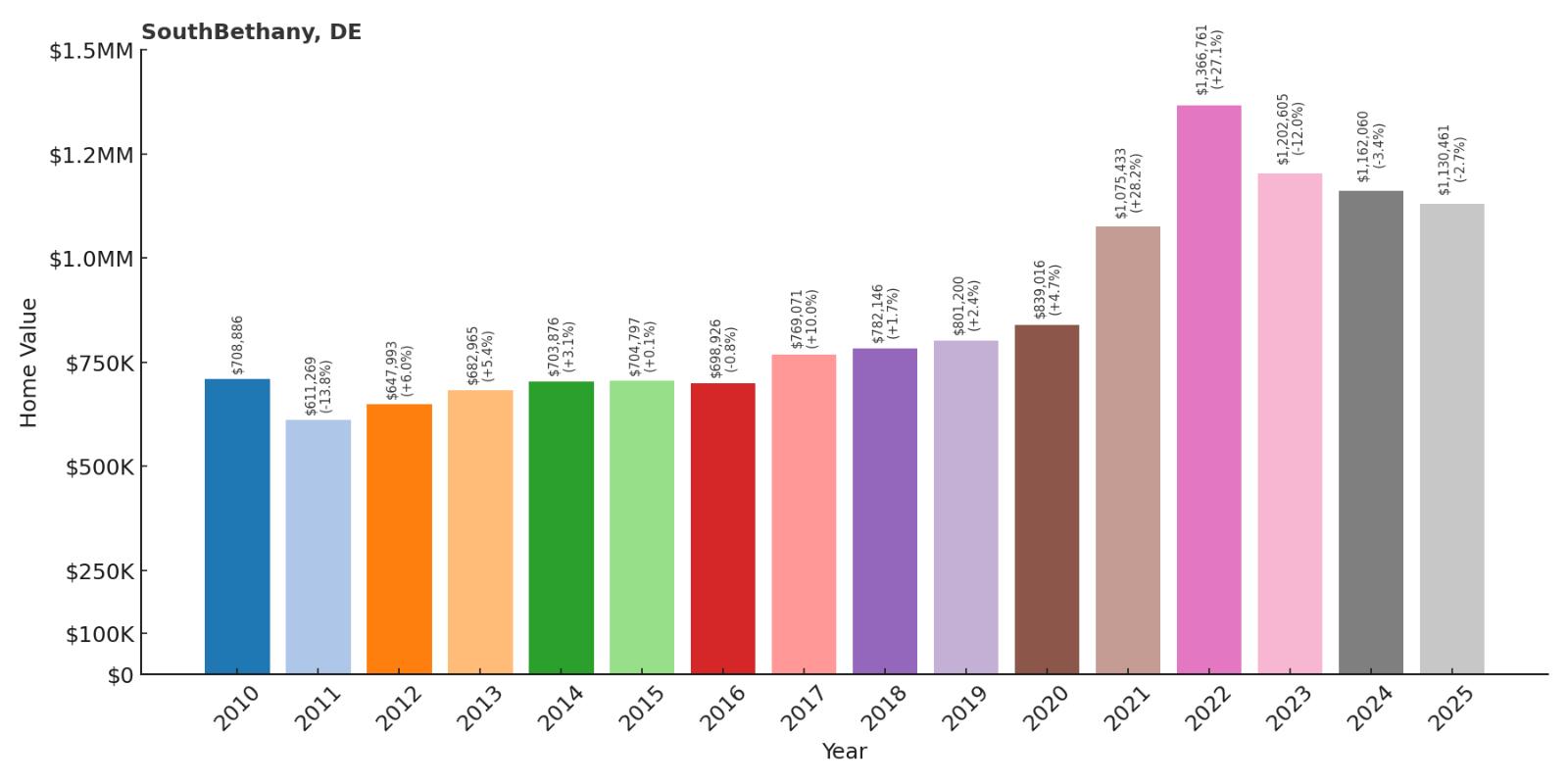
- 2010: $708,886
- 2011: $611,269
- 2012: $647,993
- 2013: $682,965
- 2014: $703,876
- 2015: $704,797
- 2016: $698,926
- 2017: $769,071
- 2018: $782,146
- 2019: $801,200
- 2020: $839,016
- 2021: $1,075,433
- 2022: $1,366,761
- 2023: $1,202,605
- 2024: $1,162,060
- 2025: $1,130,461
South Bethany has gained 59% in value since 2010, with explosive growth during the pandemic era despite the modest overall increase. Delaware’s most expensive community experienced dramatic appreciation from 2020-2022, with values increasing over 63% in just three years before moderating. Current median prices of $1,130,461 reflect South Bethany’s position as the state’s premier residential community and most exclusive beach destination.
Why South Bethany?
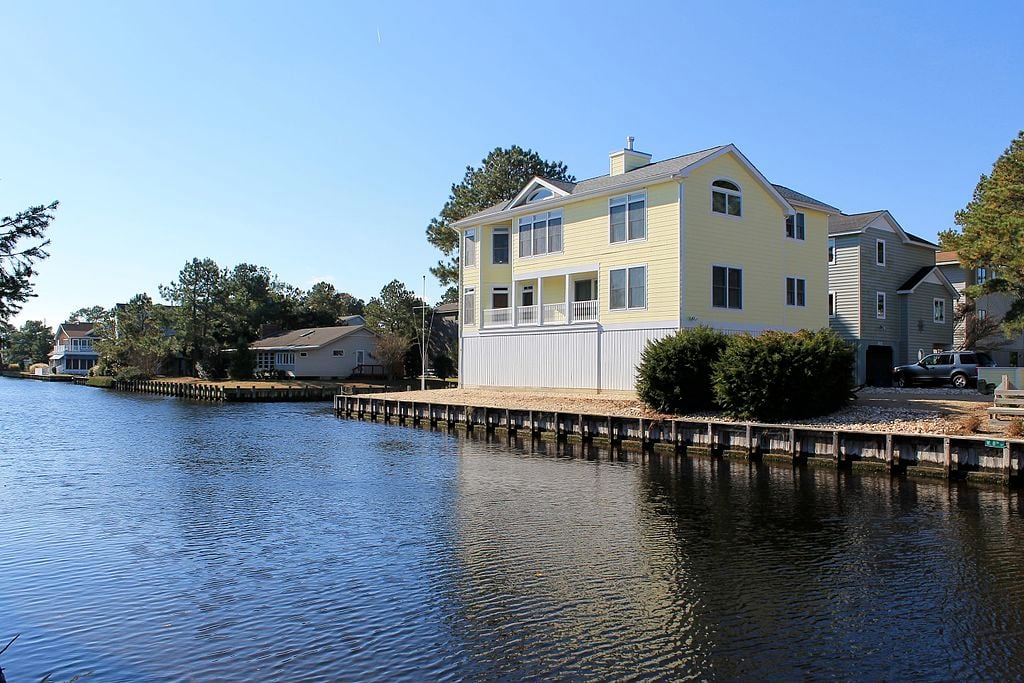
Why are people willing to pay so much to live here? What’s special about it?
South Bethany represents the absolute pinnacle of Delaware coastal living with its exclusive residential community, pristine beaches, and unparalleled natural beauty. The town offers luxury beachfront living with both Atlantic Ocean and Indian River Bay access, creating unique waterfront opportunities unavailable elsewhere in Delaware. Residents enjoy the most prestigious address in the state, with large custom homes, private beach access, and a tight-knit community of affluent neighbors who value privacy, quality, and environmental preservation.
The community’s commitment to maintaining its residential character and environmental quality creates an exclusive retreat atmosphere that appeals to the most discerning buyers. South Bethany has successfully preserved its natural beauty while providing the luxury amenities and sophisticated lifestyle that justify its position as Delaware’s most expensive residential market.
How South Bethany Rose to Prominence
South Bethany was incorporated in 1954 as a planned residential community designed to offer luxury beach living with environmental preservation. The town was developed with strict building codes and environmental protections that ensured high-quality construction and preservation of the natural dune and bay systems.
The community’s prominence as Delaware’s premier residential address emerged through careful planning that balanced luxury development with environmental stewardship. South Bethany’s combination of pristine natural beauty, exclusive community atmosphere, and proximity to other coastal attractions established it as the most coveted address in Delaware.
3 Interesting Tidbits
1. Dual Coastal Access – South Bethany is one of the few communities offering residents access to both Atlantic Ocean beaches and Indian River Bay waterfront on the same property.
2. Environmental Pioneer – The town was among the first Delaware communities to implement comprehensive environmental protections for dunes, wetlands, and bay systems.
3. Exclusive Governance – South Bethany maintains some of the strictest building codes and architectural standards in Delaware, ensuring the community’s upscale character and property values.



